

Leadership Lesson Plans for Students ages 12-18
Leadership lesson plans for teens designed by our expert youth leadership facilitators to help middle school and high school students understand their leadership potential, identify their passions and values, learn communication and teamwork skills, and make a difference in their community.
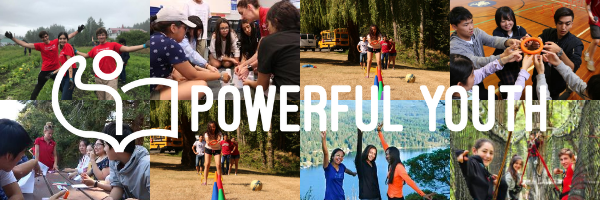
Kickstart your group’s leadership journey with our unique lesson guides and teaching materials
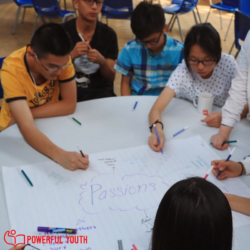
Each lesson plan involves multiple group activities, individual reflections, and group reflections, and the accompanying leadership lesson guides and resources include everything you need as a facilitator. You can deliver an engaging leadership program in your own school in less than 1.5 hours, or all three lessons as a one-day leadership workshop! All lesson plans and accompanying presentations are in English, but the accompanying lesson guides are designed to also be beneficial for facilitators delivering the program without access to a screen or projector, or delivering it in another language.
By increasing youth’s capacity to understand their strengths as a leader, follow their unique passions and values to make a difference, and be good collaborators and communicators, you are contributing to our vision of “a global community of powerful youth, passionate about service, and equipped with the tools to create profoundly positive global change.”
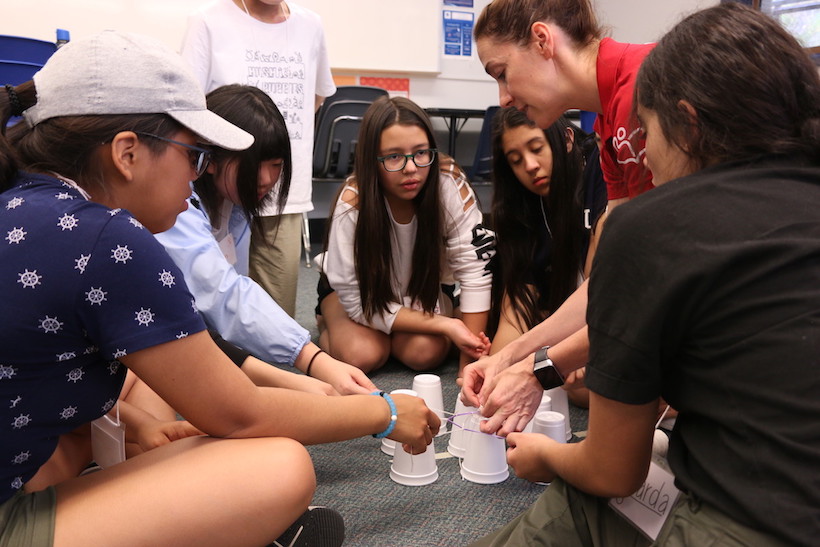
Learn more about our three unique leadership lesson plans
- Lesson I: Leadership 101
- Lesson II: Passions to Actions
- Lesson III: Communication & Collaboration
The Leadership 101 leadership lesson plan for high school students (youth ages 14-18) provides an introduction to core leadership theory through unique individual and group activities. Leadership is a journey… kickstart your group’s journey today!
The main questions the lesson plan will help youth answer are:
- Why do leadership skills matter?
- What are the qualities of a leader?
- What kind of leader am I?
Click here to receive the leadership lesson plans, teaching materials, and facilitator resources!
The Passions to Action lesson plan for youth ages 12-18 (middle school/high school) provides your group with an opportunity to identify their passions and values, and understand how to transform them into positive action and change in their community. Youth who are able to connect their passions and values with community action are powerful agents of positive change – we have seen this time and time again with the hundreds of participants of our Global Leadership Academies !
The main questions the passions and values lesson will help youth answer are:
- What are my passions and values?
- What issues spark action within me?
- How can I transform my passions and values into action?
The Communication & Collaboration lesson plan for teens ages 12-18 offers youth the chance to test their teamwork, collaboration, and communication skills in format designed for maximum learning and reflection! Working well in a team and being a good communicator are crucial skills for every leader, and this lesson plan targets soft skill development in these areas of leadership.
The main questions the communication and teamwork lesson will help youth answer are:
- What does effective teamwork and collaboration look like?
- What is my role in a team? What do I do well? What can I do better?
- Why are communication skills important?
If you have any questions about the program or how to facilitate these leadership lesson plans for your group, please feel free to contact us here . If you are looking instead for a custom 3-to-5 day leadership workshop in your school led by an experienced youth leadership facilitator, learn more about our custom leadership workshops here.
Using the power of experience-based learning, Powerful Youth is an award-winning social enterprise dedicated to providing the best leadership training for youth world wide, helping them uncover purpose, fueled by their passions, to create positive and lasting change in themselves and their communities.
Want to learn more about our leadership programs in Canada and the UK for international youth ages 12-18?
- Snap! Raise
- Early Access
- Snap! Insights
- Snap! Spend
- Snap! Store
- Snap! Connect
- Snap! Sponsor
- Snap! Manage
- Help Center
- Leading Edge Website
What are you looking for?
- Fundraising
- Spirit Wear
- Money Management
- Communications
5 Powerful TED Talks on Leadership for High School Programs
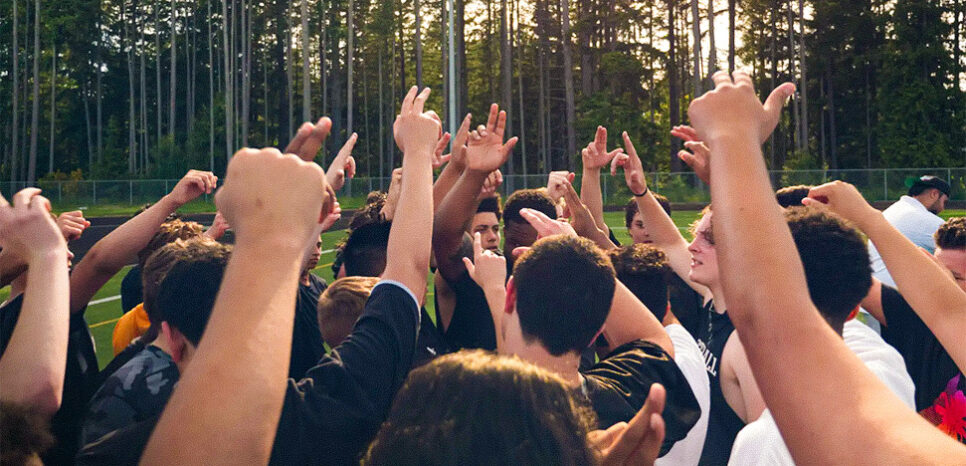
A collection of 5 powerful TED Talks on leadership to help group leaders better not only themselves, but their students as well.
- Demonstrating good leadership, especially for impressionable students, requires more than just an understanding of strategizing.
- To be a great leader, you have to understand what your students respond to, and know how to navigate turbulent times.
- School programs are always changing, so don’t be afraid to change your approach if a situation calls for it.
Being a great leader requires an assortment of skills and life experiences. For a great leader, a masterful example of leadership skills could mean being authoritative and in control one moment, to passionate and kind the next. Versatility, communication, and self-awareness are just a few leadership skills that aren’t talked about enough, despite being some of the most impactful.
To bridge this gap, there are many resources that leaders at all levels can use to improve their own leadership skills, like TED Talks on leadership. TED Talks have featured thoughtful presentations on a variety of topics from guest speakers like Bill Gates, Julian Treasure, and Robert Waldinger, but there are also plenty of TED Talks on leadership that offer different perspectives on what it means to be a leader.
Regardless of whether you’re trying to coach your football team to the playoffs, inspiring your robotics club before a competition, or preparing your art program for a big contest, we’ve collected five TED Talks on leadership that will offer you new insights and perhaps even spark a realization that leads to new heights.
Many of these leadership TED talks have mental health and mental conditioning as a throughline, which we believe can be an underrepresented aspect of leadership skills. That being said, they address different aspects of this and offer different solutions, all of which are worth mentioning.
1. Stoicism as a philosophy for an ordinary life | Massimo Pigliucci
Highlight: Focus on what you can control, then you’ll never be the subject nor the administrator of unjust criticism, which is the key to not only living a better life, but for making the world we inhabit a better place as well.
Stoicism is a school of philosophy that originated in ancient Greece, but its core principles have persisted for centuries, even inspiring some of the greatest leaders of the modern era like Nelson Mandela.
So, what is it? In short, stoicism revolves around the belief that, while we can’t control the world around us, we can control our responses to it. It stresses the importance of being in tune with the world around us—including other people.
Dr. Massimo Pigliucci states in his presentation that, “For the Stoics, it followed that the best kind of human life you can actually have is one in which you apply your reason, your intelligence, to improve social living, to improve everybody else’s life.”
Dr. Pigliucci notes that the core virtues of stoicism consist of living one’s life with justice, courage, and temperance—all tenets that, as leaders, you’d want to instill in your students. But one of the more “difficult” to incorporate aspects of stoicism is what Dr. Piglucci says a little later in his TED Talk:
“We should try to walk through life by internalizing our goals, not worry about the outcomes, because those are outside of our control, but worry about our intentions and our efforts, because those are very much under our control.”
Broadly speaking, our culture values winners and winning above all else, whether that be winning a state championship, getting a big “1st place” ribbon, or closing a major business deal. But especially at the lower levels, when working with students, it’s important to remind them that there is more to life than just wins and losses.
Dr. Pigliucci even uses a metaphor of an archer in a competition who, despite doing everything right, they miss the target, for one reason or another. “You do not attach your own self-esteem to the outcome; you only attach it to what is under your control, to your attempt. In practice, in today’s life, these can change the way you look at pretty much everything.”
Not only is this approach great for young students, but it can also help you as a leader keep everything in context and prevent you from being unnecessarily stressed. To paraphrase Dr. Pigliucci, if you control everything you can, then you’ll never be the subject nor the administrator of unjust criticism, which is the key to not only living a better life, but for making the world we inhabit a better place as well.
“The idea is to be not perfect but just better than you were yesterday, one little step at a time.”
2. Trial, error and the God complex | Tim Harford
Highlight: “I will admit it’s obvious when schools start teaching children that there are some problems that don’t have a correct answer. Stop giving them lists of questions, every single one of which has an answer.”
Next on our list of TED talks on leadership has probably the most eye-grabbing title and has equally head-turning stories and lessons to match. Here, economist Tim Harford tackles this idea of, “the God complex,” an absolutely overwhelming belief that you are infallibly right in your solution.
Generally speaking, such a belief could be harmful in any context. But, when you put it in this frame of a group leader overseeing a program made of students, the consequences can become that much worse.
“We tend to retreat and say, ‘We can draw a picture, we can post some graphs, we get it, we understand how this works.’ And we don’t. We never do.”
According to Harford, the best way we as people and a society can overcome problems is with humility, trial, and error. “And the moment you step back from the God complex – let’s just try to have a bunch of stuff; let’s have a systematic way of determining what’s working and what’s not – you can solve your problem.”
The world is ever changing, so if a particular part of your system isn’t working anymore, then as a leader you should be open to changing that part. Or, changing the whole system itself if you have to—having that versatility is an example of leadership skills that don’t get the attention they ought to.
Sure, this sounds obvious in theory, but as Harford points out, this is not the case in the American education system.
“I will admit it’s obvious when schools start teaching children that there are some problems that don’t have a correct answer. Stop giving them lists of questions, every single one of which has an answer. And there’s an authority figure in the corner, behind the teacher’s desk, who knows all the answers. And if you can’t find the answers, you must be lazy or stupid. When schools stop doing that all the time, I will admit that.”
To benefit both group leaders and students alike, Hartford says everyone should be open to trying new ideas, even if they don’t ultimately work. Throughout the talk, Hartford continually references Dr. Archie Cochrane’s experiences in the medical field as they relate to the point, and they’re some of the most interesting moments of any entry on this list of leadership TED talks.
Just these two talks alone could contain invaluable information for a group leader somewhere. To help make sure these TED talks on leadership are seen by the people who need them, share this article on social media; you never know what problems someone is facing.
3. The puzzle of motivation | Dan Pink
Highlight: In a largely white-collar society like the United States, usual rewards and incentives are no longer good motivators. Instead, instilling meaning and purpose into tasks will yield better results.
While motivating a group of people is one of the most well-known leadership skills, that’s always easier said than done. Sure, we can think of methods that might motivate a group but, as author and career analyst Dan Pink puts it, these ideas are actually more harmful than helpful.
The cause? Functional fixedness; a cognitive bias that doesn’t let us see new uses for old tools. Pink dives deeper into this issue and gives examples of how it occurs in our schools, our jobs, and in various other places around the world.
Mr. Dan Pink points out that while incentives (bonuses, commissions, etc.) sound like the answer, research has found that it’s just the opposite, that these incentives actually hinder people trying to overcome functional fixedness.
“What’s alarming here is that our business operating system – think of the set of assumptions and protocols beneath our businesses, how we motivate people, how we apply our human resources – it’s built entirely around these extrinsic motivators, around carrots and sticks. That’s actually fine for many kinds of 20th century tasks. But for 21st century tasks, that mechanistic, reward-and-punishment approach doesn’t work, often doesn’t work, and often does harm.”
In some cases, Pink says, this approach can work, but only for simple problems; not so much for more complex and open-ended ones.
“If-then rewards work really well for those sorts of tasks, where there is a simple set of rules and a clear destination to go to. Rewards, by their very nature, narrow our focus, concentrate the mind; that’s why they work in so many cases.”
To inspire and motivate students to not just complete a task in front of them, but also to become successful citizens in their adult lives, a new way of motivating students will be needed. Fortunately, Pink spends the last two-thirds of his presentation offering a solution.
“It’s built much more around intrinsic motivation. Around the desire to do things because they matter, because we like it, they’re interesting, or part of something important. And to my mind, that new operating system for our businesses revolves around three elements: autonomy, mastery and purpose.”
Mr. Dan Pink defines each of these elements for his audience, giving leaders a better understanding of how they can inspire their group to thrive and achieve more. For that, and the fact that Mr. Pink is quite an entertaining speaker, this absolutely deserves to be recognized as one of the better TED talks on leadership.
4. My secret to staying focused under pressure | Russell Wilson
Highlight: Mindfulness and setting aside your emotions are vital mental skills that can improve one’s performance in any field, not just sports. However, they require a high level of emotional maturity and self-awareness.
Any time you get to hear a Super Bowl champion’s thought process is always a treat; you get to see what makes them tick, what helped them get to where they are, and what they lean on in tough times. For Russell Wilson, it’s about staying neutral.
“I started thinking about a car. You know how when you drive a car, you’ve got [a] stick shift and you want to shift to neutral? You go from first gear to second gear, all the way to fifth? You’ve got to know how to shift to neutral. And I needed to shift to neutral immediately, before I crashed.”
The nine-time Pro Bowl-er says sharpening his mental skills is what helps him bounce back from any rough situation, and it’s this message that makes this entry one of the best TED talks on leadership. As Wilson himself says, athletes spend hours working on the physical and tactical aspects of the game, but not usually the mental, and this can be applied to programs of all natures.
As a leader, it’s important to remind yourself and your students that everything you do relies just as much on the mental aspect as the physical.
“One of the questions I always get asked about neutral thinking is this: ‘Does that mean I don’t have any emotion?’ And I always say, absolutely not. Yeah, we have emotions, we have real-life situations, we have things to deal with. But what you have to be able to do is to stay focused on the moment and to not be super emotional. It’s OK to have emotions, but don’t be emotional.”
Wilson’s lesson here reflects a level of emotional maturity that is typically not associated with students, so the more aware of this a program is , the more likely it is that that program will grow in a positive way.
5. How to stop languishing and start finding flow | Adam Grant
Highlight: As we collectively push through the COVID-19 pandemic, group leaders need to be aware of potential mental roadblocks for students who may not understand it themselves.
Last on our list of TED talks on leadership is also the most recent one! Released in September 2021, organizational psychologist Adam Grant talks about the impact that COVID-19 has had on our minds, and how we can overcome this “psychic malaise” that has seemingly permeated everywhere.
“I wasn’t depressed. I still had hope. Wasn’t burned out, had energy. Wasn’t lonely, I was with my family. I just felt a little bit aimless and a little bit joyless. Eventually, I remembered there’s a name for that feeling: Languishing. Languishing as a sense of emptiness, stagnation and ennui.”
With many states rolling back their pandemic restrictions, leaders will have to address similar effects in the coming months, perhaps even longer. “Going back to normal,” is a phrase that is thrown around, but what if that isn’t possible for some students? What if this feeling continues to linger?
“Two decades of research show that languishing can disrupt your focus and dampen your motivation. It’s also a risk factor for depression because languishing often lurks below the surface.“
Being able to recognize when a student is not feeling like themselves and helping them navigate through it are vital leadership skills, and will likely become more important as we continue to navigate life post-pandemic.
One tool to accomplish this? Flow.
“In the early days of the pandemic, researchers found that the best predictor of well-being was not optimism. It was flow. Flow is that feeling of being in the zone…It’s that state of total absorption in an activity. For you, it might be cooking or running or gardening where you lose track of time, and you might even lose your sense of self.”
By giving students something to focus on (something MEANINGFUL), they can find a purpose that perhaps they were missing before, which echoes the themes of all the other leadership TED talks listed above.
Dr. Grant shares anecdotes from his own life story and how he went about overcoming the languishing that had plagued him since 2020, which can help inspire leaders to do the same both for themselves and their students (and he does it with nice, consistent humor to boot).
All of these TED talks on Leadership cover important areas of leadership skills that may not always get the attention that they warrant. To help out other leaders (and even yourself), share this article with your peers and start the conversation. It could be just what you need.
- Snap! Mobile
- Life At Snap!
Latest Posts
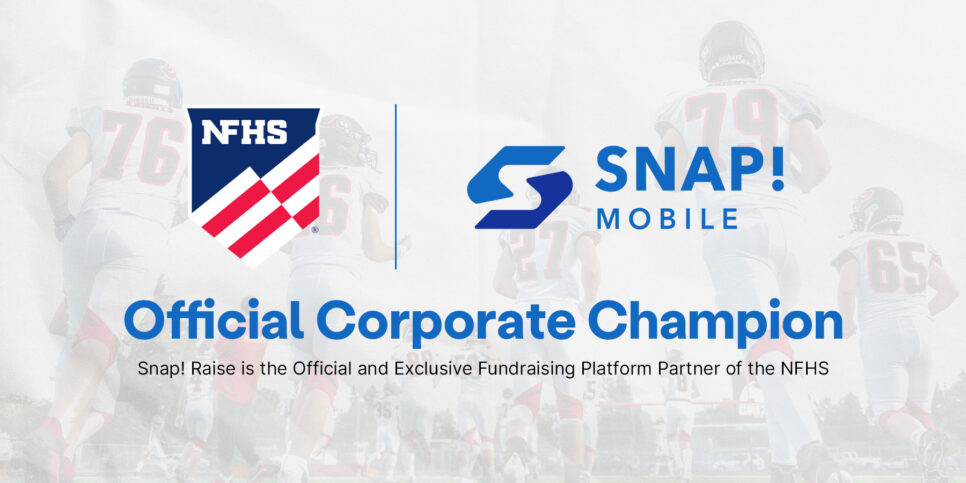
Related Articles
5 tips for athletic directors to get organized for back to school.

Setting the Tone for a Successful Season: Centralizing Information

Back to School for Athletics Directors: Sports Leadership and Management
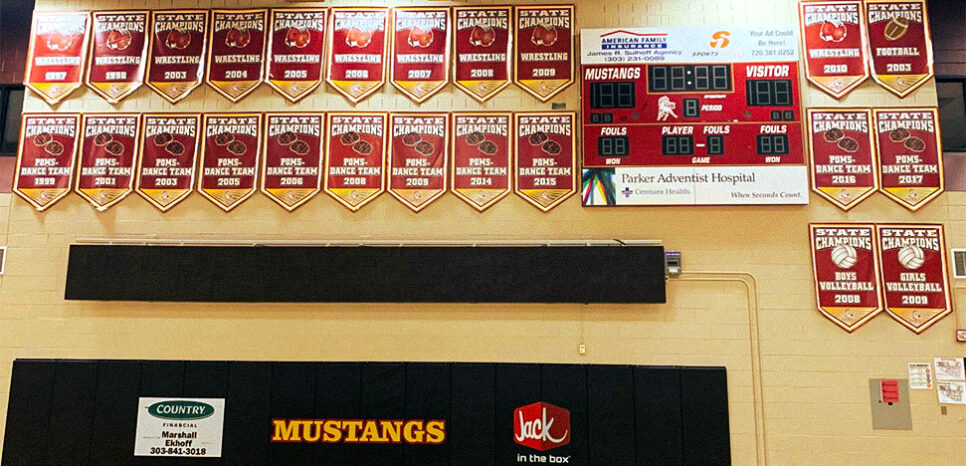
10 Leadership Tips for Coaches To Grow a Champion Program
- Our Mission
Developing Student Leadership
Schools can use experiential learning as an opportunity to let all students develop their leadership skills.

Teaching leadership can be tricky. At the secondary school level, most student leadership “development” programs are in fact only education (academic theory) or training (practical application). Rarely do high schools have the resources to effectively combine the two into true experiential learning.
Leadership education occurs in the classroom: It is the history, theory, concepts, models, and modern behavioral sciences which build the foundation for effective leadership. Leadership training is the practical application of leadership education. It gives students the opportunity to apply theoretical concepts or styles from the classroom to real and immediate situations, both formal or informal, structured and unstructured. Leadership development is the combination of the two: the overall process of learning, doing, reflecting, and actively experimenting with leadership styles, all of which can prepare students for leadership roles with increasing levels of responsibility.
Creating Leadership Development Opportunities
The challenge is how to effectively combine foundational leadership theories, principles, and knowledge with dynamic opportunities in which students can safely and confidently succeed, fail, and, most important, experiment with a variety of leadership styles.
One way is to augment existing programs and opportunities in which students hold leadership roles with more formalized leadership education. For example, how often are sports captains taught the basics of public speaking to strengthen their pre- and postgame speeches? How often are club presidents taught the basics of planning and leading a meeting, delegating tasks, and supervising implementation of group plans? When are elected student government representatives taught the importance of active listening, empathy, and servant leadership? Or, in the classroom, how are the leaders of group projects taught the essentials of building a timeline, back-planning, or giving and receiving constructive feedback to peers?
We can provide student leaders with the most relevant tools to succeed. In this way, not only are students developing expertise in what they are leading (the sport, the content of the club or activity, the group project skill set, etc.), but now they are also developing knowledge and confidence in how they are leading it.
A 4-Step Leadership Development Process
1. Identify Existing Programs and Opportunities: What student leadership opportunities exist at your school? Consider the full spectrum of both curricular and extracurricular programming: athletics, theater and clubs, peer mentorship programs, outdoor education and community service, and even small group projects within the classroom. Boarding schools may also have house systems that empower students to serve as leaders within their dorms. There are likely a plethora of existing programs and opportunities in which students hold leadership positions.
2. Create Additional Opportunities: The best way to develop student leaders is to give them recurring opportunities to lead. What curricular and extracurricular opportunities at your school could be more student-led? Community service outings can be decentralized into student-led teams. Project-based learning activities can have assigned, rotating student group leaders. Field trips and outdoor education can incorporate student co-leaders. And all-school events on campus can incorporate student leaders into the planning process. Regardless of the role, make sure these leaders have clear guidance, training, resources, and structure for their specific roles and responsibilities.
3. Clarify Core Leadership Skills: Once these opportunities are identified or created, consider the core leadership skills and roles required for each position. For example, some leadership positions (such as club presidents) require advanced organizational and management skills, whereas others (such as student government) require public speaking and interpersonal skills such as active listening and empathy.
Some roles require a hierarchical management structure, whereas others focus on collaboration and shared leadership models. For example, when selecting and preparing our outdoor student leaders for outdoor education trips, we develop checklists with pre- and post-trip administrative and logistical tasks in addition to the desired character strengths and expeditionary behavior we want them to role-model in their trail groups. Identifying these roles and the respective strengths required to succeed can allow mentors and facilitators to bucket their curriculum accordingly.
4. Incorporate Experiential Learning Models: Lastly, students must have the opportunity to “ learn, do, reflect, and act ” repeatedly during their leadership tenure. Once mentors introduce a new leadership skill or style, student leaders can experiment with it in their own roles. Recurring check-ins can allow them to reflect on the experience and draw out lessons learned, allowing student leaders to then act on those lessons in future encounters with their respective teams.
Ideally, this experiential learning cycle should be repeated as often as possible while students hold their leadership positions. Time and resources permitting, student leaders from across the spectrum of curricular and extracurricular activities could meet to discuss their respective leadership strengths and challenges, such as in a monthly leadership roundtable format. Our associate head of school for leadership, for example, collects feedback from the professional community on student leader performance to inform her recurring check-ins with the student leaders under her supervision.
empowering culturally competent leaders
We often assume that effective leadership is a one-size-fits-all approach or a specific combination of personality traits that, when identified and adopted, will naturally produce effective leaders. But this couldn’t be further from the truth. As stated in The Bass Handbook of Leadership , a timeless guide for student leadership development, “A person does not become a leader by virtue of the possession of some combination of traits, but the pattern of personal characteristics of the leader must bear some relevant relationship to the characteristics, activities, and goals of the followers.”
Furthermore, students today are entering a culturally diverse, 21st-century globalized economy, which will ensure that these desired personal characteristics will shift from setting to setting and place to place depending on the backgrounds of those being led. Our job is to make sure they are ready.
- Grades 6-12
- School Leaders
Free printable to elevate your AI game 🤖
19 Inspiring Leadership TED Talks for Teachers and Students
Leaders speak up when they see something that needs to change.
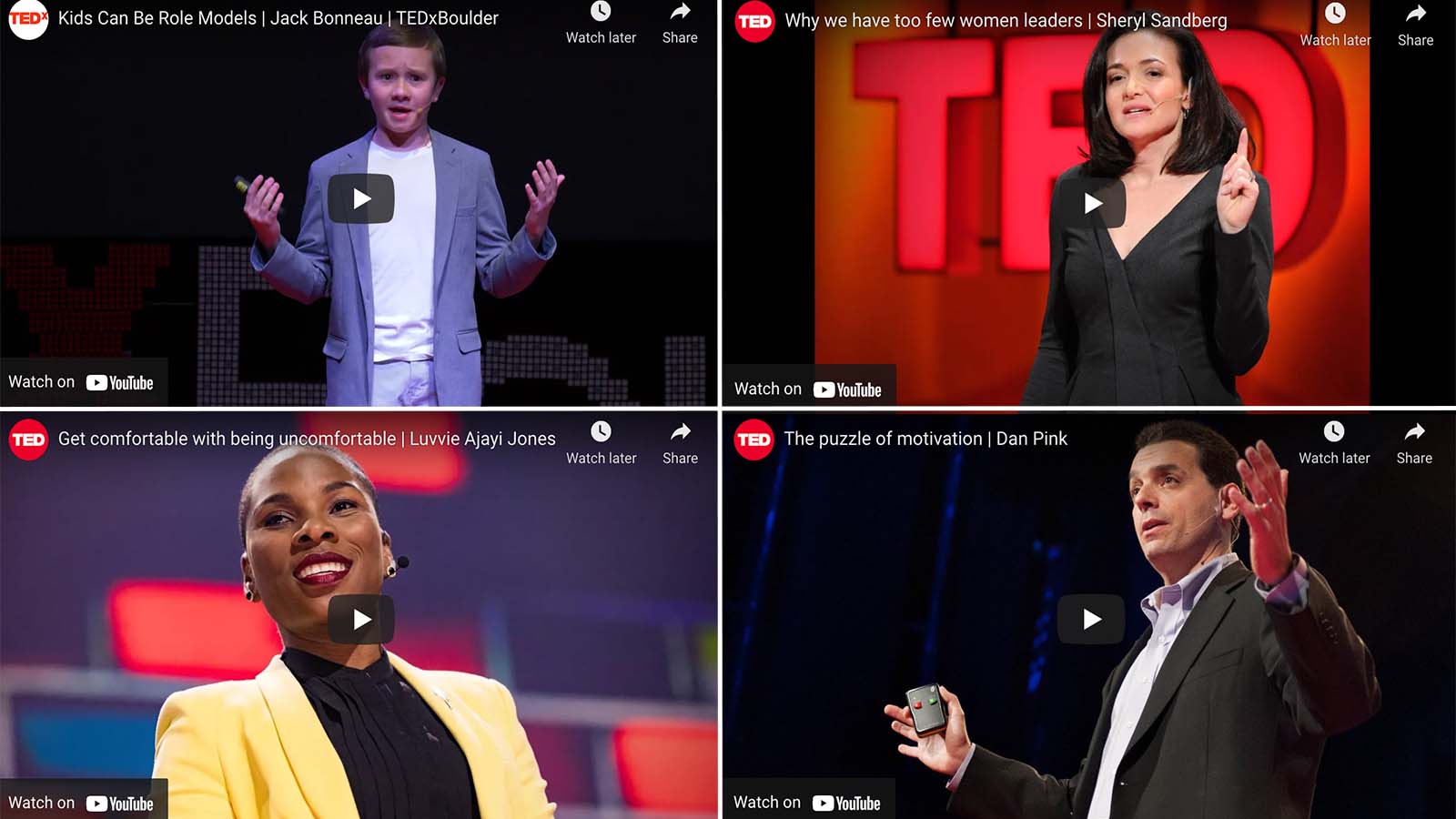
What does it mean to be a leader? This question is important to kids and adults alike. Leaders have the ability to make significant changes, touch people, and shape the world. But how do they do it? Luckily, we have some of the most successful, powerful, and influential leaders in the world as our teachers. This roundup of leadership TED talks will inspire students and teachers to stand up and lead the way forward.
Leadership TED Talks for Students
Leadership ted talks for teachers.
(Be sure to preview all videos to ensure they’re appropriate for your audience.)
Share these stirring videos with your students to encourage them to step up into leadership roles at school and beyond.
Jack Bonneau: Kids Can Be Role Models
Who better to inspire student leaders than a kid their own age? Kids look up to sports stars and entertainers, but they should really be looking up to other kids. Jake Bonneau is clearly wise beyond his years.
Luvvie Ajayi Jones: Get Comfortable With Being Uncomfortable
Leaders speak up when they see something that needs to change. That means that they face their fears and speak their mind. Inspire students to find their voices with this uplifting talk.
Drew Dudley: Everyday Leadership
For anyone who thinks leadership takes something “special” that not everyone has, Drew Dudley is here to prove you wrong. In less than five minutes, he’ll convince your students that every single one of them can be a leader, every single day, without even knowing they’re doing it.
[contextly_auto_sidebar]
Derek Sivers: How To Start a Movement
Derek Sivers uses a hilarious, quick video to show just how a moment turns into a movement. Kids will laugh, but this is one of those leadership TED talks where the laughter leads to a lesson.
Stanley McChrystal: Listen, Learn … Then Lead
General Stanley McChrystal is a decorated four-star general, making him a great source for advice on leadership. McChrystal shares an essential value of leadership: Don’t be too proud or full of yourself to learn from others because, at the end of the day, we all need one another to get through life.
Paul Osincup: Leading With Laughter
Humor is a powerful leadership school, and Paul Osincup wants to help you use it to your advantage. His open, easy style will appeal to students and encourage all those class clowns out there to consider themselves future leaders.
Lars Sudman: Great Leadership Starts With Self-Leadership
Would we need leaders in Utopia? Lars Sudmann thinks we would, but only the very best type: those who lead themselves before leading others. Find out what he means in this talk.
Susan Cain: The Power of Introverts
Susan Cain is well-known for touting the power of introverts. Your quieter students will recognize themselves in her descriptions and learn that they bring special skills to the table that make them incredible leaders.
Jim Lemoine: What Is Leadership?
Before you share this engaging video with your students, ask them to brainstorm answers to the question “What is leadership?” After the video is over, take a look at their original answers and see what was right and what they missed. Leadership might not be exactly what they think.
Teachers in need of motivation and encouragement will find plenty of both in these leadership TED talks.
Kayla Delzer: Reimagining Classrooms—Teachers as Learners and Students as Leaders
“As teachers and educators, we must embrace the students of today to reimagine tomorrow.” Kayla Delzer wants you to completely rethink your classroom and encourage kids to lead the way.
Linda Cliatt-Wayman: Lead Fearlessly, Love Hard
Linda Cliatt-Wayman is a powerful, driven, and successful school principal. Linda says that if you want to be a leader, you have to really lead. No matter what kind of organization you’re leading, a little concern and respect go a long way.
Lev Bukhman: What Student Leaders Can Learn From Leadership
Teachers themselves are leaders, but they’re also helping to build the leaders of tomorrow. Find out how learning to be a leader can help every single kid be healthier, happier, and more successful at school and beyond.
Dan Pink: The Puzzle of Motivation
Leaders motivate people to succeed, often through incentives and rewards. Dan Pink shares that incentive systems can do more harm than good and offers advice on what good leaders do instead.
Simon Sinek: How Great Leaders Inspire Action
Simon Sinek has lots of great inspiration and advice for anyone who wants to be a strong leader. In this talk, Sinek shows that your mission statement motivates and that your “why” is more important than your “what” or “how.”
Sheryl Sandberg: Why We Have Too Few Women Leaders
The gender gap is real in leadership positions across industries, and education is no different. Sandburg offers pragmatic advice to help keep women from undercutting their own aspirations.
Fields Wicker-Miurin: Learning From Leadership’s Missing Manual
Fields Wicker-Muirin travels the world to learn lessons from leaders on the spot, then tries to bring those ideas to others. In her talk, she highlights three amazing leaders you’ve never heard of and shares the qualities that make them great.
Roselinde Torres: What It Takes To Be a Great Leader
Roselinde Torres argues that today’s great leaders aren’t superheroes. Instead, they’re people who anticipate change, value diversity, and are willing to think differently and make courageous choices.
John Maeda: How Art, Technology, and Design Inform Creative Leaders
Strong leaders make creativity and innovation part of their everyday lives. John Maeda shares some lessons from the fields of design and technology that will help change the way you look at leadership.
Beth Wolfe: A Teacher’s Lesson on Leadership
Every teacher knows plenty about leadership, good and bad. Teacher Beth Wolfe shares what she’s learned over the years, including the fact that you don’t need a title to be a leader.
What are your favorite leadership TED talks? Come share your suggestions in the WeAreTeachers HELPLINE group on Facebook .
Plus, 40 must-watch ted talks for students ..

You Might Also Like
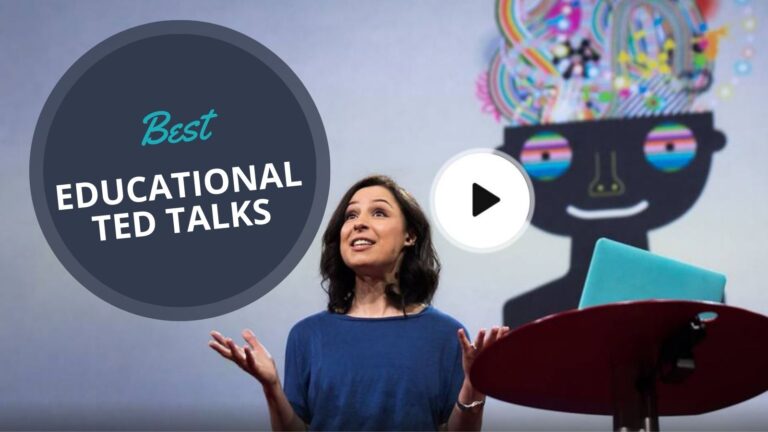
45 TED Talks That Will Intrigue, Encourage, and Inspire Your Students
Amazing speakers on fascinating topics. Continue Reading
Copyright © 2024. All rights reserved. 5335 Gate Parkway, Jacksonville, FL 32256
- Schools + Partners
- Resources + Tools
How to Develop Leadership Skills as a Student (Advice From a College Student)
...experts suggest that good communication is one of the best ways to build your “leadership brand.” that means speaking up about the causes you care about and taking action to....
By Carlee Strathmann

Are you looking to kickstart your journey to becoming a leader? Here’s a guide for learning more about leadership and developing strategies to change the world—or at least get started.
* As part of our ongoing work to #ReThinkHighSchool and prepare our students for the 21st century, we decided to create a series of long-form posts that seek to elucidate the college and career process for high school students. In the first installment of this series, we looked at how to get an internship . We’re here this week with more advice from college students in the XQ network—check out this post to learn how to develop leadership skills in high school.
Leadership. Take a second and think about leaders you admire. They may be teachers, other students, celebrities, or elected officials. Once you have them in your mind, close your eyes, and ask yourself:
- What makes these people good leaders?
- What about them inspires you to follow their lead?
- How can you use their stories to inspire yours?
Now open your eyes, and look in the mirror. You can be a leader, too. Keep reading to see exactly how to become the leader you want to be.
What Is leadership?
Leadership doesn’t look the same every time. In fact, it rarely does. You’re probably familiar with many examples of famous leaders from history books, the news, your community, etc. We remember these leaders for their accomplishments. And sometimes we remember leaders for their failures.
Effective leadership is not unique to iconic figures like Martin Luther King Jr. or Mahatma Gandhi, who paved the way for a better tomorrow. For instance, when I think of leaders and leadership, I also think of nurses who work tirelessly to care for our sick and elderly, artists who lend their creativity to challenge the way we think, and community members who stand up to protest for social change. Leaders help foster new ideas and growth within their communities. The truth is that there’s a leader in each of us.
But let’s start by breaking down the idea of leadership. On its most basic level, leadership is defined as the capacity to lead and generate a following.
The definition of leadership speaks to its core sentiment and tells us that you don’t need a fancy title to be considered a leader. You don’t have to be the student body president to be a leader at your school. You just need to be someone who cares about a cause enough to ask others to join you.
But what does effective leadership look like? Y Combinator —one of the top startup incubators in the country that funds companies like Airbnb, Dropbox, and Reddit— summarizes foundational characteristics all great leaders have in common:
- Great leaders have exceptional communication skills, which enables them to share their vision of the future with others.
- They are able to motivate others to get on board and work hard to achieve communal goals.
- Great leaders embody a mission beyond themselves and refrain from letting their ego get in the way.
- They are good listeners, who are willing to respond to feedback from others and admit when they’ve made a mistake. Their eagerness to learn and commitment to continuous improvement fuels their productivity.
To clarify, sticking to your mission does not mean being inflexible to change. Great leaders are those who adapt to the environment and the changing needs of their stakeholders. In fact, great leaders need to be open and willing to change.
Sticking to the status quo lends itself to vulnerability. Change is inevitable. So, we can sit back and wait or we can be proactive and stand up to disrupt the status quo.
The Importance of Developing Leadership Skills for 21st Century Learners
Taking on a leadership role is a great opportunity to build real-world skills.
Building out human skills is essential to this historical moment. We are in the midst of the fourth industrial revolutio n. Traditional manufacturing and industrial practices are now obsolete as companies look to optimize efficiency and minimize labor costs through smart technology like artificial intelligence and machine learning . Given this shift in the nature of work, it’s becoming even more important to build and expand your repertoire of skills .
Harvard Business Review experts say the shift to AI enhances the need for real-world, soft skills “such as humility, adaptability, vision, and constant engagement.” These skills are more challenging to quantify on your transcript. There is no clear way to measure someone’s ability to adapt. Nonetheless, the aforementioned soft skills are undeniably applicable to work and social environments.
In addition to adapting to work opportunities in the 21st century, soft skills like leadership are important in the college application process. When applying to college in a saturated group of students, it’s essential to make yourself stand out with more than just your grades. Building out your leadership portfolio is a great way to distinguish yourself from other candidates. There is no one best application, so it’s up to you to paint your story.
One best practice to boost your portfolio is to take an active role in a club or organization. It’s a great way to concretely demonstrate your commitment. But, you also have to “talk the talk.” Forbes experts suggest that good communication is one of the best ways to build your “leadership brand.” That means speaking up about the causes you care about and taking action to find solutions.
No matter your interest, getting involved as a leader allows you to discover where you thrive and where you need to improve. That’s why it’s so important as a leader to develop a growth mindset . In fact, Harvard experts say adopting a growth mindset is crucial to becoming an effective leader. Someone with a growth mindset believes that there is no limit to personal development.
“Students who have a growth mindset experience challenges as the way to learn and improve. They learn and achieve at higher levels, even when they start out at the same place as those with fixed mindsets.”
– Michele Cahill Senior Advisor, XQ Institute
A leadership position is a great way to exercise your strengths and explore your interests. Ask yourself, “ What makes me excited?” Is it volunteering to help others? Serving as the school president? Starting a club? Giving a speech at graduation? Whatever it is, establishing yourself as a leader is a great way to explore your interests on a deeper level.
Leadership Skills and Assets
Time management, goal-setting, communication, decision-making, advocating for and defending a cause, accountability, and networking are all key assets to a great leader.
- Time management: A leader must be willing to take on a variety of responsibilities. Holding a leadership position often requires rapid turnarounds. Knowing when to prioritize certain tasks over others can sometimes be a challenge. However, deadlines help to ensure that oneself and others complete tasks in a timely manner. Pro tip: Plan ahead and leave room for unanticipated interruptions. Employ a method for managing your time, such as a calendar or checklist.
- Goal-Setting: Leaders set goals to guide their progress. They see problems as opportunities to solve and break up their vision into smaller milestones. They evaluate their progress based on the milestones they’ve reached. And they look for creative and innovative ways to achieve their goals. Pro tip: Set SMART (Specific, Measurable, Actionable, Reasonable, Timely) goals.
- Communication: In an era of technological domination, communication takes many forms: speech, text, photography, video, body language, etc. No matter the platform, effective communication is key in spreading your message and generating a following. Pro tip: Share your goals with your network. Remain open and receptive to feedback in order to avoid stagnation. When preparing content, consider your audience. Speak or write using language that your audience will understand. According to Simon Sinek’s Ted Talk , speaking from the inside enables people to rationalize with what you are saying. When seeking to change behavior, you will need a little more buy-in than facts and statistics.
- Decision-making: While leadership and power are not one and the same, leaders often have the power to make decisions that affect a variety of stakeholders. Each day, we make decisions—many of these decisions are inconsequential. Yet, over time, these decisions come together to contribute to the big-picture vision. Pro tip: Listen to the voices of your stakeholders and consider the impact of your decisions. Before jumping to any quick decisions, make sure you understand the whole story. So, while each decision may not seem to matter at the moment, make each decision count and be ready to defend it or develop a plan to make amendments.
- Advocating for or Defending a Cause: Leaders frequently play a role in advocating for a cause or defending a decision. They have the opportunity to go against the grain and speak up for marginalized voices. Pro tip: Whatever your decision, consider the facts and utilize evidence in making your claims. And do it with conviction!
- Accountability: Using a system of checks and balances can help maintain the accountability necessary to achieve your goals successfully. And when something goes wrong, you can provide appropriate feedback and make improvements for your next move. Pro tip: Make sure you establish a system of accountability for yourself and your team. And be consistent. Hold yourself to the same standards as your teammates. Evaluate your progress towards your goals on a regular basis.
- Networking: Networking is a skill that will be important throughout your leadership journey. But, when you’re just getting started, it is especially important. Your network is your team of supporters and advocates. Once you have a team of supporters, your personal progress will become a joint mission. Social connections are tools that you can use to navigate through difficult situations. When you encounter a challenge, it’s likely that others have experienced that same challenge. They may have advice or be able to offer the best practices they employed while navigating through that challenge. Join the conversation about how to network on Rethink Together . Pro tip: Research topics that excite you. Find out who the experts are in the field. Who are the people and organizations doing similar work in your area? Call them or send them a message to express your interest in the material and let them know you would like to connect.
Mastering these skills is fundamental to becoming a resilient leader. Despite the level of distinction among these skills, they work best when you align them as part of a coherent framework. Leadership experts Michael Fullan and Lyle Kirtman dive deeper into the subject in their book, “ Coherent Leadership: Forging Clarity from Complexity .” It outlines characteristics of effective leaders:
| Focusing Direction | Challenges the Status Quo |
| Cultivating Collaborative Cultures | Builds trust through clear communications and expectations Focuses on team over self Creates a commonly owned plan |
| Deepening Learning | Builds external networks/partnerships |
| Securing Accountability | Is committed to continuous improvement of self and the organization Has a high sense of urgency for change and sustainable results |
The Faces of Student Leadership
It may seem that some people were born to be leaders. Many of those, though, had to face a number of challenges along the way. You may have heard the stories of students like Malala Yousafzi, Greta Thurnberg, and others. Malala seeks gender equity and Greta gives a voice to the planet.
These students noticed an issue they cared about and worked hard to address it by creating the change they wanted to see in the world.
Meet Student Leaders Across the Country
- Alliyah Logan is a youth advocate from the Bronx. She amplifies the voices of Black, Brown, and Indigenous people in her community, especially the voices of those impacted by the coronavirus pandemic. Check out her blog post to read more about how she’s using her voice to make a change.
- Josh Stern is a writer and activist from New York City. He uses his voice to advocate for and break down biases about students with disabilities. Check out his blog to learn more about his take on how to best support students with disabilities like himself during the COVID-19 Pandemic.
- Grace Nesbitt is a public figure on Instagram who uses her own battle with mental illness to inspire others to love themselves for who they are. Check out her blog post to learn more about her 7-year journey toward embracing herself and building confidence.
- Jerome Foster II is a climate activist, the founder of the Climate Reporter , and a former intern for the late Representative John Lewis —and these are only a few of his accomplishments, all before graduating high school. Check out his feature as one of the four Changemakers of Tomorrow for GapKids’ “BE THE FUTURE” Campaign.
Leadership Activities for High School Students
Here are ideas from Positive Psychology for getting involved as a leader in your school and community:
- Participate in student government
- Join or start a club
- Get involved in sports teams or other after-school activities
- Find volunteering opportunities
- Get an internship
- Complete a passion project
Want to do good in the world and inspire people? That’s the first step to joining the next generation of leaders. As a young leader, you bring unique, new ideas. Your fresh perspective is a toolkit for change. Let your dreams guide you.
Developing strong leadership skills will not only enhance your role as a member of society but will also help improve your ability to make a difference in your own life and the lives of others. Once you develop the skills necessary to lead, you can apply them however you want. Try looking to the XQ Learner Goals as a guide to develop leadership skills:
- Become a master of fundamental literacies
- Learn foundational knowledge
- Be an original thinker in an uncertain world
- Be a generous collaborator
- Commit to being a learner for life
Strategies and Activities for Becoming a Student Leader
Start by defining your purpose .
Part of the leadership journey is exploring your driving forces. Here are a few steps you can take to help define your purpose:
- Explore what motivates you and what you would like to do or change.
- While you develop your vision, look into areas of need.
- Find out where you feel most connected and explore your role in meeting those needs.
- Define your aspirations and devise an agenda to get started.
“Ask yourself what do I need or want to come out of this situation, and does that seem reasonable and attainable ?” — Nicole Smith
A clear purpose is the foundation you need to inspire people to do good and create positive outcomes. No matter how big your dream is, keep your vision in front of you. Let your “ why” guide you. Draw on your own experiences. Dive deep into topics you find interesting. And that passion will drive your behavior and propel you forward toward reaching your goals.
Develop Your Leadership Skills Through Activities and Practice
Build Your Team
Imagine how much you can achieve when you have the collective capacity of a group of individuals who share your vision. Having a team does not mean each member needs to agree at all times. But it’s important that your teammates share similar grounding principles; make sure the “ why” behind your work aligns.
Each team member has a set of experiences that they bring to the table. Remember that diverse perspectives bring diverse solutions to the table. The best teammates are those who complement your skill set and fill in the gaps in your expertise.
As a leader, it may feel that there is a lot of pressure to have everything under control. Take time to reflect on your own self-awareness to ensure you are tending to your own needs. Also, feel free to ask for help. Mentors are great resources for sharing your reflections, holding you accountable, and empowering you to meet your goals. Building a relationship with a mentor can also provide opportunities for self-improvement to help you grow.
Embrace Challenges
When you are first getting involved in a new project, it can be easy to let the fear of rejection or failure get you down. Don’t give up! In fact, some of the greatest leaders are successful because they embraced failure and used what they learned to improve in future endeavors.
Ever heard of Elon Musk ? Not only is he the mastermind behind companies like PayPal, Tesla, and SpaceX, but he’s also an expert in the field of failure. When he started Paypal, critics rated it one of the 10 worst business concepts. The first and second rockets he launched exploded. The third severely failed. People didn’t believe in him. At one point, Musk even confessed that the Tesla Roadster was a disaster.
Being a leader also means learning how to cope with failure and how to persevere—no matter what people say. The first step is to believe in yourself. Then utilize your team to help work toward your shared goal.
Set Up a Campaign
If you’re seeking to pursue a specific goal, you will likely need the support of others to make it happen. That’s why creating a campaign is a helpful tool for leaders to raise awareness and build support for their cause.
In the words of Simon Sinek , “If you don’t know why you do what you do, and people respond to why you do what you do, then how will you ever get people to vote for you, or buy something from you, or, more importantly, be loyal and want to be a part of what it is that you do.”
Here are some tips to set up your campaign:
- Raise awareness Be clear about the issues you want to address and why. Put up posters, post on social media, give a speech in front of a group. Get people talking. Word-of-mouth advertising is free and a great way to spread excitement and generate involvement for your project.
- Identify your audience If you want to be a leader, it’s important to develop a trusting relationship with the people you seek to lead. You’ll want to figure out who your primary audience is. Get to know the needs of your audience and let them know how you intend to meet their needs.
- Tell your story Share your story and communicate your morals and values with your audience. Even if you can’t connect with them in person, use technology and social media to form those relationships. For inspiration, check out how Roxie Richner , an organizer, storyteller, and student, tells her story on her website .
- Ask for feedback Engage in conversations with your audience to ensure they understand what you are trying to communicate. Pay attention to how your audience reacts to your messages. Most importantly, ask your network how you can improve so that you can discover different ways to reach your goals and overcome challenges.
- Keep it professional As a leader, you are a public figure. When speaking up about a particular topic, everything you say or post or share will be a part of your personal brand. So, be mindful of how others will perceive your messages. Choose your language wisely with a deep consideration for your audience and the broader community.
What’s Next?
Ready to take the big leap to embark on your leadership journey?
If you haven’t found your spark or passion yet, the best way to figure it out is to engage in and explore as many opportunities as possible. Reach out to people who you admire. Ask questions. Conduct a mini-interview.
Here are some sample interview questions to help you get started:
- How did you get to where you are today?
- What are some challenges you have faced? And how did you overcome them?
- Who did you look up to when you were my age?
Once you establish yourself as a leader, keep in touch with your mentor and network. The scope of networking is boundless. Ask your parents, teachers, and peers to connect you with people they know! Stay in touch with your teachers from high school even after you graduate. You never know when you may need to ask for letters of recommendation along the way. Many great leaders have earned their positions by reaching out to mentors in their own communities.
More from XQ
Podcast: tennessee high schoolers solved a nearly 40-year-old serial murder mystery.
By Edward Montalvo

Watch: New Film Inspires America to Rethink High School

Watch: Rethinking High School in the DC Public Schools

The First Class
A feature-length documentary following the founding class of Crosstown High in Memphis Tennessee.

XQ Competencies
The XQ Competencies translate the XQ Learner Outcomes into 37 specific, attainable goals for learning.

Xtra Inspiration
XQ Xtra Newsletter XTRA Inspiration Get the latest…

Do High Schools Prepare Students for Careers?
We know that today's learners and high school graduates need to be well-prepared to enter…

A District-wide, Community-Led Initiative to Transform DC Public High Schools.

How to Write a Letter to the School…
If you want your voice to be heard and to show your concern for your…

Future-Proof Your Teen: Game-Changing High School Tips for…
Our young people are growing up at a time when the economy, the workforce, and…

Youth Voice Toolkit
This resource guides students through driving change within their high school communities.

Podcast: Tennessee High Schoolers Solved a Nearly 40-Year-Old…
Alex Campbell asked his students to solve a cold case involving a potential serial killer,…

Got any suggestions?
We want to hear from you! Send us a message and help improve Slidesgo
Top searches
Trending searches

135 templates

suicide prevention
9 templates

35 templates

13 templates

hispanic heritage month
21 templates

mid autumn festival
18 templates
Leadership Presentation templates
Become a true leader and guide your team to success with these google slides themes and powerpoint templates about leadership. are they born or made onward customize these designs in no time.
- Calendar & Weather
- Infographics
- Marketing Plan
- Project Proposal
- Social Media
- Thesis Defense
- Black & White
- Craft & Notebook
- Floral & Plants
- Illustration
- Interactive & Animated
- Professional
- Instagram Post
- Instagram Stories

It seems that you like this template!
Premium template.
Unlock this template and gain unlimited access

Register for free and start downloading now
Five practices of exemplary leadership.
Download the Five Practices of Exemplary Leadership presentation for PowerPoint or Google Slides and start impressing your audience with a creative and original design. Slidesgo templates like this one here offer the possibility to convey a concept, idea or topic in a clear, concise and visual way, by using different...

Team Leader Project Proposal
After spending some months debating and brainstorming, your team has come up with a new project. Act as a true team leader and present this new idea to your managers with this new template. The main features you'll find in these slides are the use of illustrations and some big...

Leader for Success
Success can be achieved individually or as a group, but the latter is more difficult, as it requires a strong leader. Talk about the skills and abilities a suitable leader should have in this editable template! We can tell you the features that a nice presentation should have for that:...

Leadership Behavior for Business
Leaders are the reference, the people who guide others to success, but they must possess certain skills and the correct behavior. If this is exactly the topic of your next presentation, use this template to save time! Its design will grab the attention of your audience easily thanks to its...

Leadership Common Mistakes
What makes a great leader? What should they watch out about? If you are able to answer these questions, then most probably you have a great team behind you, who work along you to meet deadlines and reach success. With this template you can speak about the importance of a...

Transformational Leadership Infographics
Do you know transformational leadership? It is a leadership style based on the fact that team leaders seek to inspire or motivate workers to be creative, innovate or create continuous changes. This method is very successful when it comes to the growth of a company, because there is nothing more...

Leadership and Teamwork for Business
The proper functioning of a company requires different skills among employees. And we're not talking about how qualified they are to do their job (which is also true) but about competencies such as teamwork or, in the case of the team leader, having the necessary skills to lead the team...

Leadership Development Plan Infographics
What makes a good leader? Good leadership is a developed skill that you will also learn when you download these infographics for your next presentation! Speak about teamwork, soft skills, interpersonal abilities and role models with these creative designs full of color and life. Slidesgo will be the leader that...

Overcome Leadership Challenges Workshop
The best leader is the one that always keeps learning. Prepare a workshop about how to overcome challenges with this beautiful template for Google Slides and PowerPoint! It has a modern design with lots of illustrations of people and great resources for your speech so, if you combine it with...

Leadership Skills IG Post for MK
Show your Instagram followers what it takes to be a great leader with these editable designs full of color and creativity! Instagram is a great tool for sharing tips and creating a community, so educational posts like this one will surely be well-appreciated. Edit the slides of this design and...

Become a Leader
Inspire other people to learn more, to innovate and to succeed. Design now a workshop to help others become leaders with this smart template.

Leadership in Business Management
Download the "Leadership in Business Management" presentation for PowerPoint or Google Slides. The world of business encompasses a lot of things! From reports to customer profiles, from brainstorming sessions to sales—there's always something to do or something to analyze. This customizable design, available for Google Slides and PowerPoint, is what...

5 Levels of Leadership Infographics
John Maxwell, in his book "The 5 Levels of Leadership" explains that there is a 5-level path that a leader must go through in their continuous improvement process. The first level is position; the second, permission; the third, production; the fourth, development of people and the fifth, pinnacle. Explain all...

Effective Leadership Infographics
Effective leadership is something that most employees want and expect from the person who leads them. Such a person must listen, must be trustworthy, must be honest... Can you tell us more about this topic? We have an idea: customize these infographics, which are completely editable, and insert them into...

Leadership Conference
How do you know if you are a good leader? That’s the subject of your next leadership conference, and this template is here to help you find all the right questions that attendees should ask themselves. Help them figure out what kind of leaders they are and what they can...

Leadership And Teamwork Meeting
Download the Leadership And Teamwork Meeting presentation for PowerPoint or Google Slides. The education sector constantly demands dynamic and effective ways to present information. This template is created with that very purpose in mind. Offering the best resources, it allows educators or students to efficiently manage their presentations and engage...

Leadership Development Program for Business
Download the Leadership Development Program for Business presentation for PowerPoint or Google Slides and start impressing your audience with a creative and original design. Slidesgo templates like this one here offer the possibility to convey a concept, idea or topic in a clear, concise and visual way, by using different...

Leadership School
Download the Leadership School presentation for PowerPoint or Google Slides. Are you looking for a way to make your school or academy stand out among the competition? This template is designed to showcase all the fantastic aspects of your center. With perfect slides that allow you to easily add information...
- Page 1 of 7
- [email protected]
- (650) 338-8226
Cupertino, CA

- Our Philosophy
- Our Results
- News, Media, and Press
- Common Application
- College Application Essay Editing
- Extracurricular Planning
- Academic Guidance
- Summer Programs
- Interview Preparation
Middle School
- Pre-High School Consultation
- Boarding School Admissions
College Admissions
- Academic and Extracurricular Profile Evaluation
- Senior Editor College Application Program
- Summer Program Applications
- Private Consulting Program
- Transfer Admissions
- UC Transfer Admissions
- Ivy League Transfer Admissions
Graduate Admissions
- Graduate School Admissions
- MBA Admissions
Private Tutoring
- SAT/ACT Tutoring
- AP Exam Tutoring
- Olympiad Training
Research Programs
- Science Research Program
- Humanities Competitions
- Passion Project Program
- Ad Hoc Consulting
- Athletic Recruitment
- National Universities Rankings
- Liberal Arts Colleges Rankings
- Public Schools Rankings
Acceptance Rates
- University Acceptance Rates
- Transfer Acceptance Rates
- Supplemental Essays
- College Admissions Data
- Chances Calculator
- GPA Calculator
National Universities
- College Acceptance Rates
- College Overall Acceptance Rates
- College Regular Acceptance Rates
- College Early Acceptance Rates
- Ivy League Acceptance Rates
- Ivy League Overall Acceptance Rates
- Ivy League Regular Acceptance Rates
- Ivy League Early Acceptance Rates
Public Schools
- Public Schools Acceptance Rates
- Public Schools Overall Acceptance Rates
- Public Schools Regular Acceptance Rates
- Public Schools Early Acceptance Rates
Liberal Arts
- Liberal Arts Colleges Acceptance Rates
- Liberal Arts Colleges Overall Acceptance Rates
- Liberal Arts Colleges Regular Acceptance Rates
- Liberal Arts Colleges Early Acceptance Rates

15 Leadership Activities for High School Students

By Eric Eng

High school students seeking to sharpen their leadership skills have a wealth of activities at their disposal. Engaging in leadership activities is essential for personal growth and success in college applications.
So, let’s explore practical steps and activities that can transform you into a standout leader. We’ll offer insights into how to elevate your leadership capabilities through real-world experience.
1. Student Government
Participation in student government is a classic avenue for demonstrating leadership skills. Elected positions provide a platform for advocating student interests and influencing school policies and events.

To achieve success in student government, start by understanding the needs and concerns of your fellow students. Campaign on a platform that addresses these issues with clear, actionable solutions. Once elected, maintain open communication with both the student body and school administration. Organize regular meetings to discuss progress on initiatives and gather feedback, ensuring your leadership is both effective and responsive to the needs of your peers.
2. Interest Clubs or Organizations
Starting a club or organization at your school is a powerful way to demonstrate initiative and leadership. For example, students who have founded STEM clubs have not only fostered a community of like-minded peers but also enhanced their organizational, planning, and team management skills. This kind of initiative is a prime example of leadership activities for high school students that colleges and employers look for.
To start a club effectively, first gather a group of interested students and draft a mission statement that clearly defines the club’s purpose and goals. Next, secure a faculty advisor and gain approval from your school’s administration. Finally, organize regular meetings and actively recruit members through school announcements and social media channels to build your membership.
3. Youth Advocacy Groups
Joining or establishing a youth advocacy group allows high school students to take a stand on issues affecting their generation, such as mental health, education reform, or environmental protection . Leadership in these groups is demonstrated through organizing campaigns, speaking at events, and engaging with community leaders.
To effectively lead in youth advocacy, begin by identifying an issue you are passionate about and research existing groups or the need for a new group. Then, recruit like-minded peers and create a strategic plan outlining your goals, target audience, and methods of engagement. Utilizing social media for outreach and organizing events can significantly amplify your group’s voice and impact.
4. Volunteering
Volunteer organizations or community groups outside of school allows students to make a tangible difference while building leadership skills. Students who lead initiatives for youth clubs, religious organizations, or nonprofit agencies gain valuable experience in guiding teams, organizing events, and making strategic decisions.
To excel in volunteer leadership roles, identify an organization or group whose mission aligns with your interests. Start by volunteering in various capacities to understand the organization’s needs and how it operates.
When ready, take on more responsibilities or propose new projects that address gaps or opportunities you’ve identified. Effective leadership in these roles requires being proactive, reliable, and open to feedback, ensuring that your efforts lead to positive outcomes for the organization and your personal growth as a leader.
5. Community Service Projects
Organizing a community service project demonstrates leadership by addressing local needs and motivating others to contribute positively. Successful projects, like a food drive that collected thousands of pounds of food for local pantries, highlight a student’s ability to lead and inspire.
To effectively organize a community service project, start by identifying a specific need in your community that you’re passionate about. Then, create a detailed plan that outlines the project’s goals, required resources, and a timeline. Engaging your peers and promoting the event through social media and community bulletin boards will ensure broader participation and impact.

6. Business Ventures
Starting a small business offers high school students a unique opportunity to develop leadership skills through real-world experience. Managing a venture, like a bake sale, online shop, or tutoring service, requires planning, marketing, and problem-solving. These values showcase leadership potential to colleges and future employers.
To launch an effective entrepreneurial venture, identify a product or service that addresses a need or interest in your community. Create a business plan that outlines your goals, target market, pricing strategy, and marketing approach. Utilize social media and word-of-mouth to promote your venture. Managing the financial aspects carefully and being responsive to customer feedback are crucial steps in leading your venture to success.
7. Research Projects
Leading a research project allows students to demonstrate leadership in an academic context. Collaborating with peers or faculty on research in a subject of interest shows the ability to initiate projects, coordinate tasks, and drive a team towards shared objectives.
To lead a research project effectively, start by identifying a topic that sparks your interest and offers potential for in-depth study. Gather a team of interested peers or seek a mentor among the faculty who can provide guidance and support. Plan the project carefully, dividing tasks among team members and setting deadlines to ensure steady progress.
Presenting your findings at school events, science fairs, or academic conferences can further demonstrate your leadership and commitment to advancing knowledge in your chosen field.
8. Creative Projects
Leading a creative project, such as a school play, art exhibition, or literary magazine , showcases a student’s ability to manage diverse tasks, from organizing auditions to curating submissions. This type of leadership involves inspiring creativity, ensuring collaboration, and meeting deadlines.
To effectively lead a creative arts project, begin with a clear vision of what you want to achieve. Assemble a dedicated team of students who share your enthusiasm and allocate roles based on each member’s strengths and interests. Regular meetings to track progress, resolve issues, and maintain motivation are crucial.
Promoting the project through school announcements and social media will attract a wider audience, ensuring the project’s success and showcasing your leadership skills.
9. School Newspaper or Media Team
Taking a leadership role in the school newspaper or media team is an excellent opportunity for students to develop and showcase their leadership skills. This includes overseeing content creation, editing, and publication processes. Leaders in these roles are responsible for setting the publication’s direction, encouraging teamwork, and ensuring deadlines are met.
To lead a school newspaper or media team effectively, establish clear goals and a vision for what the publication should achieve. Work closely with team members to delegate tasks according to each person’s strengths and interests. Promoting your newspaper or media content across school platforms will increase engagement and showcase the results of your leadership efforts.
Taking on a leadership role in a sports team, such as captain or co-captain, is about much more than just playing the game. It involves inspiring teammates, fostering teamwork, and demonstrating sportsmanship. Leaders in sports settings often set the tone for their teams, influencing both the team’s culture and its success on the field.

To be an effective sports team leader, focus on developing strong communication skills and a positive attitude. Show commitment by being the first to practice and the last to leave. Additionally, regularly organize team-building activities to strengthen bonds between teammates. This approach not only enhances team performance but also solidifies your leadership and interpersonal skills.
11. Mentorship and Peer Tutoring
Participating in mentorship and peer tutoring programs is an excellent way for high school students to showcase leadership. These activities not only help improve academic outcomes for peers but also develop the mentor’s communication, empathy, and leadership skills. A study shows that students involved in peer tutoring programs often see improvements in grades, highlighting the impact of student-led academic support.
Achieving success in mentorship and peer tutoring involves first identifying your strengths and subjects in which you excel. Then, volunteer for programs that match your skills with the needs of your peers. Being reliable, patient, and proactive in providing support will enhance your effectiveness as a mentor or tutor, solidifying your role as a leader among your peers.
12. Public Speaking Competitions
Participating in public speaking competitions is a dynamic way for high school students to hone their communication and leadership skills. Excelling in these competitions demonstrates a student’s ability to articulate ideas clearly and persuasively—a key trait of effective leaders.
To excel in public speaking, start by practicing your speech or presentation extensively. Seek feedback from teachers, peers, or mentors to refine your content and delivery. Additionally, watch videos of skilled public speakers to learn various techniques and styles. Participating regularly in competitions will not only improve your speaking abilities but also build confidence in your leadership capabilities.
13. Cultural Exchange Programs
Participating in cultural exchange programs is another excellent way for high school students to develop leadership skills. These programs broaden a student’s perspective, enhance cultural awareness, and improve communication skills across diverse backgrounds—key qualities of effective global leaders.
To participate in a cultural exchange program, research programs that align with your interests and offer opportunities for meaningful cultural immersion. Prepare by learning about the host culture and language, which will enable you to engage more deeply during the exchange.
Actively participating in all aspects of the program and reflecting on your experiences afterward can maximize the benefits of the exchange, enhancing your leadership capabilities and global understanding.
14. Leadership Workshops and Seminars
Participating in leadership workshops and seminars offered by external organizations provide valuable insights into effective communication, time management, decision-making, and emotional intelligence, among other skills. This is a direct way for high school students to engage in activities that build upon and refine their leadership potential.
To maximize the benefits of attending leadership workshops and seminars, actively participate in sessions and take notes on key learnings that you can apply to your own leadership style. Networking with speakers and fellow attendees can also provide mentorship opportunities and insights into different leadership paths.
After attending, implement the strategies and skills learned in your daily activities and leadership roles, and share your new knowledge with peers to further develop your leadership influence.

15. Part-Time Jobs or Internships
Securing part-time jobs or internships relevant to a student’s interests and career goals offers hands-on experience in a professional setting. This experience is invaluable for developing leadership skills, such as teamwork, communication, and problem-solving. These activities not only enhance a student’s resume but also provide a practical context for applying and growing leadership skills outside the classroom.
To effectively gain leadership experience through part-time jobs or internships, approach your tasks with enthusiasm and a willingness to learn. Seek opportunities to take on additional responsibilities and demonstrate your capability to lead and manage projects. Building a good relationship with your supervisor and coworkers can also lead to mentorship opportunities and further career development.
How can leadership activities boost college applications?
Participating in leadership activities as a high school student can significantly enhance your college applications. Colleges and universities value applicants who have demonstrated the ability to lead, showing initiative, responsibility, and the capacity to influence others positively.
Moreover, leadership roles in high school activities provide tangible examples of a student’s skills and achievements. When students detail their leadership experiences, such as organizing a community service project or leading a student organization, they offer admissions committees insights into their character and potential for future success.
What are the key qualities of a student leader?
The key qualities of a student leader include effective communication, empathy, and resilience. Leaders who communicate clearly and persuasively can unite their teams and motivate their peers toward common goals. Empathy allows student leaders to understand and connect with others, fostering a supportive and collaborative environment. Resilience is crucial for navigating the inevitable challenges and setbacks that come with leadership roles.
Additionally, student leaders exhibit initiative and problem-solving skills. They are not afraid to take on new challenges and are always looking for ways to improve their team or organization. These qualities are not only vital for success in high school leadership activities but also in college and future careers. Developing these traits through leadership activities for high school students can set a strong foundation for lifelong success.
How do I balance my academic responsibilities with my leadership roles?
Balancing academic responsibilities with leadership roles is a skill that requires planning and prioritization. Effective time management is key; creating a schedule that allocates specific times for studying, leadership activities, and personal downtime can help ensure that none of these areas suffer. This approach allows students to fulfill their academic obligations while also committing to their leadership roles, ensuring both areas are given the attention they deserve.
Moreover, leveraging resources such as peer support, mentor advice, and organizational tools can significantly ease the balancing act. Delegating tasks within your leadership roles can also lighten your load, teaching you valuable lessons in trust and teamwork. By approaching both academics and leadership activities with a strategic mindset, students can excel in both arenas without becoming overwhelmed.

What books on leadership should student leaders read?
Reading books on leadership is a vital activity for high school students looking to develop their leadership skills. Renowned leadership books like The 7 Habits of Highly Effective People by Stephen R. Covey or How to Win Friends and Influence People by Dale Carnegie offer timeless insights into effective leadership and personal growth. These books have shaped the leadership styles of many successful individuals by providing actionable advice and deep understanding of human behavior and organizational dynamics.
To effectively gain from reading leadership books, actively engage with the material. Take notes, highlight key points, and reflect on how the insights apply to your personal experiences and goals. To remember and apply these insights, try discussing the books with a mentor or peers, or even starting a book club focused on leadership topics. This can transform reading from a solitary activity into an interactive and practical learning experience, reinforcing the lessons learned.
How do I boost my confidence to take on leadership roles?
Boosting confidence to take on leadership roles begins with stepping out of your comfort zone and embracing opportunities for growth. Start with small leadership tasks and gradually take on more significant challenges as your confidence grows. Each success builds your confidence, and even when you face setbacks, you’ll learn valuable lessons that prepare you for future leadership opportunities. Remember, confidence comes from action, reflection, and resilience.
Additionally, seeking feedback from trusted mentors or peers can provide constructive insights into your leadership style and areas for improvement. Engaging in workshops and training sessions focused on leadership skills can also bolster your confidence. By continuously seeking to learn and improve, you’ll naturally become more confident in your ability to lead effectively.
Leadership activities for high school students are crucial opportunities for personal growth and development. By engaging in these activities, students not only enhance their college applications but also lay the groundwork for future success in any career path they choose.
Remember, the journey to becoming a great leader is ongoing and filled with learning opportunities at every step. Embrace each experience with an open mind and a willing heart, and you’ll find that your potential to lead and inspire knows no bounds.
Want to assess your chances of admission? Take our FREE chances calculator today!

Why College Admissions Isn’t Perfect

US News Rankings

The Personal Statement: The Holy Grail of College Admissions

The Modern Day 4.0 and 1600 SAT Score Student Is No Longer Impressive

The Competitive Nature of College Admissions for Asian Americans

The College Application

Our Comprehensive Approach

Ivy League Schools

How Early Should You Prepare for College?

Featured in US News & World Report Best Colleges Publication

Congratulations to AdmissionSight Students and their Acceptances!

College Rejection

College Rankings

College Consultants Could Make A Difference

College Admissions Scandal and Higher Education

The 7 Best Colleges for Figure Skating

Understanding Restrictive Early Action at Harvard

How to Get into Harvard: Admission Requirements and Tips

Carnegie Mellon University: Weighing the Pros and Cons

The Best Colleges for Pre-Med

Top 5 Princeton Majors: A Quick Guide

How Many People Apply to Stanford: Impact of Legacy Preferences on Admission

Top 10 Unique Classes at Brown University

Yale’s Hidden World: How Many Secret Societies Exist?

Discover the Best Law Schools in the US This 2024

Is Georgetown University a Good School? Insights and Tips
Fun facts about princeton university: discover why it’s one of america’s top universities.

What Is the Best Ivy League School For You? A Quick Guide

UCLA Scholarships: All You Need to Know

Pros and Cons of Harvard University: All You Need to Know
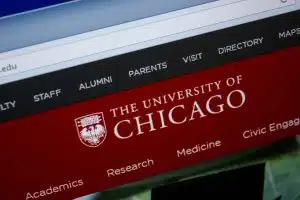
How Hard Is It to Get into the University of Chicago?

A Quick Guide to the Different Colleges and Universities in the U.S.
Leave a comment cancel reply.
Your email address will not be published. Required fields are marked *
Save my name, email, and website in this browser for the next time I comment.
Recent Articles

The 7 Best Colleges for...

Understanding Restrictive Early Action at...

How to Get into Harvard:...

Carnegie Mellon University: Weighing the...

Top 5 Princeton Majors: A...

How Many People Apply to...

Top 10 Unique Classes at...

Yale's Hidden World: How Many...

Discover the Best Law Schools...

Is Georgetown University a Good...

Fun Facts about Princeton University:...
Sign up now to receive insights on how to navigate the college admissions process..

Admissions Counseling
- Academic & Extracurricular Profile Evaluation
Copyright © AdmissionSight 2024
Privacy Policy - Terms and Conditions
- WordPress.org
- Documentation
- Learn WordPress
- Members Newsfeed
15 Leadership Activities for High School Students
- School Leadership
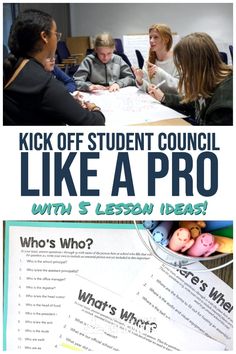
Introduction:
Leadership is an essential skill for personal and professional growth. High school is an ideal time to develop and cultivate leadership qualities, as students are beginning to discover their passions and interests. In this article, we present 15 leadership activities that can help high school students enhance their skills and become better leaders.
1.Team Building Exercises: Organize team-building activities such as group projects, scavenger hunts, or problem-solving tasks to encourage collaboration and communication among students.
2.Leadership Workshops: Host workshops or seminars on essential leadership qualities such as decision-making, time management, delegation, and conflict resolution.
3.Volunteer Work: Participate in community service projects to learn the importance of giving back and taking responsibility for one’s community.
4.Model UN: Join or start a Model United Nations club in your school to develop diplomatic skills, global awareness, and public speaking abilities.
5.Student Government: Run for a position in your school’s student government to gain experience in decision-making, negotiation, and team management.
6.Peer Mentoring Programs: Establish a peer mentoring program where older students guide younger ones through schoolwork or extracurricular challenges, fostering teamwork and empathy.
7.Debate Club: Participate in a debate club to hone persuasive communication skills and develop critical thinking abilities.
8.Leadership Books and Discussions: Form a book club to read and discuss books about leadership or influential leaders from various fields.
9.Group Presentations: Encourage students to work together on group presentations, promoting collaboration, accountability, and public speaking skills.
10.Guest Speakers: Invite local leaders or professionals to speak about their experiences, providing invaluable insights into leadership in different contexts.
11.Problem-Solving Activities: Engage in activities that require creative problem-solving techniques like brainstorming sessions or mock business scenarios.
12.Role-Playing Scenarios: Use role-playing games or simulations to practice leadership skills in a fun and interactive environment.
13.Sports and Fitness : Participate in team sports for both physical and mental development, as well as instilling the value of teamwork and discipline.
14.Clubs and Organizations: Join or start clubs that focus on your interests, allowing you to develop your leadership skills while expanding your knowledge in a particular area.
15.Leadership Retreats: Organize or attend leadership retreats to further enhance students’ skills by immersing them in an environment dedicated to personal growth and development.
Conclusion:
High school students can benefit significantly from engaging in these 15 leadership activities. Participating in these activities will not only help students develop crucial skills for their future careers but also imbue them with the confidence and empathy necessary to become effective leaders. Fostering leadership qualities at a young age can lead to all-around personal growth and open doors to great opportunities in the future.
Related Articles
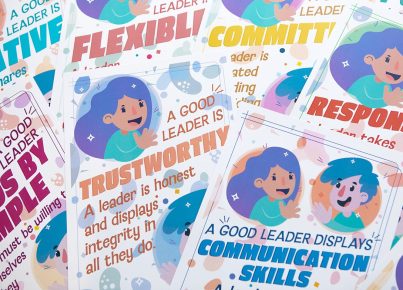
Leadership is a quality that is highly beneficial in every stage of…

The school staff room is where educators come together to relax, prep…
Introduction: As a teacher, it can be beneficial to understand what your…

Pedagogue is a social media network where educators can learn and grow. It's a safe space where they can share advice, strategies, tools, hacks, resources, etc., and work together to improve their teaching skills and the academic performance of the students in their charge.
If you want to collaborate with educators from around the globe, facilitate remote learning, etc., sign up for a free account today and start making connections.
Pedagogue is Free Now, and Free Forever!
- New? Start Here
- Frequently Asked Questions
- Privacy Policy
- Terms of Service
- Registration
Don't you have an account? Register Now! it's really simple and you can start enjoying all the benefits!
We just sent you an Email. Please Open it up to activate your account.
I allow this website to collect and store submitted data.
- Skip to primary navigation
- Skip to main content
- Skip to primary sidebar
Teaching Expertise
- Classroom Ideas
- Teacher’s Life
- Deals & Shopping
- Privacy Policy
15 Leadership Activities For High School: After School Programs, Games, And Discussions
March 17, 2024 // by Danielle Torpey
In a world that values productivity with creative collaboration–fostering leadership within students helps prepare successful leaders in society. In my classroom, it’s easy to pick out the few kids who have natural leadership abilities, which made me wonder: how do I allow opportunities for students to all foster elements of leadership?
High school students are no doubt the future leaders of our society. I knew that providing leadership opportunities through various activities by implementing an element of leadership in my lesson plan would promote growth in communication skills among all my students.
Below are fifteen different activities for teachers to implement in their lesson plans to help foster influential leaders within the classroom and in students’ post-graduate endeavors.
1. Establish a student timer
Time in the classroom is precious and most lessons have a time limit between transitions. Pick a student to be the “timer” for the day. They will be responsible for effective communication on the time left on a task. If you’ve allotted a five minutes time limit for a task to be completed, then your timer is the one who is responsible for keeping the class up to date on the remaining time and when that time has concluded. This is a simple way to give a student ownership and leadership situations to take charge.
2. A leader to pass out materials and paper
A simple activity to give kids the chance to take pride in a leadership role. If you have multiple handouts or materials for an activity, have a student or two be responsible for handing them out to everyone. This is also a great trick for your busy body students! Allowing them a quick minute to get up and move around the room before the next section of the lesson clears their brains and provides an aspect of leadership.
3. Create a student government
Within different activities and after-school programs consider establishing a student government that works alongside the adult sponsors. Leaders could be responsible for ice-breakers, team-building activities, and other activities for students. With a student government, their focus should center around the alliance of students within the school to promote school spirit and participation. This is a foundational practice and building block to establishing an inclusive school culture that is promoting the collective student body.
Learn More: Columbia Interschool Governing Board
4. Activity Roles
During lessons with small group discussions, give each member of the group a role to take ownership of. This allows for exposure to different styles of leadership, leadership behavior, and valuable skills that keep a discussion focused on the task at hand. On a sticky note or a blank piece of paper, write down the different roles each member of the discussion can take on. BONUS: this helps prevent picking a regular called-upon student and allows every student a chance to speak.
Learn More: University Of Waterloo
5. Tutoring programs
Allowing high school students to tutor middle school students is a great opportunity to add valuable tools to their leadership abilities. Plus, this is an excellent opportunity to boost a college application with leadership experience. Tutoring encourages leaders to establish their leadership styles on top of a leadership philosophy that suits their personality the best!
6. Peer mentorships
Down the same vein as tutoring programs, schools could consider a peer mentorship program to add positive aspects of leadership and interpersonal skills. This style of leadership pushes beyond the subject matter, and helps grow authentic leadership for teen mentors! An influential leader could help with struggling underclassmen, special needs students, at-risk students, etc.
7. Small group feedback
During class projects, have students take a piece of paper and provide feedback to their peers. Giving constructive feedback is a simple activity to encourage elements of leadership. Plus, successful leaders take feedback and weigh the viable options to make their work better! Creating a classroom that is centered around giving positive and regular feedback allows students to practice giving and receiving feedback in a controlled and constructive space.
Learn More: Room to Discover
8. Students lead after school program
If students have a particular interest in a topic or hobby encourage them to run activities for students in an after-school program who might show interest in the topic as well. It’s as easy as an announcement on the intercom and a sign-up sheet of paper for those who are interested too. Some of the after-school programs to consider include creative writing club, tabletop/board game club, gay-straight alliance, Spanish club, etc.
9. Teen advocacy campaign

School months are filled with opportunities for campaigns. Whether it’s mental health awareness month, teacher appreciation week, or homecoming–use different observed holidays and awareness dates for students to create and execute activities for students.
10. Give situational leadership journal prompts
Start the class off with a quick five-minute situational leadership journal prompt! Giving a journal prompt with questions such as, “Your best friend is bullying someone in the locker room, how do you handle this situation.” or “You’re the CEO of a new company and about to launch a new product that will change the world–what are the steps you take with your team” and so on. Let students think on their feet and map out their responses in their journal or a blank piece of paper!
11. Games that promote leadership qualities
Games in the classroom have always been a tide and true way to implement leadership skills. A classroom leadership game can help build trust within students and build a strong classroom culture!
Learn More: Vantage Circle
12. Independent Project-Based learning opportunities
Independent projects create a space for valuable skills when it comes to internal leadership and integrity. Sometimes the behavior of leaders starts from within! Project-based learning leads students to find internal motivation to do well on an assignment. Whether a formative or summative assignment, independent projects are a great opportunity to develop leadership skills.
Learn More: Crafted Curriculum
13. Scavenger hunt lesson

A scavenger hunt lesson is a great way to mix up instruction and allow activities for students to build leadership! Whether outside, within the school, or on an online scavenger hunt, students will think learning is a fun game! This is a great option for all ages and content across the board.
Learn More: 28 Ingenious School Scavenger Hunts For Students
14. Student leaders create a fun activity

Allow students to express their creativity with their mini-lesson. Small groups can plan a lesson focused on a particular concept you are covering in a unit. To push leadership skills further, the class can provide constructive feedback for the group that is taught!
15. Group Project-based learning opportunities

Want to incorporate project-based learning with a group? Similar to independent projects, creating a formative or summative assessment with groups encourages leadership amongst a group! You’ll be surprised how naturally students will start assigning each other tasks to get a project completed with accountability and reliability. Creative collaborations also allow space for constructive feedback!
Learn More: E Reading Worksheets
Final Thoughts
Whether fostering a natural-born leader’s talents or encouraging a student that needs help to develop their leadership style–giving opportunities in the classroom can be simple! Try out some of the different activities for teachers to implement in their lesson plans to help foster influential leaders within the classroom and in students’ post-graduate endeavors! You’ll be amazed how quickly students begin to foster skills!
83 Leadership Activities, Building Games, and Exercises

Leadership activities are associated with benefits to business, including increased performance and productivity.
However, perhaps the sign of a truly successful leader is a happy, healthy workplace. Interested in what leadership activities can do for your workplace or school? Read on.
With the activities below, there may be some overlap with activities found under certain headings – for example, activities suitable for adults may also be useful for groups, or with employees.
Before you continue, we thought you might like to download our three Positive Leadership Exercises for free . These detailed, science-based exercises will help you or others adopt positive leadership practices and help organizations thrive.
This Article Contains:
What are leadership activities, what are they used for, 8 examples of leadership activities, 4 leadership workshop ideas, 2 activities that showcase different leadership styles, 3 situational leadership activities and scenarios, 8 games and activities for kids to learn leadership skills, 6 leadership development activities for teens and youth (pdf), 3 classroom leadership activities for students in elementary and middle school, 6 leadership activities and games for high school students, 3 activities and exercises for college students (pdf), 7 leadership games and activities for adults, 5 leadership group and team activities, 8 leadership training activities for employees, 5 leadership building exercises for managers, 11 leadership exercises for team building in the workplace, a take-home message.
Increasingly, people are assuming positions of leadership in the workplace (Cserti, 2018). However, the journey to becoming a leader is lengthy (Cserti, 2018). Leadership activities are valuable on the journey to becoming an effective leader , and also develop confidence in leadership teams (Cserti, 2018; Stepshift, 2016).
Leadership activities may be conducted on or off site, and be physical or sedentary (Stepshift, 2016). Leadership activities can either be performed by a leader in their own team, or with an external facilitator (Cserti, 2018). They may take the form of specially organized themed events, such as scavenger hunts (Stepshift, 2016). Or, they may be smaller, office-based tasks built into an ordinary workday.
For example, leadership activities could consist of meeting openers or conference break activities (Stepshift, 2016).
Leadership activities can be an effective way for individuals to practice and strengthen their leadership and team-building skills (Cserti, 2018). They can also be fun!
The structure of leadership activities is essential. It is important that the participants can relate the activity to the workplace setting (Stepshift, 2016).
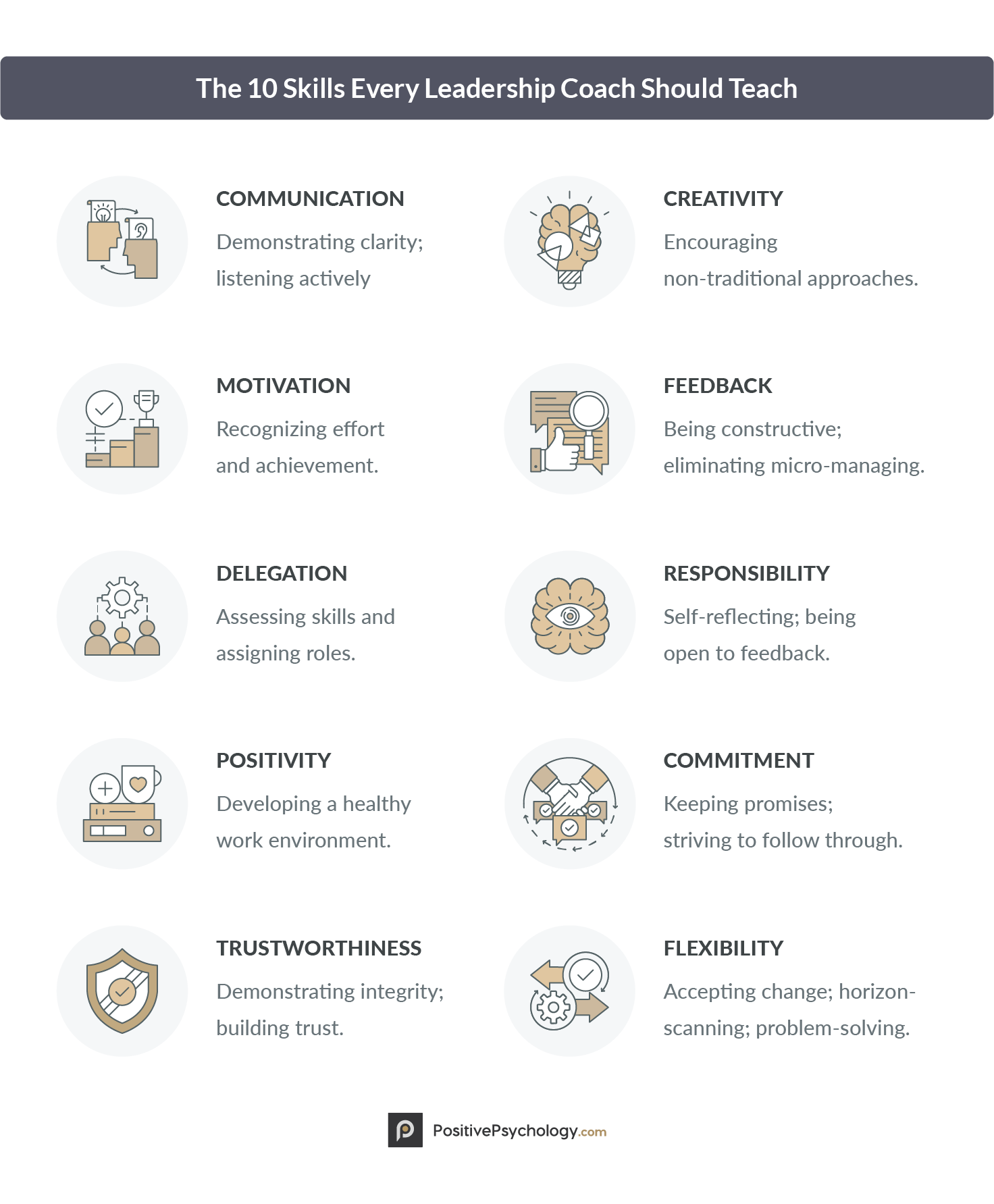
The working style, principles, and values of a leader is a crucial aspect in determining the behavior within an organization (Cserti, 2018). Leadership training can help leaders become role-models (Cserti, 2018). The behavior of leaders and what they consider the “norm” determines which behaviors are enforced and those which are punished (Cserti, 2018).
Given the importance of a leader’s behavior, it is also essential that they learn skills, such as:
Communication
Leaders need to develop the ability to clearly, succinctly explain to employees everything from the goals of a company to the details of specific work-tasks (Doyle, 2019). Many components are important for effective communication , including active listening, reading body language and written communication such as emails (Doyle, 2019).
Leaders need to inspire employees. They may do this by increasing worker’s self-esteem , by recognizing effort and achievement, or by giving a worker new responsibilities to further their investment in the business (Doyle, 2019).
Leaders can achieve this by identifying the skills that workers have, and as such assign tasks to each worker based on the skills they have (Doyle, 2019).
Being positive helps develop a happy , healthy work environment, even when the workplace is busy or stressful (Doyle, 2019).
Trustworthiness
By demonstrating integrity , workers will feel at ease to approach their leader with questions or concerns (Doyle, 2019). Building trust is one of the most essential leadership skills.
Good leaders are willing to try novel solutions or to approach problems in a non-traditional way (Doyle, 2019).
Leaders are constantly on the lookout for opportunities to provide team members with information about their performance, without ‘micromanaging’ their work (Doyle, 2019).
Responsibility
A good leader accepts mistakes or failures and instead look for solutions for improvement of a situation (Doyle, 2019). This skill also includes being reflective and being open to feedback (Doyle, 2019).
A leader should strive to follow through with everything that they agree to do (Doyle, 2019). It also involves applying appropriate feedback and keeping promises (Doyle, 2019).
Flexibility
Leaders need to be able to accept changes and creatively problem-solve, as well as being open to suggestions and feedback (Doyle, 2019).
While these skills are explained in a workplace context, they can easily be applied to other leadership situations such as sports or community groups.
Now that you have more clarity as to what leadership activities are, and what they are used for, let us look at a wide selection of activities. While some of the activities and games may not immediately appear to be ‘leadership activities,’ the chosen activities might develop and promote the leadership skills outlined above.
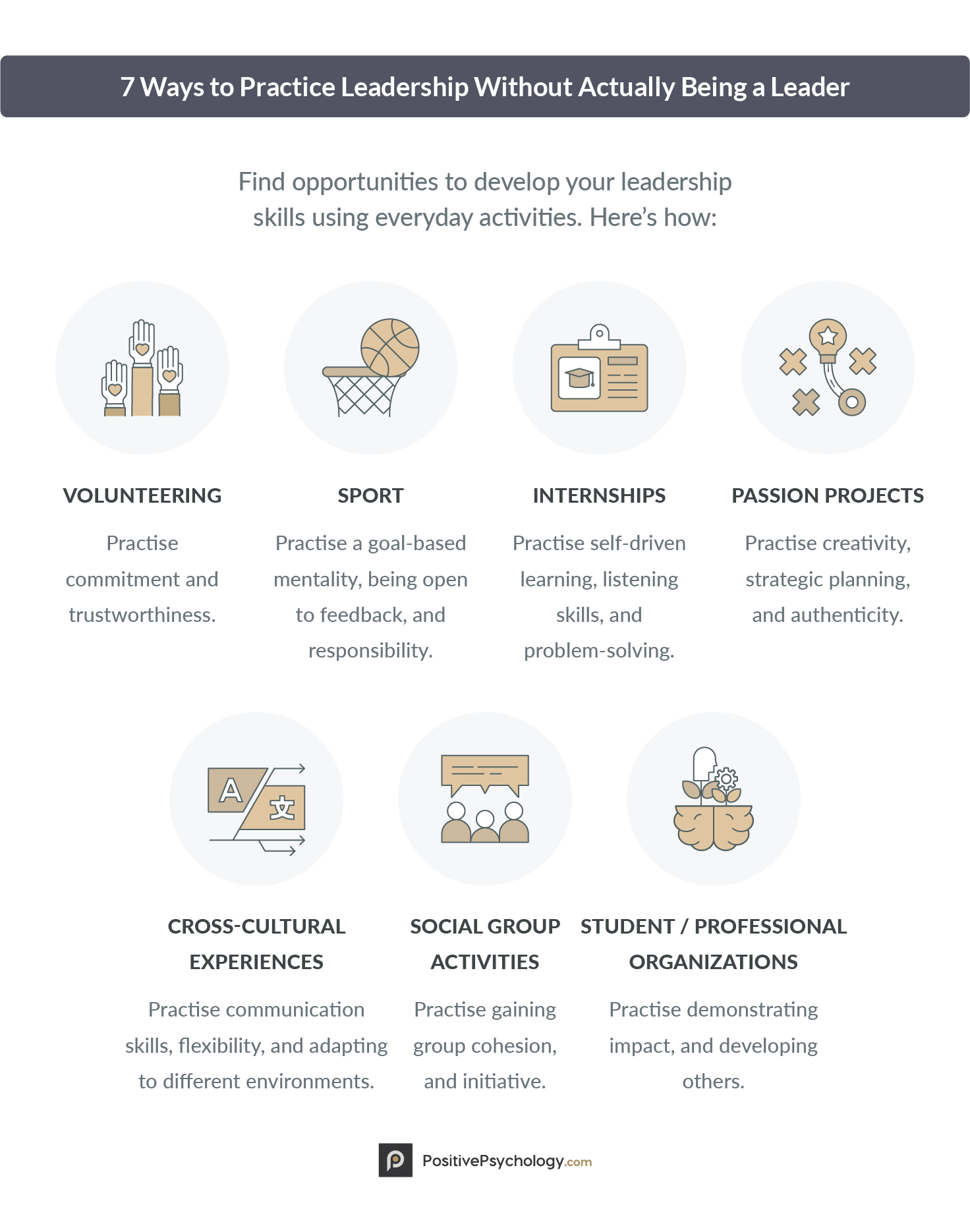
Here are eight such activities:
- Sports Sports provide the experience of being a team member and developing leadership skills (Flavin, 2018).
- Cross-cultural experience Experiences with a different culture provide new, potentially uncomfortable situations and help develop communication skills that may not be learned elsewhere (Flavin, 2018). Overseas travel, or working with a different cultural group within your community can provide an opportunity to learn new skills, or may involve barriers that must be overcome – all teaching leadership (Flavin, 2018).
- Social groups Involvement in social activities helps potential leaders develop a well-rounded, confident personality which enhances their capacity to lead a team (Flavin, 2018).
- Internships Taking an internship position demonstrates initiative in finding opportunities to learn and seeking practical work – valuable skills in leadership (Flavin, 2018).
- Volunteering As well as showing ambition, volunteering shows that you are willing to commit yourself to something that you are passionate about (Flavin, 2018).
- Student government and organizations Specifically considering students, being involved in co-curricular organizations help individuals develop leadership (Flavin, 2018). Being involved in student government or organizations can provide opportunities to demonstrate leadership and have an impact on those around you (Flavin, 2018).
- ‘Passion projects’ Showing commitment to a passion for better communities; for example, mentoring shows that you are likely to focus on the greater good for a team (Flavin, 2018).
- ‘Teamwork’ This can be anything at all, from helping out with planning a family event or participating in a volunteer day, will demonstrate and develop leadership skills (Flavin, 2018).

Download 3 Free Positive Leadership Exercises (PDF)
These detailed, science-based exercises will help you or others to adopt positive leadership practices to help individuals, teams and organizations to thrive.

Download 3 Free Positive Leadership Exercises Pack (PDF)
By filling out your name and email address below.
- Email Address *
- Your Expertise * Your expertise Therapy Coaching Education Counseling Business Healthcare Other
- Phone This field is for validation purposes and should be left unchanged.
Effective leaders are aware that continuing professional and personal development is the key to ongoing success (Higgins, 2018). As such, they recognize that leadership workshops are important (Higgins, 2018). What activities can be used in such a workshop?
Here are four suggestions:
Idea 1: ‘Tallest Tower’ (from Stepshift, 2016)
Participants are provided with everyday items such as toothpicks, wooden blocks, uncooked pasta and so on. The task is to build the tallest possible free-standing structure from the materials provided. This activity is designed to encourage creative problem-solving and developing collaboration skills.
Idea 2: ‘Centre Stage’ (from Higgins, 2018)
Select four team members as volunteers. One team member plays the role of an employee who has missed meetings or been late to work in recent times. Each of the other three participants demonstrates a different style of leader (to save time, nominate the particular personality trait). Ask all participants to form a circle, and put two chairs in the middle of the circle.
After each demonstration of how to deal with the employee, ask the whole group to reflect on the different leadership approaches. For example, the group could consider what worked and what did not. Finally, to conclude this activity, ask the group to consider what the ‘ideal’ leader would do in the scenario.
Idea 3: ‘Minefield’ (from Stepshift, 2016)
This activity helps build trust and improve communication skills. It involves participants working in pairs, with one team member being blindfolded. Then, using only specified communication techniques, the pair negotiate their way around or over a ‘minefield’ of obstacles.
So, for example, the participants may be told they are only able to use commands such as the words ‘left’ or ‘right,’ ‘forwards’ or ‘backwards.’ The aim is to help the blindfolded team member to navigate the ‘minefield’.
Idea 4: ‘Magic Carpet’ (from Higgins, 2018)
Provide a small tarp or rug, which has enough room for all workshop participants to stand within its boundaries. Then, inform the group that their task is to work together to flip the rug or tarp over without any participant stepping off. If (or when) a participant steps off the teams have discussed all of the paragraphs or tarp, the team must begin again.

These are: autocratic (also known as authoritarian), delegative (also called ‘free reign)’ and democratic (which is also called participative) (Clark, 2015; Johnson-Gerard, 2017).
An autocratic leader makes decisions without first consulting others, while a delegative leader allows the staff to make the decisions (Johnson-Gerard, 2017). Finally, a democratic leader consults with the staff in making workplace decisions (Johnson-Gerard, 2017).
Here is an excellent resource for exploring different leadership styles.
The workbook also provides some helpful worksheets.
The following two activities help participants think more deeply about styles of leadership. The group should be divided into small groups of 3 – 4 participants. The participants work in groups for the first activity, and then they work individually on the second activity.
Activity One (Clark, 2015)
Provide a list of approximately 10 – 12 scenarios displaying the three different leadership styles. For example, “a new supervisor has just been put in charge of the production line. He immediately starts by telling the crew what change needs to be made. When some suggestions are made, he tells them he does not have time to consider them”.
The group then works together to figure out which leadership style is used in each scenario and to talk about whether it is effective, or if a different style could work better.
Encourage participants to think about themselves in a similar situation and their reaction to the particular leadership style.
Activity Two (Clark, 2015)
Provide participants with the statement ‘consider a time when you, or another leader, used the authoritarian (autocratic), participative (democratic) or delegative (free reign) style of leadership’.
Ask participants to reflect on the statement and make a few comments, such as: was it effective? Would a different leadership style have worked better? What were the employees’ experiences? Did they learn from the leadership style? What was it they learned? Which style is easiest to use (and why)? Alternatively, nominate the style which the participant prefers (and why).
To conclude these two activities, come together as a whole group and discuss what was learned about the three styles of leadership.
Leadership building activities – Project management training – ProjectManager
Situational leadership is when a leader is flexible in their approach and uses different leadership strategies depending on the situation (Johnson-Gerard, 2017). The following three games, from Johnson-Gerard (2017) provide an opportunity to explore situational leadership:
1. ‘Jumping Ship’
The aim of this game is for participants to reflect upon different leadership styles and come up with a list of actual workplace scenarios which would need a leader to abandon a natural leadership style for one that is more effective (i.e., to ‘jump ship’).
Each group is given three large pieces of paper. Ask the teams to write one style of leadership on each (i.e., autocratic, delegative, democratic). Then, allow the groups 45 minutes to come up with real work situations for which employing the particular leadership style would be disastrous.
Ask the groups to place the sheets of paper up on the wall, and to discuss the sheets as a team. As a whole group, review the posters.
2. ‘Who Ya Gonna Call’
Each participant begins by writing a one-paragraph description of a work situation that is not going well. Collect these, and at the top of each page, number them in consecutive order. Then, divide the participants into two teams.
Give each team half of the paragraphs. Then, ask the teams to choose the style of leadership that would be the least and the most effective in solving the problem. Have the teams note their answers on a piece of paper, being sure to identify the paragraph number on the top of each page, and their choices.
Then, ask the teams to swap paragraphs and repeat the activity.
When the teams have discussed all the paragraphs, discuss the scenarios and review the choices as a group. Where the team’s choices are different, discuss as a group.
3. ‘Ducks in a Row’
This particular activity enables participants to devise a 3-to-5 step decision-making process they can use when challenging leadership situations occur.
Ask participants to form pairs. Then, ask them to come up with the steps that an effective leader goes through in order to work out how to manage a difficult situation. After about 30 minutes, ask each pair to review the steps they have come up with for the group, and to write them on a large piece of paper.
Ask every pair to review their process, and after all the pairs have done so, have a group discussion that enables a consensus to be reached about the three to five most effective steps to take in a difficult leadership situation.

Edsys (2016) provides eight suggested activities for children to learn leadership skills:
1. ‘Create a New You’
Provide children with materials such as textas, crayons, poster/construction paper, magazines, and scissors. Then, ask them to draw themselves, using things that clearly show that the picture is theirs – such as using cut-outs of their most favorite things to do, foods they like, pets, and whatever else makes them unique.
Once the children have finished their posters, they can show their completed work to the other children – helping kids to improve their confidence to lead.
2. ‘Same or Different’
The children sit in a circle. Ask the first child to point to another child in the circle who is similar to them, either in appearance, hair-style or clothing color. Then, when the child has chosen someone, ask them to note other differences and similarities they have with the child they have chosen.
3. ‘Move the Egg’
Ask children to form groups of four or five. Then, have the children select a leader for their team. Each participant is given a spoon and an egg. The leader has the task of finding an effective way to move the eggs from one point to another. For example, one option may be for children to form a line to pass each egg along.
Another leader may suggest forgetting about the spoons altogether and merely tell their group to make a run for it. The winner of the game is the group that can get their egg safely across the finish in the most creative way.
4. ‘Lead the Blindfolded’
This game requires a large indoor or outdoor area. Divide the children into two groups and give them enough blindfolds for everyone except one member to put on. The teams are placed at opposite sides of the space. The child who is not blindfolded is required to lead their team to the other side of the designated space, using clear commands.
Ensure that each member of the team has an opportunity to lead their team. The winner is the team that sees its members successfully cross the finish line.
5. ‘Charity Support’
Help children support a charity by organizing a fundraiser. Each child can have a different task. For example, one child may select the charity, another may find a suitable space to hold the fundraising activity, and another child can collect donations.
6. ‘Planning Strategies’
Teach children to divide a large task into smaller steps. Set the children a large task, such as holding a class function. Show the children a plan that enables them to achieve the task step by step. This activity can involve a number of children sharing tasks. Suggest to the children how they may be able to improve.
7. ‘Volunteer Roles’
Volunteering plays a role in leadership. Discuss with children how they would like to help someone in need. Older children may be interested in taking a role in an organization in their community. The children should be helped to select a volunteer opportunity that gives them a chance to practice leadership and work with other children.
8. ‘A Quick Quiz’
In this task, ask students to be prepared to evaluate an experience when it is over. Then, after the experience, ask the child questions. For example, inquire “Do you remember the name of the dog we saw?”, “What was it?”, “Did you touch the dog?”, “What is the owner’s name?” and so on.
This is an excellent introduction to leadership for kids in grades 4 – 6 (children aged approximately 9 – 12 years).
The following resources are appropriate for helping teens and youth to develop leadership:
1. “Leaders are, can, and think”
This looks at what a leader is, and what their role can and should be.
2. “Who do you admire and why?”
This worksheet examines leadership role models and the qualities we see in them that we want to develop in ourselves.
3. “4 Ways leaders approach tasks: Leaders Motivation”
This handout focuses on leadership attitude.
4. “Lesson Planet”
Links to 45+ reviewed resources for teen leadership which can be accessed free by registering your details.
5. The Women’s Learning Partnership
This partnership has created a comprehensive manual for promoting leadership for teens aged 13 – 17 years. The manual outlines a number of sessions which guide leadership development activities.
6. “I Care Values Activity”
This is a fun, engaging and introspective activity . It is suitable for students aged 13 and upwards, so it can be used with older students or adults too.

Examples of such activities are:
1. ‘Just Listen’ (Edsys, 2016)
Make an agreement that you and the student(s) will refrain from talking about yourselves for a whole day. Ask them, rather, to listen to others, and if they do talk to another person, it should be about the person whom they are talking to. This game helps children to learn how important it is to focus on other people rather than themselves, which forms the basis of ‘relational leadership’.
2. Silence Classroom Leadership Game (Stapleton, 2018).
To begin the activity, the teacher divides students into two teams, and the teams move to either side of the classroom. The desks may be pushed aside to create more space. The teacher instructs the students to, for example, ‘line up according to the first letter of your surname’ or ‘arrange yourselves into age order by the month your birthday is in’. The students then follow the directions without speaking a word to one another.
Students are permitted to use hand signals, or even write instructions down on paper. The teacher’s instruction to the students is that they are not allowed to talk. The winning team is the one that completes the task successfully.
3. ‘The Cup Game’ (Tony, 2018)
Divide students into pairs and select one student to be the leader. Each team should face each other standing up, with a plastic cup in the middle. The leader calls out simple directions, such as ‘touch your knee’, ‘close one eye’ and so on.
When the leader calls out “cup” the students should try and be the first to grab the cup. The player who successfully grabs the cup should pair up with another player who also got the cup. Those without a cup sit down and watch.
Once the new teams of two have formed, the cup is put in between the players and the game begins again. This process continues until only one person is left standing – and the resulting winner becomes the new leader… and play can begin all over again.

World’s Largest Positive Psychology Resource
The Positive Psychology Toolkit© is a groundbreaking practitioner resource containing over 500 science-based exercises , activities, interventions, questionnaires, and assessments created by experts using the latest positive psychology research.
Updated monthly. 100% Science-based.
“The best positive psychology resource out there!” — Emiliya Zhivotovskaya , Flourishing Center CEO
By high school, students are more sophisticated. Here are some interesting activities for high school students to develop leadership.
1. Brainstorming for change (Stapleton, 2018)
The teacher puts students into groups of 4 or 5. The goal is for students to come up with possible solutions to social, political or economic problems. Working together, students brainstorm both small- and large-scale solutions to a given problem topic.
Once the groups have finalized their list of detailed solutions, the teacher facilitates a discussion with the whole class, and together they examine which of the identified solutions could be a viable option and why.
2. Leadership characteristics (Stapleton, 2018)
The teacher puts students into pairs or groups of three. Then, each group member shares a story about someone whom they consider to be an influential leader. After each story has been shared, students discuss the characteristics that they think made the person in the story an effective leader.
Once each student has shared a story, students compile a list of all the characteristics of an influential leader they identified. Post these characteristics on the walls around the classroom.
3. Blindfold leader game (Stapleton, 2018)
The teacher arranges the students into a single line, and comes up with a starting point and finishing point. Then, the teacher places a blindfold on every student except for the student who is at the front of the line.
The teacher tells each student to put their left hand on the left shoulder of the person in front of them. Next, the teacher says “go”. The aim is for the leader (who is not blindfolded) to walk towards the finishing point, providing instructions to students behind, who are blindfolded.
An extra challenging game sees the teacher putting obstacles in the path – the leader must direct followers on how to avoid the obstacles and successfully reach the finish line. When this goal is achieved, a different student takes a turn of being the leader.
4. Buckets and balls (Cohen, 2017)
This game aims to move all the balls from one box to another. The catch is, team members cannot use their hands or arms. In equal-sized teams, players choose one ‘handler’ per team. This is the only person who can touch the balls with their hands.
The handler must remain behind the start line throughout the game. Team members attempt to get balls from their bucket at the finish line, and get them to the team’s handler without the ball touching their hands or arms.
The handler places the balls into the empty bucket at the start line. If a team member touches the ball, they are disqualified and can no longer participate. Give teams a 5-minute time limit. All teams play at the same time, and the team that has the most balls in the handler’s bucket at the end of the game wins.
5. Team jigsaw (Cohen, 2017)
Two teams have to complete a jigsaw puzzle within a 20 – 30-minute time limit. Give each team a box containing a puzzle. At first, A body will assume that their task is to complete the puzzle. As they work on it, however, teams will realize that the puzzle is missing some of its pieces and has some additional pieces that do not fit their puzzle.
Teams then have the task to communicate with one another, and they will eventually realize that they need to work together to complete the puzzle. Teams are only allowed to exchange pieces of the puzzle one at a time.
6. ‘Sneak-a-peak’ (Cohen, 2017)
Divide participants into two teams. Build a structure out of Lego. Make it complicated, but able to be replicated. Ensure that there is sufficient Lego left to build two similar copies of the structure.
Make sure that this structure is kept out of eyesight.
A player from each team is allowed to see the structure for 10 seconds. Then, the players will return to their respective teams and have 25 seconds in which to give his/her team instruction as to how to build the structure. Then, the teams have 1 minute to build the structure.
When that minute is up, another team member takes a look at the structure for 10 seconds and has a further 25 seconds to deliver their instructions to their team.
This process continues until all the team members have had a chance to examine the structure and provide instructions. The team that successfully built the structure is the winner.

- “ The Leadership Training Activity Book ” by Lois. B. Hart and Charlotte S. Waisman (2005) contains 50 handouts for leadership activities that would be suitable for college students. Find it on Amazon .
- This resource provides helpful leadership tip sheets that are suitable for college students. Examples of tip sheets are “ten keys to effective listening” and “basic confrontation guidelines”.
- Another valuable resource that can be used to develop team-building – an aspect of leadership.
A wide range of leadership activities are suitable for adults:
1. The Marshmallow Challenge
In this activity , teams use spaghetti sticks, tape and string to construct the tallest free-standing structure. They are given one marshmallow, which must be placed at the top of the structure. Devised by Tom Wujec.
2. ‘Stand up’ (Landau, 2018)
This game is convenient in that it requires no materials. It involves two people. They sit on the floor, facing one another. They hold hands, and the soles of their feet are placed together. Then, the task is for both people to stand up at the same time. This game builds trust and teamwork, and also develops skills in problem solving and collaboration.
3. Zoom (Stepshift, 2016)
A set of randomly provided sequential pictures are given to the participants. The task requires participants to put the pictures in the correct order to recreate the story, without knowing which pictures the other participants have. This activity can be an effective way to improve communication, patience, and tolerance.
4. ‘You’re a Poet’ (Landau, 2018)
To harness creativity and reflect on leadership concepts, one activity for adults is to write a poem. This activity can be done individually or in small groups. The aim is to consider leadership in creative ways to find new perspectives.
5. ‘Leadership Pizza’ (Cserti, 2018)
This activity can help adults develop leadership. It does so by providing a self-assessment tool. People begin by identifying the skills, attitudes, and attributes that they consider being important for successful leadership. The individual then rates their own development in the defined areas. The framework can also provide a helpful tool in assisting adults in identifying their leadership development goals in a coaching session.
6. Leadership advice from your role model (Cserti, 2018)
Each participant considers a role model who they admire. They then think about a young person they know. If the young person was to ask the role model for leadership advice, what kind of advice would the role model give?
In groups, discuss and share the sort of advice identified and talk about contradicting points and how they can be reconciled. This sharing discussion may be a practical introduction to the idea of situational leadership.
7. ‘Crocodile River’ (Cserti, 2018)
This outdoor activity challenges a group to physically provide support to the group members’ behavior move from one end of a designated space to the other.
Participants are told to pretend that the whole team must cross a wide river which contains dangerous crocodiles. Magic stones (which are represented by wooden planks) provide the only supports to be used to cross the river (which has ‘banks’ that are marked out by two ropes).
These ‘stones’ only float on the water if there is constant body contact. These ‘stones’ (i.e., the wooden planks) are placed next to the ‘river bank’ – there should be one less plank than the total number of participants. As part of the game, if a participant’s hand or foot touches the ‘water’, it will be bitten off (if this happens during the challenge, the participant must hold the hand behind their back).
The facilitator then pretends to be the ‘crocodile’, keeping a close eye on the group as they attempt to cross the river. When one of the stones (the planks) is not in body contact, it is removed. When participants mistakenly touch the ground with their hands or feet, tell them that the limb has therefore been bitten off and the player must continue without using it.
This activity continues until the group succeeds in getting all group members to the other side of the ‘river’. If anyone falls in, the group is deemed to have failed, and they must begin the river crossing attempt again.
1. ‘Feedback: Start, Stop, Continue’ (Cserti, 2018)

Openness creates trust, which then promotes further openness. This activity is designed to be used by a group that has spent sufficient time together in order to have a range of shared experiences they can draw from when they are providing feedback.
Each participant takes a post-it and writes the name of the person who they are addressing on it. Then, they write on the post-it:
“To…. Something I would like you to START doing is…. something I would like you to STOP doing is…. something I would like you to CONTINUE doing is……Signed: ___________”
In groups of around 4 to 6 people, participants complete these sentences on one post-it for the other participants in their group.
If they cannot think of relevant feedback for one of the prompts (i.e., start, stop, continue), they do not need to include it. Once the group has finished writing, they provide the feedback verbally, one at a time, and afterward hand the post-it to the relevant person.
2. Round Tables (Stepshift, 2016)
Four tables are set up with different tasks. Each task has separate steps that participants can be responsible for carrying out. The group select a team member, who is only allowed to communicate and delegate tasks but not take a part in the task. Each table is timed to record how long the task takes to be completed. Round Tables improves leadership and delegation skills.
3. ‘Pass the hoop’ (Landau, 2018)
This game requires participants to stand in a circle and hold hands. One person in the group has a hula hoop around their arm. The game aims to pass the hula hoop the whole way around the circle.
As well as promoting teamwork and problem-solving, this game develops communication skills. Being able to communicate effectively is a crucial skill for any successful leader to have.
4. ‘Improv night’ (Landau, 2018)
One key responsibility of the leader of a team is to encourage team bonding. One way to facilitate bonding is improvisation. ‘Improv’ develops skills in communication – helping teams to listen and pay attention. It also builds self-awareness, self-confidence, and creativity.
Arrange the group into ‘audience’ and ‘performers’. Then, members of the audience take turns in calling out the specified location, profession, and scenario (e.g., coffeehouse, cop, and purchasing a donut). Chosen suggestions are fun and should promote creativity.
5. ‘Shape-Shifting’ (Landau, 2018)
This game requires a rope that is tied at both ends to form a loop. The loop needs to be big enough for all group members to hold onto with both hands as they stand in a circle. The group is instructed to make a chosen shape (e.g., circle, square, triangle). The group attempts to create the shape on the floor.
Progressively, ask the group to make more complex shapes – e.g., a dog, or a tree. To add another layer of difficulty, instruct the team to communicate without talking – i.e., to rely on hand gestures. Afterward, have the group reflect on their experience and discuss the importance of communication.
Leadership is an integral feature of any workplace. Here are some activities to promote leadership in employees:
1. Your favorite manager (Cserti, 2018)
To begin this activity, employees individually take the role of three different people and brainstorm the particular behaviors that each person’s most favorite and least favorite managers demonstrate, from the chosen person’s perspective. After the employees have had the chance to reflect, the participants compare their list of behaviors – in pairs, and then subsequently, in groups.
The teams then prepare a list of ‘dos and don’ts’ for developing better employee perceptions of the leader’s style.
2. Explore your values (Cserti, 2018)
The values of a leader are reflected in their organization. In this activity, each participant writes ten things that they value most in their lives, each one on a post-it. Then, ask the employees to spread the Post-its in a way in which they can see them all clearly. Then, explain to them that they will have 30 seconds to select the three Post-its that are of least importance to them.
It is essential to time strictly, so that the participants rely on their gut feelings.
Repeat the process, this time allowing participants to have 20 seconds to discard two more values. Finally, give the participants a further 20 seconds to throw another two away. Participants should have three Post-its in front of them, showing their top three important values.
Following the activity, have participants reflect individually for about 15 minutes about what was found, and then to discuss reflection questions in pairs or groups of three.
Because this activity is done quickly, participants are encouraged to follow their own intuition – rather than over-thinking and finding what they perceive to be the ‘right’ values.
3. ‘Leadership Coat of Arms’ (Cserti, 2018; Landau, 2018).
Each leader has their own values and the things that they consider valuable and important. These values guide the behavior of the leader and make up a person’s unique leadership philosophy.
This activity sees participants drawing their own ‘leadership coat of arms’ embodying their leadership philosophy.
Individuals have 10 – 15 minutes to draw their coat of arms. They can divide the coat of arms (or ‘crest’) into four sections. To fill each section, consider the categories of leadership skills, values that help influence others, recent achievements/accomplishments and what you like most about your current work.
They should be encouraged not to be overly concerned with how visually appealing their picture is but rather that it expressed what they personally believe to be important aspects of a leader.
Once the drawings are complete, the participants can show their drawings to the others in the group and explain their unique coat of arms. It is also helpful to reflect on the activity – consider which section was easiest to complete and whether your crest reflects your company’s values.
4. Communication: Coach the Builder (Goyette, 2016)
Divide employees into groups of four to seven people. Each group should be given two sets of blocks (such as Lego). Each set should have a minimum of 10 blocks.
Beforehand, you should construct a sample object (e.g., a house) from one of the sets of blocks. In each group, select a leader, a delegator, a builder and a note-taker. The note-taker watches and records the group’s behavior during the task. They take note of what appeared to be done well and how employees could improve.
The leader is given the item that you built – however, they are the only group member to see the object. Set a timer for ten minutes. To begin with, the leader describes to the delegator how the builder should build a replica of the item. However, the delegator does not see the object, and at this stage of the activity, the builder should not hear the instructions.
The delegator can speak with the leader as often as necessary during the 10 minutes. The builder attempts to build the same item that the leader can see. However, they are only relying on the delegator’s instructions. At this stage, the delegator should not see the object that the builder is constructing.
When the time is up, reveal both objects to all participants and see how closely they match. Finally, to wrap up the activity, employees can discuss what was either frustrating or easy about the process and discuss how they may do things differently in order to achieve better results.
5. Accountability (Goyette, 2016)
Begin a meeting by saying to the group – “the seating arrangement is totally wrong for today’s meeting. You have 60 seconds to improve it”. If the employees ask further questions, only repeat the instructions. While some employees may continue asking questions, others may start moving the furniture around straight away. Observe the team and what they do without giving any further information, feedback, or instructions.
After 1 minute, let the employees know to stop. Then, ask them whether the objective was achieved, and how. Discuss with employees how and why a lack of clarity makes it challenging to complete a task.
Then, discuss who asked for clarification and how they felt when the leader refused to give further details. Use this opportunity to highlight to employees how if they fail to ask questions, and when the person in charge of a project doesn’t provide the necessary clarification, the whole team is at risk of making mistakes or even not completing a task.
Finally, ask how the time pressure affected behavior. Discuss how employees may be more likely to respond to pressure, or stress, by taking action without first confirming a plan and the significant problems this approach can lead to.
6. The “what if” game (Deputy, 2018)
Present different hypothetical problematic scenarios to employees. Either individually or by providing a document that requires written answers, present situations such as “you didn’t follow the rules, and subsequently lost an important client. You have lost a lot of money for the company. How do you justify this? What is your solution?”.
The questions only need to be rough, and employees should only receive a short time with which to think of their responses. If there is a particularly challenging question, provide a time limit of five minutes.
7. ‘Silver Lining’ (Cohen, 2017)
Employees form teams of at least two people who have shared a work experience – e.g., working on a project together. One person shares an experience from working together that was negative for them.
Then, the second person reflects on the same experience but instead reflects on the positive aspects of the experience (i.e., the ‘ silver lining ’). Then this same person shares their own negative experience, and this time it is up to the other person to focus on the positive aspects of it.
Often, when people reflect on an experience, they do so with a particular perspective . By looking at the positive aspects of a ‘negative’ experience, this helps individuals shift perspectives. Furthermore, by sharing experiences, employees develop deeper relationships, and team bonding is promoted.
8. My favorite brand (Training Course Material, n.d.).
Ask employees to bring three or four printed logos/brands that they use regularly or admire most. Then, form groups of 3 – 4 people. Teams have a period of ten minutes to share and discuss their chosen logos.
Their task is to agree upon the team’s top 2 logos or brands which is their team’s choice. The team also selects a team spokesperson who will report to the bigger group about why the team chose the specific brands/logos.
Participants are encouraged to share personal experiences or stories that they had with their chosen brand. After the ten minutes elapses, each spokesperson presents the logos that the team began with as well as their two top chosen logos/brands. It is their role to explain to the group why the team voted on their top brand/logo.
1. Manager or leader? (Training Course Material, n.d.)

Small groups of managers work together to create two tables, one titled ‘leader’ and one titled ‘manager’. In each table, the group writes statements describing either management behavior or leadership behavior.
For example, the ‘manager’ table may contain statements such as “schedules work to be done” or “delegates tasks”. On the other hand, statements in the ‘leader’ table could be “motivating staff” and “creating culture”.
The purpose of this activity is to demonstrate to managers the difference between management versus leadership, and show that while ‘every leader can be a manager, not every manager can be a leader’. However, by brainstorming leadership behaviors, managers begin the process of becoming a successful leader.
2. The race of the leaders (Deputy, 2018)
This activity encourages leadership behaviors. To begin with, write a list of leadership qualities – approximately 10 – 20 statements – on a piece of paper. Describe the qualities – e.g., ‘I determine everything that happens to me’, and ‘I will not blame others for my problems’.
Read these statements out loud, and participants take a step forward if they believe a statement describes them. They must be prepared to give reasons as to why they think they possess each quality. Continue reading the statements until there is a definite ‘winner’.
3. The best team member (Training Course Material, n.d.).
Divide the group into teams of about 4 – 5 participants. Give each team a large, blank piece of paper and markers. Each group has the task to come up with as many characteristics of their ‘ideal’ team member as they can. Teams should consider what this ‘best team member ever’ would be like.
After ten minutes, the groups should examine the characteristics that they have written and work out the portion which are ‘technical’ skills and those which are ‘interpersonal’. The aim is to work out whether most of the traits can be classified as technical or interpersonal skills.
Teams usually come to realize that interpersonal skills in employees are especially critical and that these have a tremendous impact on the quality and quantity of workplace performance.
This activity can be adapted according to the setting. For example, if the focus is on leadership development, teams could discuss their ideal leader/supervisor.
4. The importance of feedback (Training Course Material, n.d.).
Divide the group into three teams. Provide each team with poster paper and markers or pens.
Team A is required to consider as many reasons as they can that would make them apprehensive to provide feedback to another person.
Team B is asked to consider what feedback can help them so, i.e., what feedback will help them accomplish.
Team C comes up with as many things as they can that would make a feedback session effective.
Each team has 15 minutes to brainstorm their ideas, then, each team can present their ideas.
Point out to Team A that the hurdles they suggested are self-imposed ideas that will lead to the manager fearing the worst. Instead, managers should be encouraged to share feedback on a more regular basis to gain the necessary experience in having such conversations. Furthermore, by having an awareness of the most effective way to prepare and deliver feedback can help a manager conquer the issues holding them back.
Point out to Team B that providing constructive feedback as needed is imperative for developing a productive work environment. A feedback discussion that is well-planned and thought out delivers an opportunity to share what you have noticed about another person’s job performance and bring about productive change.
Finally, after Team C has shared their ideas, point out that effective feedback is specific, honest, and backed up with evidence. The feedback will help others to come up with goals, make and reinforce positive changes, promote self-confidence and encourage action in the workplace.
Thank all the teams for their participation and input.
5. ‘Shark Tank’ (Deputy, 2018).
This activity is derived from a famous TV show that gives people a chance to show their entrepreneurial skills. Managers may work individually or in groups. The aim of this activity is for employees to come up with a business plan that outlines the steps of how to build a successful company from ‘startup’.
Once the managers have a plan, they can create a ‘pitch’, which should contain the brand’s name, its’ tagline (or slogan), a detailed business plan, a detailed marketing plan, financial predictions (sales, profits and market) and potential problems (competition, lack of resources).
In a role play, appoint a few chosen managers to be the ‘sharks’ (the ones who consider the projects’ merit and offer imaginary ‘investments’). The winning group, or individual, is the one who raised the most money from the ‘shark’.

17 Exercises To Build Positive Leaders
Use these 17 Positive Leadership Exercises [PDF] to help others inspire, motivate, and guide employees in ways that enrich workplace performance and satisfaction. Created by Experts. 100% Science-based.
1. The Human Icebreaker (Stepshift, 2016).
This is a simple activity that can alleviate tension and promote discussion and contribution. Participants devise a list of questions that relate to people generally – for example, “who is left-handed?”. Participants then discover which team members meet the question’s criteria. After 10 minutes, the participant who has the most answers wins. This activity promotes communication and helps team members build inter-personal skills.
2. ‘Office trivia’ (Cohen, 2017)
This quick activity can help as an ice-breaker and provides a flexible option for team building. Create a list of trivia questions that are related to the workplace. For example, “how many people named ‘John’ work in the accounting department?” or, “how many people work in the IT department?”. Read the questions out loud to the whole group. The employee with the most correct answers at the end is the winner.
3. Plane crash (Stepshift, 2016)
The participants imagine that they are on a plane which has crashed on a deserted island. They are allowed to select a specified number of items from around the workplace that would help the group to survive. Each chosen item is ranked in importance. The whole group must agree on their decision. This activity helps with creative problem solving and collaboration.
4. ‘Magazine story’ (Cohen, 2017)
Each team works together to come up with an imaginary cover story of a magazine, about a successful project or business achievement. The team designs the images, headlines, and come up with quotes.
5. The Human Knot (Stepshift, 2016)
Relying on cooperation, this is a good problem-solving and communication activity. Participants stand shoulder to shoulder in a circle. Then, they put their right hand in the hand of a person who stands across from them. They then put their left hand in the hand of another different person (but not someone standing directly next to them).
Participants are required to untangle the human knot without breaking the chain. If the chain is broken, the participants must start over.
6. Make your own movie (Cohen, 2017)
This is a fun activity that is suitable for both indoors and outdoors. Although it requires the necessary equipment (i.e., camera, tripod, and microphone), teams enjoy it. Employees should work in large groups (more than eight people) and divide responsibilities. Teams work together to come up with scripts for a 5 – 7-minute movie.
7. Radio Play (Cohen, 2017)
This activity can provide an alternative to making a movie. Employees work together, spending about one-hour planning and writing a play and taking a further 15 – 20 minutes to ‘perform’ it, keeping in mind that it is designed for radio.
Each participant places their chair, in no particular order, around the room. The room should be cleared of tables and other furniture. Each person should sit on their chair, pointing in a different direction. Then, request one manager to volunteer and come to the front of the room. Their task is to walk slowly back to their empty chair and sit down.
If their chair is occupied, they can move to the next empty chair available and sit on it. However, everyone else has the task of stopping the volunteer from sitting down.
Only one person at a time can stand and move. No one can make two consecutive moves. A person cannot sit on the chair that they have just left. Once the activity begins, the room is required to be silent. No one is allowed to touch the volunteer.
Give the managers 2 minutes to come up with their strategy. After every round, the participants should discuss what happened and select a new volunteer for the next round. The team is given 2 minutes preparation time each round. It is important that the volunteer’s movement is kept at a slow walk.
At the conclusion of the activity, it is beneficial for the team to discuss the activity. They may reflect upon whether they need a leader, what made planning difficult, whether everyone agreed on the plan, and what would make the task easier.
9. Back to back drawing (Cohen, 2017)
Provide vector shapes on separate pieces of paper (they can be shapes of signs, objects or merely abstract shapes). Participants sit in pairs, back-to-back. Employee A is given a sheet of paper and a pen, and employee B is provided with one of the printed shapes.
The aim of the activity is for employee A to draw the shape relying only on verbal instructions from employee B. Person B cannot only tell the other person what the shape is – he/she is only able to provide directions about how to draw it, or to describe its uses. Each team has two 2 minutes to draw the shape.
10. ‘All Aboard’ (Stepshift, 2016).
Teams use various materials, for example, pieces of wood or mats, to build a pretend ‘boat’. All the participants must stand on the ‘boat’ at once. Then, pieces of the ‘boat’ should be removed. The team should still strive to stand in the diminished space on the ‘boat’. All Aboard can promote communication, problem-solving and critical thinking.
11. Body of words (Cohen, 2017)
Participants are divided into teams of between four and eight people, and each team elects one leader. To prepare the activity, record words that have one less letter than the number of people in the team (i.e., if there are five people in the team, a suitable word could be ‘book’ which has four letters). Randomly select a word, and then the teams have the task of making the word using only their bodies.
Each team member moves and bends their body to form a letter. The team leader can direct their team.
What stands out to me from this article is the complexity of leadership. This article demonstrates that even if one is not a ‘natural’ leader, there are plenty of activities that can promote leadership skills. Even children can develop leadership, and what’s more, have fun with activities at the same time.
What do you think espouses leadership? Do you think that there are people who might tend to be leaders more than others? Perhaps you have a story about a leadership activity you have participated in or delivered – I would dearly like to hear about your experiences.
Thank you for reading.
We hope you enjoyed reading this article. Don’t forget to download our three Positive Leadership Exercises for free .
- ‘tony’ (2018). Leadership games and activities for middle school students . Retrieved from https://www.kidsactivties.net/leadership-games-activities-for-middle-school-students/
- Clark, Donald (2015). Leadership Styles Activity . Retrieved from http://www.nwlink.com/~donclark/leader/styles.html#google_vignette
- Cohen, Esther (2017). 31 Team building activities your team will actually love . Retrieved from https://www.workamajig.com/blog/team-building-activities
- Cserti, Robert (2018). 12 Effective leadership activities and games . Retrieved from https://www.sessionlab.com/blog/leadership-activities/
- Deputy (2018). 6 Impactful leadership activities to try at work . Retrieved from https://www.deputy.com/blog/6-impactful-leadership-activities-to-try-at-work
- Doyle, A. (2019). Top 10 leadership skills employers look for . Retrieved from https://www.thebalancecareers.com/top-leadership-skills-2063782
- Edsys (2016). 1 0 Activities for teachers to grow leadership skills in children . Retrieved from https://www.edsys.in/10-activities-for-teachers-to-grow-leadership-skills-in-children/
- Flavin, B. (2018). 8 Leadership Experiences You Didn’t Know You Already Have . Retrieved from https://www.rasmussen.edu/student-experience/college-life/leadership-experience-you-didnt-know-you-already-have/
- Goyette, P.(2016). 3 Leadership activities that improve employee performance at all levels . Retrieved from https://eaglesflight.com/3-leadership-activities-that-improve-employee-performance-at-all-hierarchical-levels/
- Higgins, R. (2018). 5 Fun and Inspirational Leadership Workshop Ideas . Retrieved from https://www.eventbrite.com.au/blog/leadership-workshop-ideas-ds00
- Johnson-Gerard, M. (2017). Situational Leadership Games . Retrieved from https://bizfluent.com/list-6762581-situational-leadership-games.html
- Landau, P. (2018). The 9 best leadership games for skill development . Retrieved from https://www.projectmanager.com/blog/the-9-best-leadership-games
- Stapleton, S. (2018). Leadership activities for High School classrooms . Retrieved from https://classroom.synonym.com/leadership-activities-high-school-classrooms-7855904.html
- Stepshift (2016). Leadership Training Activities . Retrieved from https://www.stepshift.co.nz/blog/developing-team-performance-with-senior-leadership-teams/strategic-planning-with-an-independent-facilitator/leadership-training-activities.html
- The Pennsylvania State University (2012). I can be a leader! Leadership fun for children . Retrieved from https://extension.psu.edu/programs/betterkidcare/knowledge-areas/environment-curriculum/activities/all-activities/i-can-be-a-leader-leadership-fun-for-children
- Training Course Material (n.d.). Leadership and management activities . Retrieved from https://www.trainingcoursematerial.com/free-games-activities/leadership-and-management-activities
Share this article:
Article feedback
What our readers think.
This great. Thank you
Great ideas, thank you!
Thank you so much for providing such a useful list of activities to demonstrate and for such a varied target population. Innovative and attention-seeking exercises yet practical.
Thank you for posting this informative blog. keep sharing.
Too interesting for me to try all.
Same here.I think this was the best blog I have ever read.
Great article! Having group activities Melbourne helps the team to enhance working together. I love how it brings people together and motivates employees to learn from each other.
Great activities. Thank you.
This is an excellent article for every manager and leader tn build successful leadership. Thank you.
Let us know your thoughts Cancel reply
Your email address will not be published.
Save my name, email, and website in this browser for the next time I comment.
Related articles

8 Leadership Assessment Tools to Uncover Hidden Strengths
Leaders are everywhere: they help build organizations, steer institutions, and govern our societies. Yet recent governmental and organizational scandals across the globe highlight a worrying [...]

Theory X and Theory Y (& Z): Employee Motivation Explained
Most leaders and managers are aware of the importance of motivating their employees and creating an environment for them to perform at their best (Sennewald [...]

Contingency Theory: Mastering Leadership Flexibility
While most of us would recognize a great leader, few of us know what it takes to become one (Hill et al., 2022). And it’s [...]
Read other articles by their category
- Body & Brain (52)
- Coaching & Application (39)
- Compassion (23)
- Counseling (40)
- Emotional Intelligence (22)
- Gratitude (18)
- Grief & Bereavement (18)
- Happiness & SWB (40)
- Meaning & Values (26)
- Meditation (16)
- Mindfulness (40)
- Motivation & Goals (41)
- Optimism & Mindset (29)
- Positive CBT (28)
- Positive Communication (23)
- Positive Education (37)
- Positive Emotions (32)
- Positive Leadership (16)
- Positive Parenting (14)
- Positive Psychology (21)
- Positive Workplace (35)
- Productivity (16)
- Relationships (46)
- Resilience & Coping (39)
- Self Awareness (20)
- Self Esteem (37)
- Strengths & Virtues (29)
- Stress & Burnout Prevention (33)
- Theory & Books (42)
- Therapy Exercises (37)
- Types of Therapy (54)

- Name This field is for validation purposes and should be left unchanged.

Principles for Effective Student Leadership
Over the past several years, schools have been transforming their curriculums in order to be more integrated using conceptual inquiry to improve student learning. One of the many benefits of conceptual inquiry is that it is connected and when implemented effectively it facilitates transformational leadership development with students. In an integrated service learning curriculum , students are provided with opportunities to develop their leadership skills and traits with knowledge and practice of how to be a ‘good to great’ leader. Providing students with leadership experience gives them the ability to collaborate, communicate, problem-solve, build relationships, think critically and outside the box, by allowing them to learn to adapt to changing and challenging situations. This helps by preparing them for the world outside of the classroom.
What do we mean when we talk about leadership and leaders?
Leadership is understood as a change-oriented process of visioning, networking and building relationships. It is the subtle process of mutual influence; fusing thought, feeling and action, to produce a cooperative effort in the service of purposes and values embraced by both the leader and the led[1].
Effective leaders can articulate a vision, set standards for performance and create focus and direction. They are known to think long term, think inside and outside the box. They emphasize vision and renewal. Each of these are vital elements for adapting to change[2].
In a school community context, leaders can communicate effectively, are self-efficient and have self-confidence. They believe in what they do, have compassion and empathy for others, see themselves as part of a whole and can adapt to any challenge that might come their way. We expect this of our leadership administration, and we should also expect this of our student leaders. Student leaders need opportunities to FAIL- this is the F irst A ttempt I n L earning – How to be a good leader.
“Leadership is a choice, not a position.” Stephen Covey
Our role is to support students and leaders in this learning journey, to learn from mistakes for continuous improvement. Students need to know that we are there to support them in this learning journey or they will not take a risk and put themselves out in front to lead with passion and enthusiasm.
What principles facilitate student leadership development in schools?
In a school community, leaders are developed through a series of opportunities that allow students to practice their leadership skills. These opportunities are facilitated through an integrated curriculum that includes experiential service-learning . As a service learning leader, students have real responsibilities, real world and local community problems and challenges, real authentic learning that is meaningful. This experience builds; positive communities, culture, passion, grit, and intrinsic motivation to continue long after school has finished.
This type of student leadership experience can transform how a student sees themselves, how they interact with others, and how they react and adapt to changing situations, opportunities or challenges. Learner agency is developed through these opportunities by being able to lead and mentor others which also is about laying the foundations of a culture of leadership by building leadership capacity.
Student leadership and mentorship training needs to be offered each year for students to understand the skills and traits of transformational leadership. Self reflection, goal setting are critical to growth and are key elements of essential training for students.

Leadership experience, agency and efficacy is focused on developing the following principles in students:
The principle of self – awareness, personal vision and responsibility
The principle of leadership and mission, the principle of managing time and priorities around roles and goals, the principle of seeking mutual benefit, the principle of empathetic communication, the principle of creative cooperation, the principle of continuous improvement, what are the benefits of student leadership in and out of the classroom.
By fostering an environment where students are given leadership experience opportunities, you are ultimately developing students who:
- Are more involved in the school, local, international and classroom community
- Take ownership of their learning, roles, responsibilities, and building leadership
- Positively manage themselves and encourage their peers by ‘walking the talk’
- Collaborate and communicate by working effectively with others and embracing everyone for diversity, and equity
- Manage conflict effectively through coaching and mentoring
These benefits ultimately help to transform students into being responsible global citizens who are invested in the world around them and who want to make a change for the better. By developing student leadership in and out of the school community, we are creating leaders of the future – now. Leaders who understand the world around them and their place in it, leaders who take an active role in the community and who work to make the world more equal, fair and sustainable for all. The kind of leader we all want to see, hear, and be.
1,2,3 Bolman, L.G & Deal, T,E. (2003). Reframing Organizations: Artistry, Choice and Leadership. United States of America, Jossey-Bass.
3,5,6,7,8,9 Covey, S. R. (1991). Principle -Centered Leadership . United States of America, Summit Books.

Tara brings passion and a deep understanding of service learning, rooted in years of experience, to her training. Her training builds bridges from theory to implementation while generously sharing her resources and knowledge to ensure our success. Tara works with the whole school (administration, teachers, students, and SL leaders) to build a sustainable program that is embedded in the curriculum and tied to the mission. She energized a faculty on a Friday afternoon, no easy feat, leaving them with a desire to learn more about SL and to become more involved. I cannot recommend Tara highly enough.

Tara Barton
Trending now.
- Integrated Curriculum: Changing the Future of Teaching December 10, 2019
- 10 creative service learning projects to inspire your students March 6, 2020
- Experiential Learning in and out of Classrooms August 20, 2019
Recent Posts
- How global citizen education is impacted through service learning
- Improving the 5 learning outcomes with service-learning
- 5 ways to integrate service-learning through an online learning approach
- The future of Collaborative Learning
- How to effectively implement Reciprocal Teaching in a learning environment
Previous Post Reciprocity - How to go about setting up sustainable partnerships
Next post integrated curriculum: changing the future of teaching, recommended for you.

5 quick steps to conduct a formative assessment

Leave a Reply Cancel Reply
You must be logged in to post a comment.
© 2024 Serve Learn. Sitemap | Web Design by Digileads
- Conference Presentations
- Keynote Addresses
- Upcoming Events
- Collaboration
teacherhead
Zest for learning… into the rainforest of teaching.

School Leadership in 12 slides.
Last week I was asked to lead a workshop on leadership for some middle and senior leaders. Here are some of the ideas I shared. Believe me, I’m not preaching from on high. I’ve had some successes but there isn’t a day that goes by when I don’t run through some kind of imagined re-run of my last job where I managed to do things differently; did different things; did things better.
For what they are worth, here are my thoughts:

These are the areas I think school leaders need to work on. There’s an interplay between vision and ethos – the direction of travel and the spirit in which things are done. There’s also the importance of strategy – the need to solve difficult problems and plan a way forward. Managing people and communicating well with all stakeholders are areas that need constant investment. In my experience, it’s rare to find a leader who excels in all these areas, which is why we have teams!

Leaders need to get stuck into the details of what makes schools work; there are some important technical areas that need real expertise – areas that can be controlled with good systems and evidence-informed strategies. It’s a mistake, for example, to get carried away with your ideals for a trust-based ethos if the QA isn’t there as a back-stop. There’s a place for being ruthless… I wish I’d done a bit more of it – but, more importantly, there’s a need for no-nonsense reinforcement of your expectations of people. Autonomy has to be earned by delivering the goods.
I don’t think enough leaders really understand curriculum and assessment in the detail to the point that they drive improvement at this level; it’s left to others. But again, it can be about getting the right people in. It’s a mistake to rely on your own expertise if you genuinely don’t have it.
The chances are you’re going to need help. In my experience, there are issues with policy borrowing from successful schools unless the context is very similar. It is also rare to find local authority advisors who really know about these things; it’s people who are doing it in practice or with very recent experience that you trust. Ideally you want people in-house; I can see why MATS are increasingly looking to recruit experts to drive specialist agendas – we can’t know or do it all ourselves but you want people who are close to the action and part of your organisation.

There is a lot of research into effective leadership. One of the 10 strong claims about effective leadership from NSCL’s literature review in 2010 – link above – is that effective leaders typically do the same things – as shown in the diagram. This rings true. It’s a good read – especially the section on phasing the journey from tight to loose.

Following from the NSCL document, this slide highlights what can seem like a dichotomy. Really these are different modes of leadership that need to be applied to different aspects of a school depending on how well things are going; they can also apply at different times. Early on in a change cycle, you might need more compliance and control but ultimately, you need more distribution with leadership happening at every level to deliver success. Things can go wrong if you are too tight or too loose at the wrong time or place.

This is a popular post on my blog. It’s worth reading and considering. If systems don’t work to support teachers in their work, then students don’t thrive. This is really important when looking at data systems for example. Who is the data for? Who needs it? Who is the appraisal meeting for? Who is the CPD session for? Great schools are made up of great classrooms; that’s where the action is…. But teacher-centred thinking also needs guidance, quality assurance and so on; it’s not all hugs.

The linked blog explains this in detail. Everyone in an organisation is an individual with their own personal agenda. Strong alignment to a set of goals is regarded as a key element in success. You can create alignment through God-like hero-Head awe-inspiring greatness (ahem…); well planned consensus building, through imposing a strong compliance field or by nudging and reinforcing day by day – or a combination of all of these. The point is that if you neglect the field, people drift off in their own directions. This is natural; they’re not trying to be subversive – you just need to keep the field strong so that they don’t drift too far.

The jungle clearing analogy. Managers have the ability to get everyone moving, sticking together for safety reasons and deploying the tools to hack through the undergrowth; Leaders have the ability to decide which way to go and to persuade everyone to follow them, even if they are uncertain about lies ahead. I once had an interesting chat with a middle leader who thought he could do his leading on a Wednesday afternoon but do his managing the rest of the week. He’d rather missed the point. However, the truth is that you need both dimensions; lofty leadership without well-grounded implementation is as bad as functionally efficient management without direction or purpose.

If you need to engineer significant organisational change, these four steps are useful. Where and why are critical. And everyone is going to want to have their say about these things in the community. But the steps to take? People will look to you for that. And they’ll be impatient. Milestones are really useful for managing expectations and building confidence around small gains on the road to bigger transformation. I’ve been guilty of biting off more than I can chew leading to a slightly too fuzzy sense of the end goals and then not marking the milestones clearly enough.

No pain, no gain. Cliche klaxon. But it’s true. You need to be able to sell a vision for what is possible so that people have enough faith to wade through the choppy waters of change. Ideally you want the depth and length of the change phase mess to be short and shallow but realistic time frames are essential, as is a strongly motivating vision for the end goal that makes it all worthwhile once you get there.

My message here is that being optimistic is important. Glass half-full! But, also it doesn’t pay to overdo it. I’ve found that people don’t trust overly breezy positivism – just as much as they react against doom-mongering. I found myself flipping between these two states all too often with different audiences. Yes, there are challenges but also, yes, things are improving.. Don’t over-egg it in either direction.

This idea applies to lots of situations: Data management, behaviour systems, performance review and appraisal, CPD…. You can’t just project strong a ethos and have good intentions, hoping for things to happen in practice; you can’t design robust systems and expect everyone to deliver them in the spirit you intended – unless you make this explicit. If you want to build a certain culture in a team or amongst students, you need the intent but also the mechanisms for generating it and making it stick.

This classic change management grid – via Tim Brighouse via Vic Goddard – tells the story of success and failure in lots of situations. It pays to study it often. . If you do a ‘pre-mortem’ on a given set of ideas, imagining that your initiative ends up a failure, can you identity the cause? Can you then address the shortfalls to turn possible failure into success: Clarity of vision? Time invested in training people to have the skills? A well-staged action plan? Time resources? And so on…
So much to think about! Next time I’ll do better…. Good luck with whatever journey you are on.
Here are the slides in a powerpoint if you want them: Leadership in 12 slides
Share this:
16 comments.
Thank you. I have my first AHT interview on Monday and this helps get some of my thoughts in order.
Like Liked by 1 person
Good luck. Culture and systems is useful for that. eg culture of high expectations… and this is how…; culture embracing evidence-informed professional learning.. and this is how. Backed with some examples of things you’ve done.
A great summary. I believe leadership is a slippery bugger, having studied and practised the slippery bugger in industry and then in education. You clearly have a passion and talent for leadership, and I am sure you will agree that there is a plethora of evidence out there.
I will lay my stall out immediately, I see teaching as a professional personal service carried out by skilled craftsmen. I believe that no amount of evidence based upon populations will do anything else than inform policy at the highest levels. Don’t get me wrong, I spend an hour each day checking out tweets and blogs of people I disagree with to find links to research evidence that I might find useful to me personally, but I believe that all of that evidence has to be tempered with experience and artistic insight for the individual learning when resources and time allow.
I say all of the because I would ask about your experience and knowledge of leadership which are clearly extensive. I have read the NCSL research document and a good deal of it comes from reflection on successes and failures of existing and previous senior leaders. I disagree that the headteacher is the most important source of leadership in a professional service environment. I see a school in the same way as I see a gang of computer professionals and I see the tight loose thing tries to get to grips with the fact that the expertise is often at the bottom not the top of the organisation.
I feel that the headteacher/Principal should concern themselves with long term strategy as described by Mintzberg all those years ago. Management should be left to those further down the tree. I see many of the issues arising from your second slide in which having decided that the head’s job is vision and mission, they will then try to control and micro manage where they should not be sticking their oar in.
To this end I would like to see more leaders in education from outside of education. I work in a school in which we have faculty and administrators, it’s an American school. I think this goes a bit too far the other way but such is life. Most schools are like medium sized business with staff in the hundreds and students in the high hundreds to low thousands and of course students are the customers (at least the most important stakeholder).
I have a “feeling” and it is little more than this that the free school / academy movement deals with this particular issue. Some schools have 30 staff, some have 300. There is not one model that will work for all and in fact I feel that there are a good many models that would be successful. I feel that bringing in external leadership is the key to re-engineering the processes of education using 21st century technology.
Have you any view whatsoever on whether there is a sense that there may need to be a revolution rather than an evolution. Considering the political, social and economic global environment, do you think that we can continue tinker with that which we have?
We need to think outside the box, and we can’t produce slides for that.
Any thoughts.
[…] School leadership in 12 slides, by Tom […]
A really useful piece. Thanks for sharing.
Enjoyed reading this, Tom.
I used the NCSL’s ’10 Strong Claims’ document to structure a week’s worth of sessions with primary and secondary headteachers (3 groups, one each year) in Trinidad and Tobago and found it hugely useful. Reinforced how much these ideas about strong leadership cross international and cultural boundaries!
Hope all is going well for you. Any progress re: the doctorate plan?
[…] https://teacherhead.com/2017/05/12/school-leadership-in-12-slides/ […]
Great post! I am just beginning a Teacher Leadership program and have been tasked to come up with a definition of teacher leadership-this really gave me a lot to consider and really gave me some direction. It also really got me thinking about my school’s professional development program and formative assessment and how the role of teacher leader fits into the school as a whole. As a teacher leader candidate this is exactly what I should be doing-thinking about this role and how it fits into all aspects of the school, I feel as if those in leadership positions aren’t always in touch with what is going on at every level of the school, but a teacher leader must be. Thank you for giving me so much to think about. I can’t wait to share this post with my class of teacher leader candidates tomorrow!
Good advice on leading change! Just went through a lot of research in which today’s leadership needs to be seen as paradoxical…leaders needing many qualities which may sometimes contradict one another in order to successfully lead change.
[…] Sherrington is always worth reading and rightly influential in the wider educational debate. His School Leadership in 12 Slides post summarised the important features of top level functions in schools wonderfully for me, and […]
[…] School Leadership in 12 slides. […]
What a great summary – Thanks for posting!
Thanks. Will digest fully another time.
Thank you for sharing this important stuff. I will definitely use few of these points to bring some change in our educational environment. Really helpful!!
Like Liked by 2 people
As a middle leader, I thought I was perfectly set to make the next step into SLT and honestly, assumed I had the right to do so because of my experience and length of time in the classroom. This has been a fantastic read for me – it shows that leadership isn’t just a ‘next step’ but takes real attention to detail.
I’ve learned a lot here – thanks for sharing.
Very insightful…..great help to me
Leave a comment Cancel reply
- Already have a WordPress.com account? Log in now.
- Subscribe Subscribed
- Copy shortlink
- Report this content
- View post in Reader
- Manage subscriptions
- Collapse this bar
11 Leadership Presentation Ideas for Team Training
- By Judhajit Sen
- May 21, 2024
Leadership development topics equip aspiring leaders with the skills and tactics necessary for effective management. These topics for leadership presentations help leaders understand their roles and view challenges as opportunities for growth. Training provides insights into team expectations and highlights critical aspects that drive productivity and efficiency within the company. Moreover, comprehensive management training builds confidence, helping leaders excel in their roles and identify areas for improvement and growth.
Leadership roles are pivotal in shaping organizations. Great leaders possess qualities such as respect, self-awareness, trust, influence, collaboration, and strong communication skills. They are distinguished by their ability to listen, learn, and communicate effectively with their teams. Accountability and a continuous pursuit of growth are essential traits for leaders in any industry. Hosting offsites or retreats for leadership teams can facilitate brainstorming, planning, and training, aligning leaders across departments and providing the tools necessary for success.
Leadership meetings gather vital decision-makers to discuss, strategize, and make critical decisions shaping the company’s future. These meetings are essential for sharing insights, setting goals, and aligning efforts towards a shared vision. Effective communication during these presentations ensures alignment, inspiration, informed decision-making, accountability, and innovation. By focusing on these elements, leadership slide presentations can resonate with the audience’s strategic mindset and their pivotal role in guiding the organization.
Following are 11 leadership presentation ideas for team training.
Key Takeaways
- Leadership training equips leaders with essential management skills, helping them understand their roles and view challenges as growth opportunities.
- Effective leaders possess qualities like respect, self-awareness, trust, and strong communication skills, fostering a positive work environment.
- Leadership meetings are vital for decision-making, goal setting, and aligning efforts toward a shared vision.
- Mastering soft skills, time management, and understanding different leadership styles are crucial for successful team leadership and organizational growth.
Mastering Communication: A Must-Have Skill for Leaders
Effective communication is crucial for any leader. It’s more than just talking—it’s about sharing ideas, giving directions, and understanding your team. This leadership slides idea should be at the top of your workshop agenda.
Here’s why communication skills matter:
Clarity in Ideas: Leaders must present their thoughts in a way everyone understands. Clear communication prevents confusion and ensures everyone is on the same page.
Active Listening: Good leaders don’t just talk; they listen. By genuinely hearing team members’ concerns and feedback, leaders can better address issues and foster an environment of trust.
Empowerment Through Words: Leaders should use their words to empower their teams. Transparent and encouraging communication boosts morale and drives productivity.
Training in these skills can significantly benefit managers and executives. Offer practical tips and exercises to help them communicate more effectively. When leaders master these skills, they build stronger, more loyal teams, paving the way for business plan success.
Navigating Leadership Challenges: Building Resilience and Conflict Resolution Skills

Leading isn’t easy—it comes with its fair share of challenges. Here’s why addressing these challenges should be a priority for your leadership PowerPoint –
Leading Under Pressure: Leaders face stress and pressure daily. Equip them with strategies to handle crises and high-pressure situations effectively. Developing mental and emotional strength is crucial for overcoming challenges.
Navigating Uncertainty: Uncertainty is common in today’s business landscape, especially with layoffs and economic changes. Leaders must maintain resilience and inspire team confidence during tough times.
Managing Difficult Situations: It is vital to discuss challenging topics like handling problem employees, delivering bad news, or leading initiatives you disagree with. These discussions can lead to growth and provide valuable insights for all leaders.
Managing Emotions: Leaders must also effectively manage their own emotions. Topics like staying humble, overcoming fear, and avoiding burnout are often overlooked but essential for long-term success. Encouraging open discussions about personal struggles is vital to supporting leaders’ well-being.
Resolving Conflict: Conflict is unavoidable in any workplace. Teach leaders how to resolve conflicts constructively. By mastering interpersonal skills, leaders can turn conflicts into opportunities for growth and strengthen team relationships.
By addressing these challenges head-on and providing practical training, you can empower leaders to navigate challenging situations and confidently lead their teams to success.
Maximizing Team Engagement: Key Strategies for Effective Leadership

Employee engagement isn’t just a buzzword; it’s a critical aspect of effective leadership. Keeping your team motivated and committed ensures they perform at their best and stay with the organization longer. This leadership training PowerPoint slides idea delves into the essential elements of team engagement and provides actionable strategies for leaders to implement.
Prioritizing Engagement: Leaders must recognize the importance of keeping their teams engaged. Engaged employees are happier and contribute more effectively to organizational goals. By prioritizing engagement, leaders foster a positive work environment where the team feels valued and motivated.
Strategies for Engagement: Consistent engagement requires deliberate effort. Leaders can benefit from learning and implementing various methods to engage their teams. From recognizing achievements to fostering open communication, there are numerous tactics leaders can employ to stimulate engagement and boost team morale.
The Power of Feedback: Effective feedback fosters engagement and improves performance. Offering constructive criticism helps employees understand their strengths and areas for improvement, guiding them toward success. Leaders must learn the art of giving feedback that motivates rather than demotivates, fostering a culture of growth and development within the team.
Building a Supportive Environment: A supportive work environment is crucial for team development and engagement. Leaders must create a culture of collaboration, trust, and respect. They can nurture a high-performing and engaged team by providing growth opportunities and recognizing individual contributions. Start already with the hiring process. Include opening of paid training positions, like ones you can check on Jooble . Invest in education of your employees from the very beginning to get the best results in future.
Continuous Learning and Development: Engaging teams isn’t a one-time effort; it requires constant learning and development. Leaders should invest in ongoing training programs to enhance their skills in fostering engagement, providing feedback, and nurturing team dynamics. By continuously improving their leadership abilities, leaders can create a culture of engagement that drives organizational success.
Maximizing team engagement is a vital aspect of effective leadership. Leaders can cultivate high-performing teams that drive organizational success by prioritizing engagement, implementing strategic approaches, and fostering a supportive environment.
Mastering Soft Skills: Empowering Leaders for Success
Effective leadership goes beyond hiring top talent; it requires the ability to inspire and guide teams toward success. This leadership PowerPoint presentation idea explores the significance of soft leadership skills and offers valuable insights for enhancing these skills among team leaders and managers.
The Power of Influence: Good leaders can motivate and influence their teams. By understanding different motivational techniques and strategies, leaders can foster a culture of enthusiasm and productivity within their teams. From recognizing individual achievements to cultivating a “can-do” attitude, influential leaders inspire their teams to achieve greatness.
Understanding Soft Skills: Soft skills are personal traits that allow us to interact effectively with others. In today’s dynamic workforce, soft skills foster collaboration, communication, and teamwork. From communication and problem-solving to leadership and adaptability, mastering soft skills is essential for success in the modern workplace.
Building Strong Foundations: Soft skills encompass a broad spectrum of attributes, each contributing to effective leadership. These skills form the foundation of successful leadership, from communication to critical thinking and stress management. By developing these skills, leaders can enhance their ability to connect with their teams and drive positive outcomes.
Continuous Improvement: Soft skills are not innate; they can be developed and honed over time. Leaders should embrace opportunities for continuous learning and skill development. By investing in training programs and workshops focused on soft skills development, leaders can strengthen their ability to lead and motivate their teams to excel.
Turning Theory into Action: While understanding the importance of soft skills is crucial, putting theory into practice is equally essential. Leaders should actively apply soft skills in their daily team interactions, fostering open communication, collaboration, and mutual respect. Through their actions, leaders can empower their teams to thrive.
Mastering soft skills is essential for effective leadership. By understanding the power of influence, embracing a wide range of soft skills, and continuously striving for improvement, leaders can empower their teams to achieve success and drive organizational growth.
Mastering Time Management: Empowering Leaders for Success

Time management is an invaluable aspect of effective leadership that training managers should prioritize. This presentation idea highlights the importance of time management for leaders and provides valuable insights for improving this essential skill.
Working Smarter, Not Harder: Leaders often juggle multiple responsibilities, making time management indispensable. Leaders can learn to prioritize tasks, allocate time efficiently, and optimize productivity by focusing on this training topic. The goal is to help leaders work smarter, not harder, by enhancing their management skills and achieving maximum effectiveness.
Quality Over Quantity: Overworking should never be the standard for good work. Effective time management enables leaders to produce sustainable, high-quality results in less time. By mastering time management, leaders can make better decisions, maintain consistency, and positively impact their team members’ performance.
The Power of Delegation: Delegation is a core function of leadership and a vital time management skill. Leaders must learn to assign tasks to the right people and trust them to deliver quality results. Proper delegation saves time and fosters engagement among team members, inspiring them to put forth more effort and commitment.
Fostering Engagement: Delegation, coupled with effective time management, fosters engagement within teams. When leaders delegate tasks efficiently, they empower their team members and enable them to take ownership of their work. This responsibility motivates team members to perform at their best, driving overall productivity and success.
Maximizing Impact: As John C. Maxwell aptly stated, “If you want to do great things and make a big impact, learn to delegate.” Effective time management and delegation allow leaders to focus on high-impact tasks that drive organizational growth and success. By mastering these skills, leaders can elevate their effectiveness and make a lasting impact on their teams and organizations.
Mastering time management is essential for effective leadership. Leaders can maximize their impact and drive success in their organizations by working smarter, delegating tasks effectively, and fostering engagement within teams.
Exploring Leadership Styles: Empowering New Leaders
Understanding different leadership styles is essential for new and aspiring leaders. This presentation idea highlights the importance of exploring various leadership styles and offers valuable insights for leadership training and development.
Empowering New Leaders: Leadership training for new leaders should include exploring different leadership styles. By clearly understanding various approaches, leaders can develop their own leadership style and identify opportunities for improvement. This training creates a foundation for effective leadership and empowers leaders to lead their teams confidently.
Daniel Goleman’s Six Styles: Developed by Daniel Goleman, the six leadership styles offer valuable insights into situational leadership. Each style addresses different needs and situations, allowing leaders to adapt their approach accordingly. From visionary to commanding, each style has its unique strengths and applications.
Tailoring Leadership to Situations: Effective leadership requires adapting to various situations and individuals. By understanding the six leadership styles, leaders can assess their team’s needs and choose the most appropriate style for the problem. Whether mobilizing people toward a vision or demanding immediate compliance, leaders can tailor their approach for maximum effectiveness.
Building Versatility: Exploring different leadership styles allows new leaders to develop versatility in their approach. By combining elements of various styles, leaders can create a personalized style that aligns with their strengths and the needs of their team. This versatility enables leaders to navigate diverse challenges and drive positive outcomes.
Continuous Learning and Improvement: Leadership is a journey of constant learning and improvement. New leaders should embrace opportunities to explore and refine their leadership styles over time. Leaders can become effective and impactful by seeking feedback and experimenting with different approaches.
Exploring different leadership styles is essential for new leaders’ development. By understanding the six styles, tailoring leadership to situations, building versatility, and embracing continuous learning, new leaders can cultivate their leadership skills and positively impact their teams and organizations.
Embracing Diversity & Inclusion: Essential Leadership Training

Diversity and inclusion are vital aspects of effective leadership in today’s global market. This presentation idea emphasizes the importance of fostering diversity and inclusion within teams and offers valuable insights for leadership training and development.
Leading a Diverse Team: In today’s diverse workforce, leaders must know how to collaborate with individuals from various backgrounds, cultures, and identities. Embracing diversity means bringing together the unique qualities of each team member to work in harmony. Leaders play an important role in ensuring that all team members are equally heard, seen, and recognized for their contributions, regardless of their differences.
Combatting Stereotypes and Bias: Raising awareness about diversity and inclusion helps leaders combat stereotypes, discrimination, and unconscious bias within their teams. By fostering inclusivity, leaders create a safe workspace where team members feel valued and respected. This enhances team morale and promotes creativity, innovation, and productivity.
Effective Leadership Strategies: Sharing practical strategies for embracing diversity and inclusion is essential for leadership training. Leaders should focus on empathetic leadership, foster a positive company culture, and create opportunities for diverse voices to be heard. By embracing diversity and inclusion, leaders can build stronger, more resilient teams that drive organizational success.
Situational Leadership: Situational leadership is paramount in today’s workforce. With a diverse employee base, leaders must recognize that one size does not fit all. Understanding when and how to use different leadership styles with different individuals and situations is critical for success. Leaders should develop scenarios relevant to their teams and encourage discussion on how they would approach each situation differently based on individual needs and circumstances.
Embracing diversity and inclusion is essential for effective leadership. Leaders can create diverse, high-performing teams that drive organizational success by fostering a culture of inclusivity, combatting stereotypes and bias, and embracing effective leadership strategies.
Navigating Change: Essential Leadership Training
Every organization faces change, and leaders must know how to navigate it effectively. This presentation emphasizes the importance of change management in leadership training and offers valuable insights for guiding teams through transitions.
Coping with Change: Leaders face the challenge of dealing with change, big or small. They must understand how to navigate these situations and effectively communicate with their teams. This includes dealing with new challenges, workflow disruptions, and employee feedback. With proper training, leaders can guide their teams to overcome obstacles brought about by change and maintain productivity.
Addressing Challenges and Opportunities: Change management presentations provide strategies for leaders to address the challenges and opportunities associated with organizational change. Organizations can navigate transitions smoothly by equipping leaders with the necessary tools and presentation techniques , minimizing team disruption, and maintaining business continuity.
Essential Skill for Leaders: Managing change is a necessary skill for leaders in today’s fast-paced world. The rapid pace of change is driven by various factors like news cycles and social media, so leaders must be adept at managing transitions effectively. Books like “Leading Change” and “Our Iceberg is Melting” by John Kotter offer valuable insights into change management strategies that leaders can apply in their organizations.
Organizational Reflection: Leaders can facilitate discussions within their teams about how they deal with change and the level of change their organization has experienced over the years. This reflection allows leaders to gain insights into their team’s resilience and adaptability and identify areas for improvement in change management processes.
Change management is an essential aspect of leadership training. By equipping leaders with the skills and strategies to navigate change effectively, organizations can ensure smooth transitions and maintain productivity during periods of change.
Mastering Decision Making: Key Leadership Training
Decision-making is an indispensable skill for effective leadership. This presentation idea explores the importance of strategic planning and informed decision-making, offering valuable insights for leadership training.
Goal Setting for Success: Setting clear, attainable goals is fundamental for staying focused and achieving a leader’s purpose. Goals provide direction and help leaders prioritize what truly matters. For goals to be effective, they must be well-defined and achievable within a specific timeframe. This clarity ensures that leaders can measure progress and stay on track.
Strategic Planning and Decision Making: A strategic planning presentation offers insights into setting achievable goals and making informed decisions. Leaders can use these strategies to guide company brainstorming sessions and leadership meetings, ensuring that decisions align with organizational objectives and drive success.
Data-Driven Decisions: Leveraging data is crucial for making informed decisions. Leaders should prioritize using data and analytics to guide their decision-making processes. This includes implementing key performance indicators (KPIs), objectives and key results (OKRs), and other metrics to track performance. Data-driven insights help leaders make better choices and improve overall effectiveness.
Incorporating Data into Leadership Strategies: Effective leadership involves incorporating data-driven insights into strategies. By understanding and utilizing data, leaders can make more informed decisions that enhance team performance and organizational success. Data visualization presentations can guide how to integrate data analytics into everyday decision-making, ensuring leaders are equipped with the tools they need to succeed.
Mastering decision-making is essential for effective leadership. By setting clear goals, engaging in strategic planning, and leveraging data, leaders can make informed decisions that drive institutional success and foster a culture of continuous improvement.
Running Effective Meetings: Essential Leadership Training

Meetings are a cornerstone of company communication, but they can become unproductive without proper structure. This presentation idea focuses on strategies for managing effective meetings, offering essential insights for leadership training.
The Importance of Structure: Effective meetings require a clear objective and structure. Without these, meetings can waste time and reduce productivity. Leaders must learn to determine if a meeting is necessary, set proper leadership meeting agenda topics, and consider each team member’s strengths. By doing so, meetings can foster teamwork, accomplish goals, and boost overall productivity.
Agenda and Scheduling: A well-planned agenda is crucial for a leadership meeting. Leaders should outline key discussion points and allocate time for each topic. This ensures the meeting stays focused and covers all necessary information. Scheduling meetings conveniently for all participants also helps maintain focus and engagement.
Engagement and Focus: It is essential to keep employees motivated and engaged during meetings. Leaders can use tips and tricks, such as interactive activities or breaks, to maintain focus. Ensuring that meetings are concise and to the point helps keep attendees’ attention and makes the meeting more productive.
Action Items: Ending meetings with a set of action items is crucial for ensuring follow-through. Leaders should summarize the key points discussed and delegate tasks to team members with clear deadlines. This ensures accountability and helps track progress in meeting objectives.
Meeting or Email?: Not every discussion requires a meeting. Leaders should evaluate whether an email would suffice. Playing a game with attendees like “Meeting or Email?” can help illustrate this point. By providing examples and encouraging candid discussion, leaders can better discern when meetings are necessary and when other forms of communication are more efficient.
Managing effective meetings is a critical skill for leaders. Leaders can make the most of their team’s time and drive productivity by ensuring meetings have clear objectives and well-planned agendas and end with actionable tasks. This training gives leaders the tools to run productive and engaging sessions, enhancing overall organizational efficiency.
Accountability & Ethical Leadership: Building Trust and Integrity
Accountability and ethical leadership are crucial topics for effective leadership training. This presentation idea outlines the importance of these concepts and provides insights for fostering a culture of responsibility, credibility and integrity.
The Power of Accountability: Accountability is a crucial trait of good leadership. Leaders who accept responsibility for their actions, whether positive or negative, earn the trust and respect of their employees. This trust leads to a more productive and positive work environment. Leadership training should focus on teaching behaviors that build and enhance accountability, promoting a workplace where honesty and responsibility are valued.
Cultivating Ethical Leadership: Ethics are fundamental to successful leadership. Leaders must understand the importance of ethical behavior and its impact on organizational culture, employee morale, and long-term success. Training on ethical leadership should highlight the significance of ethics, provide strategies for maintaining high moral standards, and emphasize the need for ethical considerations in daily decision-making across all departments.
Building a Trustworthy Environment: Organizations can create a trustworthy and reliable environment by combining accountability and ethical leadership. Leaders who embody these qualities set a positive example for their teams, fostering a culture of integrity and transparency. This environment encourages employees to act responsibly and uphold the organization’s values.
Practical Applications: Leadership training should include practical applications of accountability and ethical leadership. This can involve case studies, role-playing scenarios, and discussions on real-life situations where leaders demonstrated these qualities. Such exercises help leaders internalize and apply these concepts in their daily roles.
Long-Term Benefits: Emphasizing accountability and ethical leadership leads to long-term benefits for organizations. It enhances team cohesion, improves decision-making processes, and builds a strong reputation for the organization. Leaders prioritizing these values contribute to sustainable success and a positive organizational culture.
Accountability and ethical leadership are essential components of effective leadership. By focusing on these topics in leadership training, organizations can develop trusted, responsible, and committed leaders to uphold high ethical standards, driving long-term success and a positive workplace culture.
Leadership Training: Keys to Effective Management
Leadership training ideas equip aspiring leaders with essential skills and tactics for effective management. It helps them understand their roles, view challenges as opportunities, and build confidence. Great leaders, distinguished by qualities like respect and communication skills, are pivotal in shaping organizations. They listen, learn, and adapt continuously, fostering a positive work environment. Leadership meetings are crucial in decision-making and aligning efforts towards a shared vision. Effective communication during these meetings ensures alignment, inspiration, and innovation. By focusing on these ideas for leadership, different types of presentations can resonate with leaders’ strategic mindsets and their roles in guiding the organization.
Frequently Asked Questions (FAQs)
1. What skills are essential for effective leadership?
Key skills include communication, accountability, resilience, and the ability to inspire and influence teams. Leaders should also be adept at managing emotions and resolving conflicts.
2. How can leadership training benefit aspiring leaders?
Training equips leaders with the necessary tactics and skills, builds confidence, and helps them understand their roles and team expectations, driving productivity and efficiency.
3. What role do leadership meetings play?
Leadership meetings gather decision-makers to strategize, set goals, and align efforts, ensuring the company’s vision is communicated and pursued effectively.
4. Why is communication important for leaders?
Effective communication ensures clarity, fosters trust, empowers teams, and drives morale and productivity, making it a critical skill for leaders to master.
Transform Your Leadership Presentation Ideas with Prezentium
Prezentium can elevate your leadership topics for presentations with our presentation leader services. Our Overnight Presentations service delivers stunning, tailored presentations by 9:30 am PST, using business insights, design, and data science. Our Prezentation Specialist team turns your ideas into exquisite presentations with new designs and templates. Through Zenith Learning, we offer workshops that combine problem-solving and visual storytelling to enhance your communication skills. Let Prezentium help you create presentations that inspire and align your team, making every leadership meeting impactful. Transform your next presentation with Prezentium’s expert services and see the difference in your leadership effectiveness.
Why wait? Avail a complimentary 1-on-1 session with our presentation expert. See how other enterprise leaders are creating impactful presentations with us.
Shark Tank Presentation Tips: Winning Shark Tank Pitch Elements
Visual communication: benefits, importance, and examples, 7 public speaking tips for enhancing your public speaking abilities.

Building Student Leadership
Mar 27, 2019
1.52k likes | 3.56k Views
Building Student Leadership. GEOFF BARTON. King Edward VI School. Building Leadership. What do we know about young people? What do we know about schools? How can our students help us to improve our schools?. 2 starting-points …. Building Leadership.
Share Presentation
- actively build leadership
- terry waite
- building student leadership
- violent tv harms children
- strict teacher

Presentation Transcript
Building Student Leadership GEOFF BARTON King Edward VI School
Building Leadership ... What do we know about young people? What do we know about schools? How can our students help us to improve our schools? 2 starting-points …
Building Leadership ... Nowadays all the children behave like adults and all the adults behave like children (Terry Waite)
Building Leadership ... Schools are places where children go to watch the adults working (John West-Burnham)
What do we know about young people?
Childhood obesity fuelled by cartoons • Teenage pregnancy rates out of control • UK teenage girls seriously depressed • Boy stabbed to death for his 30 baseball cap • Violent TV harms children • Locals attack binge-drinking and yob behaviour • 40% of teens want plastic surgery • Avoid a tokenistic ‘student voice’ and instead: • Create a moral culture that challenges the stereotypes • Build self-esteem and leadership • Develop a partnership for genuine self-evaluation
What do we know about schools?
“Going to school is compulsory but learning is optional” (Louise Stoll, et al) “Schools teach a 19th century curriculum in 20th century buildings to 21st century students” (John West Burnham)
What do we know about young people and schools?
NFER survey of 14 year olds: • 50% say most of the time they don’t want to go to school • 25% think teachers are too easily satisfied • 20% deny being happy at school
Involvement in extra-curricular activities is one of their most positive experiences 40% of all young people in schools = “the disappointed” (Michael Barber)
Work is too easy in Year 7; then as it gets harder in Year 8 they lose support of parents and less praise from teachers. Only in Year 11 does the curve begin to rise again
5 steps to developing a culture of student evaluation …
1: Consistent key messages Being an individual isn’t just about how you dress Self-esteem, not just self-confidence Doing something for others isn’t an optional extra “Only dead fish go with the river” Sense of pride Judge me by who I am, not the number of qualifications I have “It’s our choices, Harry, that show who we really are”
2:Create a civilising environment • The look of a school is not superficial: it’s a statement of values • Art-work, plants, framed photographs, cheesy motivators • Humane toilets and toilet checks • Opening up rooms • School coat; achievement assembly suits • Media team • Duty team approach / Barton Breakfasts • 3-session day • Bell-free
"I've missed over 9,000 shots in my career. I've lost almost 300 games. 26 times I've been trusted to take the game-winning shot . . . and missed. I've failed over and over and over again in my life. And that is why I succeed." (Michael Jordan)
3: Give School Council teeth • Terms of reference • Budget • Direct access to the Kingmakers • Sexy, feisty, action-driven (not a talking-shop) • Action groups • Involve in L&T, curriculum planning, evaluation • Report small successes and attribute to them • Give them quick hits • Take them out of lessons to raise status • Current projects: developing ‘Houses’; introducing recycling scheme; planning new building
4: ACTIVELY BUILD LEADERSHIP • Create high-profile elected roles • Showcase them visually • Have student (m/f) voice in EVERY assembly and challenge stereotypes • Have vocabulary and skill-set of leadership - coach, resource manager • Expect leadership in every tutor time, every lesson • Build into school evaluations • Ask middle leaders for feedback on student leadership • Don’t expect a quick hit: it’s culture we’re changing here
5: FOCUS ON LEARNING • Develop ‘house-style’ on behaviour & language, and use the same with students and staff • Spell out expectations, but as few rules as possible • Get teachers talking less • Learning sessions, not lessons • Blur the distinction between in / out of class using an accreditation scheme • Expect leadership in lessons and monitor • Keep getting student feedback - eg “sample of 100 students says …” • Use questionnaires and focus groups and breakfasts
Student Evaluation … Examples
Student … • 12 What do you think is the most important ingredient in a good lesson? • fun but strict teacher • enjoyable and not boring • lots of topics • good discipline • active participation • variety of activities
14 Any suggestions for how we could further improve the school? • More time for coursework • Bring back Foundation Days • More access to water • Allow iPods in some situations • More special non-timetabled days • Give students more choices • Allow Sixth Form to wear shorts • Teach us about finance – loans, mortgages, etc • Fairer rules for playing games at lunchtime • Make sure there is always a teacher on the lower field • More achievement assemblies • End-of-year rewards – eg Alton Towers • Have the last lesson of each term in tutor groups • New headteacher • Bring back Coke and chocolate! Student …
Attitudes to learning
Of all the ways the teacher gets you to learn about things, which do you enjoy least? • Vague questions that you don’t know what it means • I think we should be setted for English because it could be more challenging too long on one piece of work would be helpful, disruptive people were in difficult group • Humanities – go round and round in circles because don’t have specialist teachers. Spend time trying to manage behaviour
PE Review • Yr9 students: • Positive response – but could not say that this was due to sports college status impact or it was just the difference between their middle school experience and the current diet offered here. Students appear to know what level they are at and what they need to do to improve and the subject was ranked high (3), which indicates a potential high level of interest in the subject as a GCSE option choice. • Yr10 students: • They were slightly less positive – There appears to be no noticeable difference between GCSE and CORE students apart from the indication that the GCSE students are more aware of their level and are being informed more about what they need to do to improve. The CORE students gave more ‘negative’ responses than the GCSE students. The subject was ranked average (5) by both GCSE and CORE students.
Instrumental Tuition Review • Student Feedback(based on 110 student questionnaires) • 84% of students always enjoy instrumental lessons • 71% of students feel they always receive encouragement in their lessons • 79% of always feel well prepared for exams • 93% of students feel that they make good progress in their lessons • 94% of students feel there is good variety and interest in the lessons • 84% of students feel motivated to practise after their lessons • 86% of students feel there is an appropriate level of challenge • There are areas of inconsistency: • Nearly 75% of students do not regularly use the instrumental record booklet • Nearly 50% of students feel they do not learn aspects of music theory in their lessons • 33% of students do not get given targets to aim for in their lessons • 36% of students stated that lessons don’t always start on time
Languages Review
What do teachers do that helps you to learn well? • Talk less and let us get on with work • Teaching us techniques for learning and revising • Practice papers • Explain things clearly • Acknowledge different kinds of learners • Praise us • Basic ideas about how to do things • Providing lunchtime sessions • Teach me in a way that I understand
BOYS 1: Think of people in music, media, sport, politics. Who do you see as positive role-models? Michael Jordan; Johnny Wilkinson; Richard Branson; Marcus Trescothick; Gary Lineker; David Beckham; Paul Merton; Tiger Woods; Slash; Thierry Henry; Bob Geldof; Rolling Stones
2: Think of teachers who motivate you most successfully. What do they do? Mr G - funny; tells us what we need to know; knows his stuff Mr W - teaches well; encouraging; takes no rubbish from anyone Mr W - honest; encourages everyone, not just the best Mr P - energetic; makes lessons active Mrs C - lively; fun Mrs W - explains clearly; not patronising.
3: How could we encourage you to take on leadership responsibilities around school? • Give everyone in Year 11 someone to look after in Year 9 • Give us more responsibility • Get us teaching younger students - eg how to play the guitar • Better rewards policy • Extra privileges • Give us more say • Rewards - eg non-uniform • Let us run clubs.
4: Put these in rank order: • Lessons • Breaks / lunchtimes • Extra-curricular activities • Weekends 100% like weekends best 79% like lessons least (98% in bottom two) 50:50 split between breaks / extra-curricular
SUMMARY • Quote students’ views on learning and environment • Use surveys for facts and attitudes • Think: “Would I be happy for my child to be taught in this lesson?” • Challenge media stereotypes through charity events, • concerts, technical team • Student news in assemblies and notices • Be tough on expectations: give clarity • Provide role-models.
STUDENT ENGAGEMENT AT QUEEN ELIZABETH’S SCHOOL
CORE PRINCIPLES • Every stakeholder must have a voice • Consultation is pointless without outcome • Engagement is better than involvement • Current students could actually be disadvantaged by having a new school built • Students know best what the school is like • Expertise is not limited to the experienced • Additionality – must work alongside current structures and not create extra burdens
THE PROBLEM Easy to say Not so easy to do
FIRST THOUGHTS • Which methodology? Which gimmick? • Student shadow teams • Using ICT to the maximum • Real issues; real questions -> burning question of the month • Events and conferences • A legacy of student engagement
STRUCTURE FOR STUDENT ENGAGEMENT AT QUEEN ELIZABETH’S SCHOOL Project Managers Colin Pielou & David Crudgington DCC Ecology Carol Tompsett Phil Sterling (Champions) Shadow Core Group STUDENTS Mark Willis Champion Project Core Group MSP Facilitator Kristina Wingeleth Education Officer Keith Armstead DCC Sustainability Katie Wynn Mike Petitdemange (Champions) School Champion Kevin Brougham Headteacher Andy Puttock Design Team Andy Ratcliffe Mouchel Parkman David Stansfield Feilden Clegg Bradley Working Groups Construction Andy Dickinson (Champion) Governor John Andrews Staff Contractor David Pritchard Alfred McAlpine Curriculum Development Caroline Kurtulan Champion Design & Graphics Cara Tully (Champion) Elected Members Other Stakeholders Others Cherrie Murray DCC Youth Service (Champion) Students Neighbours Services Other Organisations Leisure Centre
3 FOCUSES FOR ENGAGEMENT CONSULTATION Le Papier Workshops ALL Interactive Message Board Assemblies EDEP Ambassadors Questionnaires Project Core Group Working Groups Website ENGAGEMENT Art & Design MANAGEMENT CURRICULUM Work Related Learning Shadow Project Team Science Business Education Curriculum Working Group
DEFINITION OF STUDENT ENGAGEMENT GROUPS
PROPOSED TASKS FOR WORKING GROUPS • MANAGEMENT • Consider and evaluate new ways of organising the school • Research the Project Process • Develop a Brief for an area of the School for Design Group • Plan a Community Event • Develop a Communication Plan for the Student Body • Manage and Co-ordinate Student Media Reports • Problem Solving activities related to the Project • CONSTRUCTION • Construction Process – Site Visits • Research Building Materials • Creative Spaces – CITB • Careers in Construction • Vocational Skills – link with Weymouth College • Work Experience • ECOLOGY • Audit Wildlife and Plant Species on site • Evaluate possible effects on the environment due to construction • Design Wild Area in School Grounds • Meet National Trust to identify issues • Develop a plan to protect wildlife / plant life on site • SUSTAINABILITY • Research and evaluate Sustainable Technologies • Visits to Sustainable Buildings • Relate Sustainable Technologies to School Plans • Plan and develop Sustainable Resource Centre • Research and evaluate Sustainable Building Materials • DESIGN & GRAPHICS • Designmyschool.net • Design aspects of School, classroom, storage, dining, etc. • Visit to Feilden Clegg Bradley • Visits to School Buildings • Use Student Brief to design area of the School.
- More by User

Building Stronger Leadership
Building Stronger Leadership Managerial Workforce Planning Supervisory Skills Training May 2005 Objectives MWP Background Managerial Success Profile (MSP) MWP Policy – Build Strong Management Recruiting/Selecting Training & Development Performance Management
889 views • 29 slides
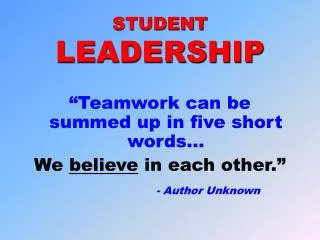
STUDENT LEADERSHIP
STUDENT LEADERSHIP. “Teamwork can be summed up in five short words… We believe in each other.” - Author Unknown. Leadership is the ability to motivate yourself and others to accomplish a common goal through a united effort .
1.67k views • 7 slides
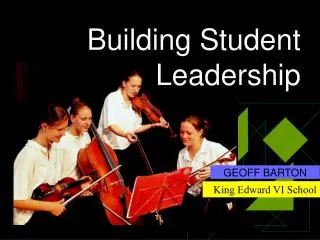
Building Student Leadership. GEOFF BARTON. King Edward VI School. Building Leadership . What do we know about young people? What do we know about schools? What do we know about students IN schools? How can we improve schools for students?. 2 starting-points …. Building Leadership .
509 views • 30 slides

STUDENT LEADERSHIP. INAUGURAL ANNUAL GENERAL MEETING Opportunities & Challenges in Leading. Objectives of AGM. To take stock of leadership development from March 2010 – Oct 2010 To build shared vision amongst leaders To envision for 2011. Keynote Address -Mrs Jalil-Ong Suat Eng.
607 views • 16 slides
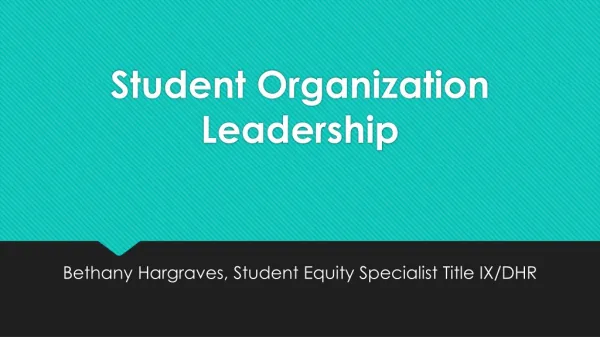
Student Organization Leadership
Student Organization Leadership. Bethany Hargraves, Student Equity Specialist Title IX/DHR. May be challenging to hear, our intention is not to be insensitive or offensive, it is to ensure you have information you need to be successful as a student here at CSUSM, and beyond!.
221 views • 7 slides

Building Leadership Trust
Building Leadership Trust. Lisa Ross , SSGB APICS Triangle Chapter, November 12 , 2013. Introductions.
1.05k views • 38 slides
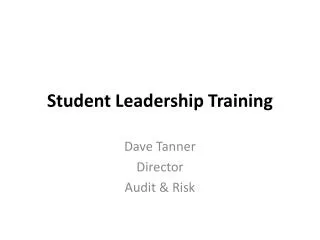
Student Leadership Training
Student Leadership Training. Dave Tanner Director Audit & Risk. Topics Covered. Legal Secretariat Risk Financial Management. Legal. Unincorporated Associations compared with Incorporated Associations Unincorporated A ssociations
425 views • 26 slides

Student Leadership Group
Student Leadership Group. Head Boy Head Girl Jacob McCarthy Sarah Crowley Deputy Head Boy Deputy Head Girl Jordan Fletcher Kayleigh Barry Senior Captain Senior Captain (pastoral) (Curriculum) Lisa Mansfield Sarah P oore. Cluster Council Meeting.
304 views • 17 slides

Student Leadership Group. Head Boy Head Girl Jacob McCarthy Sarah Crowley Deputy Head Boy Deputy Head Girl Jordan Fletcher Kayleigh Barry Senior Captain Senior Captain (pastoral) (Curriculum) Lisa Mansfield Sarah P oore. School Council Meeting.
268 views • 17 slides

Student Support Leadership
Student Support Leadership. Front Line Workers Session Timmins and Area May 31, 2010. Agenda. Student Support Leadership. Cluster #14 “Serving Temagami to James Bay including the Highway 11 Corridor to Hearst”. Large Geographic area with two sections in Cluster.
398 views • 28 slides

Student Leadership 2013
Student Leadership 2013. “A leader is one who knows the way, goes the way, And shows the way.”. JESUS’ VISION FOR SHARED LEADERSHIP. His time of ministry was short – 3 years – so he needed a group of people who he trusted who would carry on His message
324 views • 11 slides
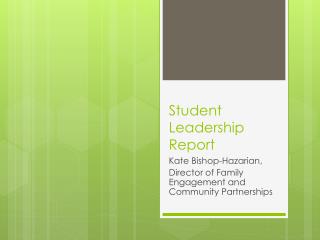
Student Leadership Report
Student Leadership Report. Kate Bishop-Hazarian, Director of Family Engagement and Community Partnerships. Student Leadership Advisory Committee. Valuing Student Leaders. Began in winter of 2009 Student Leadership Advisory Committee meets 5 or 6 times annually Goals:
367 views • 14 slides

Building Student Vocabulary
Building Student Vocabulary. The ESL Team: Cathy Jacobs - cathy.jacobs Christina Mahar – christina.mahar Betsy Schneider – elisabethr.schneider. SIOP STEPS. Lesson Preparation Building Background Comprehensible Input Strategies Interaction Practice Application Lesson Delivery
275 views • 14 slides
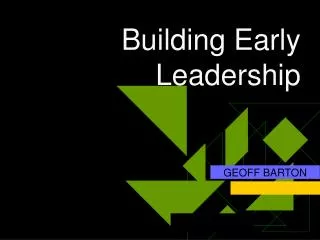
Building Early Leadership
Building Early Leadership. GEOFF BARTON. Building Early Leadership. How it was How it is How it could be. 6. Building Early Leadership. How it used to be. Building Early Leadership. Lawrie Lowton. John Baumber. Roy Samson. Building Early Leadership. Michael Fullan:.
452 views • 33 slides

Student Leadership
National Society of Black Engineers – Greenbelt Space Chapter Presents The Greater Prince George’s NSBE Jr. Chapter. The Bridge Magazine. Interaction with NASA Engineers. SAT Prep and Study Skills. What Is NSBE Jr???. Mentoring. Trips and Competitions. Fun and Food!.
218 views • 1 slides
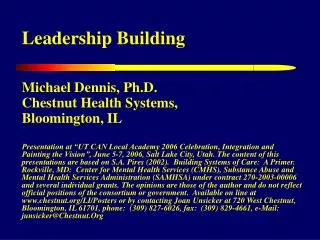
Leadership Building
Leadership Building. Michael Dennis, Ph.D. Chestnut Health Systems, Bloomington, IL
263 views • 13 slides

Building Leadership Team
Building Leadership Team. October 5, 2010 Whip Around: Share one positive thing from your morning LbD session and one take away from the afternoon sessions. Agenda. Review of Course Proposals, Changes and Deletions How will you talk as a department about teacher recommendations for courses?
248 views • 7 slides

Building Student Leadership Skills
Building Student Leadership Skills. Janis Hall, Skaggs Elementary Sandi Acheson, Sigler Elementary Kim Murff, Bethany Elementary Plano ISD. Tools and Literature Lesson Ideas to Motivate and Develop Student Leadership Skills Based on the Philosophy of these Books:. Let’s Sing.
589 views • 36 slides

Student Leadership. By: Rhys Andrews. Why a Focus on Student Leadership?. Tomorrows leaders will be you We can help prepare you for leadership challenges We develop shared learning about leadership. Critical Elements of Student Leadership Development. Partnerships between staff and students
670 views • 24 slides

Building Student Leadership. GEOFF BARTON. King Edward VI School. Building Leadership. What do we know about young people? What do we know about schools? What do we know about students IN schools? How can we improve schools for students?. 2 starting-points …. Building Leadership.
455 views • 30 slides

Building Sustainable Leadership
Building Sustainable Leadership. Patrick M. Wright. Building Sustainable Leadership. Why Executive Succession? C-Suite Failure Frequency Costs Causes Building the Talent Pipeline. Research Foundation. 2015 HR@Moore Survey of CHROs C-Suite Failure Study (interviews with 10 CHROs)
307 views • 24 slides

343 views • 33 slides
Newly Launched - AI Presentation Maker

AI PPT Maker
Powerpoint Templates
Icon Bundle
Kpi Dashboard
Professional
Business Plans
Swot Analysis
Gantt Chart
Business Proposal
Marketing Plan
Project Management
Business Case
Business Model
Cyber Security
Business PPT
Digital Marketing
Digital Transformation
Human Resources
Product Management
Artificial Intelligence
Company Profile
Acknowledgement PPT
PPT Presentation
Reports Brochures
One Page Pitch
Interview PPT
All Categories
Top 10 Student Leadership Training Modules PowerPoint Presentation Templates in 2024
Introducing our Student Leadership Training Modules, a comprehensive suite of fully editable and customizable PowerPoint presentations designed to empower the next generation of leaders. Each module is meticulously crafted to cover essential leadership skills, including effective communication, team collaboration, conflict resolution, and decision-making. With vibrant visuals and engaging content, these presentations facilitate interactive learning experiences, making it easy for educators and trainers to adapt the material to their specific audience and objectives.These modules are perfect for various use cases, including high school and college leadership programs, student government training, and extracurricular activities. Educators can seamlessly integrate the content into workshops, seminars, or classroom settings, fostering an environment that encourages active participation and critical thinking. Additionally, these training modules can be utilized for peer mentoring programs, helping students develop leadership qualities while guiding their peers. By equipping students with the tools they need to succeed, our Student Leadership Training Modules not only enhance individual growth but also contribute to building a strong, collaborative community. Transform your leadership training initiatives with our customizable presentations and inspire the leaders of tomorrow!

- CORE CURRICULUM
- LITERACY > CORE CURRICULUM > Into Literature, 6-12" data-element-type="header nav submenu" title="Into Literature, 6-12" aria-label="Into Literature, 6-12"> Into Literature, 6-12
- LITERACY > CORE CURRICULUM > Into Reading, K-6" data-element-type="header nav submenu" title="Into Reading, K-6" aria-label="Into Reading, K-6"> Into Reading, K-6
- LITERACY > undefined > English 3D, 4-12" data-element-type="header nav submenu" title="English 3D, 4-12" aria-label="English 3D, 4-12"> English 3D, 4-12
- LITERACY > undefined > Read 180, 3-12" data-element-type="header nav submenu" title="Read 180, 3-12" aria-label="Read 180, 3-12"> Read 180, 3-12
- INTERVENTION
- LITERACY > INTERVENTION > English 3D, 4-12" data-element-type="header nav submenu" title="English 3D, 4-12" aria-label="English 3D, 4-12"> English 3D, 4-12
- LITERACY > INTERVENTION > Read 180, 3-12" data-element-type="header nav submenu" title="Read 180, 3-12" aria-label="Read 180, 3-12"> Read 180, 3-12
- SUPPLEMENTAL
- LITERACY > SUPPLEMENTAL > A Chance in the World SEL, 8-12" data-element-type="header nav submenu" title="A Chance in the World SEL, 8-12" aria-label="A Chance in the World SEL, 8-12"> A Chance in the World SEL, 8-12
- LITERACY > SUPPLEMENTAL > Amira Learning, K-6" data-element-type="header nav submenu" title="Amira Learning, K-6" aria-label="Amira Learning, K-6"> Amira Learning, K-6
- LITERACY > SUPPLEMENTAL > Classcraft, K-8" data-element-type="header nav submenu" title="Classcraft, K-8" aria-label="Classcraft, K-8"> Classcraft, K-8
- LITERACY > SUPPLEMENTAL > JillE Literacy, K-3" data-element-type="header nav submenu" title="JillE Literacy, K-3" aria-label="JillE Literacy, K-3"> JillE Literacy, K-3
- LITERACY > SUPPLEMENTAL > Waggle, K-8" data-element-type="header nav submenu" title="Waggle, K-8" aria-label="Waggle, K-8"> Waggle, K-8
- LITERACY > SUPPLEMENTAL > Writable, 3-12" data-element-type="header nav submenu" title="Writable, 3-12" aria-label="Writable, 3-12"> Writable, 3-12
- LITERACY > SUPPLEMENTAL > ASSESSMENT" data-element-type="header nav submenu" title="ASSESSMENT" aria-label="ASSESSMENT"> ASSESSMENT
- CORE CURRICULUM
- MATH > CORE CURRICULUM > Arriba las Matematicas, K-8" data-element-type="header nav submenu" title="Arriba las Matematicas, K-8" aria-label="Arriba las Matematicas, K-8"> Arriba las Matematicas, K-8
- MATH > CORE CURRICULUM > Go Math!, K-6" data-element-type="header nav submenu" title="Go Math!, K-6" aria-label="Go Math!, K-6"> Go Math!, K-6
- MATH > CORE CURRICULUM > Into Algebra 1, Geometry, Algebra 2, 8-12" data-element-type="header nav submenu" title="Into Algebra 1, Geometry, Algebra 2, 8-12" aria-label="Into Algebra 1, Geometry, Algebra 2, 8-12"> Into Algebra 1, Geometry, Algebra 2, 8-12
- MATH > CORE CURRICULUM > Into Math, K-8" data-element-type="header nav submenu" title="Into Math, K-8" aria-label="Into Math, K-8"> Into Math, K-8
- MATH > CORE CURRICULUM > Math Expressions, PreK-6" data-element-type="header nav submenu" title="Math Expressions, PreK-6" aria-label="Math Expressions, PreK-6"> Math Expressions, PreK-6
- MATH > CORE CURRICULUM > Math in Focus, K-8" data-element-type="header nav submenu" title="Math in Focus, K-8" aria-label="Math in Focus, K-8"> Math in Focus, K-8
- SUPPLEMENTAL
- MATH > SUPPLEMENTAL > Classcraft, K-8" data-element-type="header nav submenu" title="Classcraft, K-8" aria-label="Classcraft, K-8"> Classcraft, K-8
- MATH > SUPPLEMENTAL > Waggle, K-8" data-element-type="header nav submenu" title="Waggle, K-8" aria-label="Waggle, K-8"> Waggle, K-8
- MATH > INTERVENTION > Math 180, 3-12" data-element-type="header nav submenu" title="Math 180, 3-12" aria-label="Math 180, 3-12"> Math 180, 3-12
- SCIENCE > CORE CURRICULUM > Into Science, K-5" data-element-type="header nav submenu" title="Into Science, K-5" aria-label="Into Science, K-5"> Into Science, K-5
- SCIENCE > CORE CURRICULUM > Into Science, 6-8" data-element-type="header nav submenu" title="Into Science, 6-8" aria-label="Into Science, 6-8"> Into Science, 6-8
- SCIENCE > CORE CURRICULUM > Science Dimensions, K-12" data-element-type="header nav submenu" title="Science Dimensions, K-12" aria-label="Science Dimensions, K-12"> Science Dimensions, K-12
- SCIENCE > READERS > ScienceSaurus, K-8" data-element-type="header nav submenu" title="ScienceSaurus, K-8" aria-label="ScienceSaurus, K-8"> ScienceSaurus, K-8
- SOCIAL STUDIES > CORE CURRICULUM > HMH Social Studies, 6-12" data-element-type="header nav submenu" title="HMH Social Studies, 6-12" aria-label="HMH Social Studies, 6-12"> HMH Social Studies, 6-12
- SOCIAL STUDIES > SUPPLEMENTAL > Writable" data-element-type="header nav submenu" title="Writable" aria-label="Writable"> Writable
- For Teachers
- PROFESSIONAL DEVELOPMENT > For Teachers > Coachly" data-element-type="header nav submenu" title="Coachly" aria-label="Coachly"> Coachly
- PROFESSIONAL DEVELOPMENT > For Teachers > Teacher's Corner" data-element-type="header nav submenu" title="Teacher's Corner" aria-label="Teacher's Corner"> Teacher's Corner
- PROFESSIONAL DEVELOPMENT > For Teachers > Live Online Courses" data-element-type="header nav submenu" title="Live Online Courses" aria-label="Live Online Courses"> Live Online Courses
- PROFESSIONAL DEVELOPMENT > For Teachers > Program-Aligned Courses" data-element-type="header nav submenu" title="Program-Aligned Courses" aria-label="Program-Aligned Courses"> Program-Aligned Courses
- For Leaders
- PROFESSIONAL DEVELOPMENT > For Leaders > The Center for Model Schools (formerly ICLE)" data-element-type="header nav submenu" title="The Center for Model Schools (formerly ICLE)" aria-label="The Center for Model Schools (formerly ICLE)"> The Center for Model Schools (formerly ICLE)
- MORE > undefined > Assessment" data-element-type="header nav submenu" title="Assessment" aria-label="Assessment"> Assessment
- MORE > undefined > Early Learning" data-element-type="header nav submenu" title="Early Learning" aria-label="Early Learning"> Early Learning
- MORE > undefined > English Language Development" data-element-type="header nav submenu" title="English Language Development" aria-label="English Language Development"> English Language Development
- MORE > undefined > Homeschool" data-element-type="header nav submenu" title="Homeschool" aria-label="Homeschool"> Homeschool
- MORE > undefined > Intervention" data-element-type="header nav submenu" title="Intervention" aria-label="Intervention"> Intervention
- MORE > undefined > Literacy" data-element-type="header nav submenu" title="Literacy" aria-label="Literacy"> Literacy
- MORE > undefined > Mathematics" data-element-type="header nav submenu" title="Mathematics" aria-label="Mathematics"> Mathematics
- MORE > undefined > Professional Development" data-element-type="header nav submenu" title="Professional Development" aria-label="Professional Development"> Professional Development
- MORE > undefined > Science" data-element-type="header nav submenu" title="Science" aria-label="Science"> Science
- MORE > undefined > undefined" data-element-type="header nav submenu">
- MORE > undefined > Social and Emotional Learning" data-element-type="header nav submenu" title="Social and Emotional Learning" aria-label="Social and Emotional Learning"> Social and Emotional Learning
- MORE > undefined > Social Studies" data-element-type="header nav submenu" title="Social Studies" aria-label="Social Studies"> Social Studies
- MORE > undefined > Special Education" data-element-type="header nav submenu" title="Special Education" aria-label="Special Education"> Special Education
- MORE > undefined > Summer School" data-element-type="header nav submenu" title="Summer School" aria-label="Summer School"> Summer School
- BROWSE RESOURCES
- BROWSE RESOURCES > Classroom Activities" data-element-type="header nav submenu" title="Classroom Activities" aria-label="Classroom Activities"> Classroom Activities
- BROWSE RESOURCES > Customer Success Stories" data-element-type="header nav submenu" title="Customer Success Stories" aria-label="Customer Success Stories"> Customer Success Stories
- BROWSE RESOURCES > Digital Samples" data-element-type="header nav submenu" title="Digital Samples" aria-label="Digital Samples"> Digital Samples
- BROWSE RESOURCES > Events" data-element-type="header nav submenu" title="Events" aria-label="Events"> Events
- BROWSE RESOURCES > Grants & Funding" data-element-type="header nav submenu" title="Grants & Funding" aria-label="Grants & Funding"> Grants & Funding
- BROWSE RESOURCES > Family & Caregiver Resources" data-element-type="header nav submenu" title="Family & Caregiver Resources" aria-label="Family & Caregiver Resources"> Family & Caregiver Resources
- BROWSE RESOURCES > International" data-element-type="header nav submenu" title="International" aria-label="International"> International
- BROWSE RESOURCES > Research Library" data-element-type="header nav submenu" title="Research Library" aria-label="Research Library"> Research Library
- BROWSE RESOURCES > Shaped, HMH Blog" data-element-type="header nav submenu" title="Shaped, HMH Blog" aria-label="Shaped, HMH Blog"> Shaped, HMH Blog
- BROWSE RESOURCES > Webinars" data-element-type="header nav submenu" title="Webinars" aria-label="Webinars"> Webinars
- CUSTOMER SUPPORT
- CUSTOMER SUPPORT > Contact Sales" data-element-type="header nav submenu" title="Contact Sales" aria-label="Contact Sales"> Contact Sales
- CUSTOMER SUPPORT > Customer Service & Technical Support Portal" data-element-type="header nav submenu" title="Customer Service & Technical Support Portal" aria-label="Customer Service & Technical Support Portal"> Customer Service & Technical Support Portal
- CUSTOMER SUPPORT > Platform Login" data-element-type="header nav submenu" title="Platform Login" aria-label="Platform Login"> Platform Login
- Learn about us
- Learn about us > About" data-element-type="header nav submenu" title="About" aria-label="About"> About
- Learn about us > Diversity, Equity, and Inclusion" data-element-type="header nav submenu" title="Diversity, Equity, and Inclusion" aria-label="Diversity, Equity, and Inclusion"> Diversity, Equity, and Inclusion
- Learn about us > Environmental, Social, and Governance" data-element-type="header nav submenu" title="Environmental, Social, and Governance" aria-label="Environmental, Social, and Governance"> Environmental, Social, and Governance
- Learn about us > News Announcements" data-element-type="header nav submenu" title="News Announcements" aria-label="News Announcements"> News Announcements
- Learn about us > Our Legacy" data-element-type="header nav submenu" title="Our Legacy" aria-label="Our Legacy"> Our Legacy
- Learn about us > Social Responsibility" data-element-type="header nav submenu" title="Social Responsibility" aria-label="Social Responsibility"> Social Responsibility
- Learn about us > Supplier Diversity" data-element-type="header nav submenu" title="Supplier Diversity" aria-label="Supplier Diversity"> Supplier Diversity
- Join Us > Careers" data-element-type="header nav submenu" title="Careers" aria-label="Careers"> Careers
- Join Us > Educator Input Panel" data-element-type="header nav submenu" title="Educator Input Panel" aria-label="Educator Input Panel"> Educator Input Panel
- Join Us > Suppliers and Vendors" data-element-type="header nav submenu" title="Suppliers and Vendors" aria-label="Suppliers and Vendors"> Suppliers and Vendors
- Divisions > Center for Model Schools (formerly ICLE)" data-element-type="header nav submenu" title="Center for Model Schools (formerly ICLE)" aria-label="Center for Model Schools (formerly ICLE)"> Center for Model Schools (formerly ICLE)
- Divisions > Heinemann" data-element-type="header nav submenu" title="Heinemann" aria-label="Heinemann"> Heinemann
- Divisions > NWEA" data-element-type="header nav submenu" title="NWEA" aria-label="NWEA"> NWEA
- Platform Login
HMH Support is here to help you get back to school right. Get started
SOCIAL STUDIES
PROFESSIONAL DEVELOPMENT
Instructional Practices
9 Interesting Qualities of a Good Student Leader

Leaders—our world is hungry for them. From kids who are leading their siblings and classmates to influential figures who are leading entire countries, there need to be people who step up and take on responsibility.
And as teachers, we’re invested in preparing our students to thrive in the world of their future. To that end, we must also be invested in encouraging them to be the kind of leaders that this world wants and needs.
Leadership Qualities for Students to Cultivate
What kinds of leaders does the world need?
Arguably, people who are effective at setting and achieving goals—those who have a vision and are able to make it a reality by inspiring and persuading others to join them.
But is that enough? Being able to turn a vision into reality is a result of effective leadership, but what if the vision is harmful to people? There are countless examples throughout history of effective leaders who were not admirable. So being an effective leader is clearly not enough. Besides being effective, a leader must also be ethical and possess a variety of other respectable traits.
So what skills does a good , effective leader possess?
Leaders can take many forms. There isn’t really a single definition that works in all instances of leadership, but in general, a leader is:
- Goal oriented
- Hardworking
- In service of others
- A good listener
- A good decision-maker
- A good communicator
- Encouraging
- Responsible
What do these traits look like among students? What makes a good student leader, and how can student leaders be nurtured and developed?
Group projects are a great way to observe the qualities of a student leader. Let’s say you’ve divided your class into small groups and given them the assignment of reading, retelling, and presenting one of Aesop’s Fables. Throughout the allocated class times, you may notice the above-mentioned traits play out in the following ways:
1. They are goal oriented.
Part of being an effective leader is understanding the ultimate objective and being driven to get there. Students especially show signs of leadership when they intrinsically set their own goals beyond the ones set by the teacher. Look for students who propose ideas above and beyond what you ask of them and commend them for their initiative.
Example: As you observe the groups, you notice certain students immediately take charge and set the vision of the group. You may hear things like, “Let’s do the story of the Ant and the Grasshopper and make it like a comic book,” or, “Let’s do the story of the Dolphins, the Whales, and the Gudgeon and use cardboard boxes to make dolphins and whales.” You give each group a name: “Ant and Grasshopper” and “Dolphins and Whales.”
2. They are positive.
Leaders keep their eyes on the goal, even in the face of obstacles. Keep an eye out for students who believe that whatever goal has been set can be accomplished, even if it may seem insurmountable. Let them know their positivity is admirable and can inspire positivity in others.
Example: There are only a few minutes left of work time. The Whales and Dolphins group is elbow deep in the blue paint you gave them. There is just one part of a whale left to paint. A student looks at the clock and a determined expression crosses her face. “Hey, this is looking pretty good so far! Come on, everyone!” she says. “If we paint a little faster, we can finish before the end of class!”

3. They are hardworking.
Working hard is contagious. If one student is persevering and showing a true passion for the subject, that student will inspire others to believe that they, too, can (and should) strive for excellence. In short, hardworking student leaders inspire and push their classmates to do more. Look for the students that you see working hard, and let them know they are showing signs of being a good leader. Example: While the Ant and Grasshopper group is busy on the computer, the Dolphins and Whales group is consumed by the cardboard boxes you supplied them. As you come by to see if they need anything, you see one student especially hard at work cutting out a hole for the whale’s mouth. You call attention to how much you admire how involved that student is, which gets other students to notice the hard work and want to contribute. Soon enough, the rest of the group joins in and starts to cut and shape the other boxes.
4. They serve others.
Students exemplify strong leadership skills when they want what is best for others and are willing to go out of their way to help their peers and communities. In a classroom setting, this is best seen through acts of kindness or selflessness. You can help develop leadership by prompting students to think about what their classmates need.
Example: You are on the second day of the project on fables. The Ant and Grasshopper group is now working on their comic book strips. As they discuss how to proceed and what they need to begin the task, you encourage one student to make a list of all the materials needed. She shows strong leadership when, unprompted, she goes around the classroom and rounds up the necessary materials.
5. They are good listeners.
An important leadership skill is genuinely caring about and listening to the thoughts and concerns of others. Leading others must come from a desire to help others. When students practice this skill in group work, they’re not only listening carefully to other students’ concerns, they’re also being more receptive of feedback and willing to compromise.
Example: The Whales and Dolphins group is assessing their work from the previous day and figuring out what today’s tasks should be. You hear one of the students say, “The whale’s tail doesn’t look right and is hard to move. Anika, do you think we should use another box for it?” Anika shows signs of leadership when she replies, “Okay, that works. Are there any boxes left, or do you think we should ask the teacher for more? Should we do the same for the dolphins?”
6. They are good decision-makers.
Students exhibit great leadership when they evaluate a given situation and come to a well-reasoned conclusion about the best course of action. Ultimately, good decision-making stems from a sense of responsibility, a good understanding of the problem, and the ability to think under pressure.
Example: The Whales and Dolphins group is looking at one whale made out of cut-up boxes and trying to figure out how to patch a large gap in it. One student shakes his head. “Hmm . . .” he says. “I don’t think we have one piece of cardboard left to fill in the hole. But, we do have a few small pieces left over that we could tape together that would probably be big enough. We can ask the teacher for lots of tape to fix the whale.”
7. They are good communicators.
Another important student leadership quality is communication. Student leaders communicate their ideas to the rest of a group. If students have an idea of how things should be done, they take on the role of being a good leader when they make their suggestions known in an open and respectful manner.
Example: You make your way back to the Ant and Grasshopper group. The group is gathered around one student who is excitedly pointing to a diagram she drew on a tablet. “I think we should first decide on and write a short description for each box, and then we can divide up the boxes and each work on drawing the pictures for that box and coming up with what the characters will say. What do you guys think?”

8. They are encouraging.
Part of being an effective leader is recognizing that everyone comes with different backgrounds and experiences. Students display strong leadership skills when they affirm and utilize the strengths in the group, while also trying to assist when others are struggling.
Example: The comic book strips for the Ant and Grasshopper group are beginning to take shape. The summary headings have been written and some sketches are starting to form on the paper. Then, one of the students looks up from his work. “Hey Adana,” he says. “I can tell you’ve put a lot of effort into learning to draw faces. Can you help me draw faces on the ants?”
9. They take responsibility.
If something goes wrong, student leaders do not pass the blame or make excuses but take responsibility for their part. Then, they learn from it, do what’s needed to correct what went wrong, and keep moving forward. When things go right , the most effective leaders are humble and recognize the efforts of their group and not just their own.
Example: While the Ant and Grasshopper group has effectively and efficiently cleaned up their work space, the Whales and Dolphins group is having less success. One of the members of this group comes up to you, her shoulders slumped, her expression apologetic. “Umm . . . teacher? I’m sorry, but we spilled the paint on the floor. I forgot to close it and then it got knocked over, but I’ll help you clean it up. Oh, but did you see the whale we made? Didn’t we do a good job?” She shows leadership in several ways: taking responsibility for a problem, proposing a solution, and attributing the successful paint job to “we.”
The Leaders of Tomorrow: Developing Leadership Skills for Students
Our students may be young, and they may be small. But observations made throughout a group project can create opportunities to develop lifelong leadership skills and give us a glimpse of the great leaders our students can be in the future. Let students know when you see them showing signs of strong leadership, and encourage them to reflect upon and grow their leadership skills.
With each opportunity and with each encouragement to grow the skills of student leaders in a healthy, productive, and appropriate direction, they can become the good, effective leaders that our world needs.
Transform your classroom and engage every student with HMH Classcraft , a solution that pairs efficacious ELA and math content with research-based lesson plans.
Be the first to read the latest from Shaped .
- Professional Learning
Related Reading

Why Is Writing Important for Students?
Shaped Contributor
August 19, 2024

3 Strategies for Redesigning Professional Development
Dr. Amanda Patterson National Director, Academic Planning and Analytics, HMH
August 14, 2024

How to Create a Virtual Field Trip for Students That Engages and Delights
First-Grade Teacher
12 Leadership Passion Project Ideas for High School Students

By Alex Yang
Graduate student at Southern Methodist University
7 minute read
Leadership passion projects are initiatives pursued by student leaders to make a positive impact on others and their community. These projects usually stem from a genuine passion for a cause, issue, or goal, and they demonstrate a student leader's commitment to spearheading change and getting others involved. Such projects are often overlooked because of the more academically-focused passion projects that are out there, but we’ll discuss later how leadership passion projects can actually showcase a student’s skills and authenticity just as much as an academic project can.
If you’re thinking that the term “leadership passion projects” is a bit ambiguous, these 12 examples of leadership passion projects that you can get started on right away should help clarify what leadership passion projects can be.
What are some leadership passion project ideas?
Keep in mind that these are just a few of many ideas you can take on, and we encourage you to make these projects uniquely your own. Notice how the overarching theme for all of these projects is that you’re leading the initiative and making an impact within your community, while also contributing to development of your own leadership skills.
1. Peer Mentorship Program
Create a program where upperclassmen mentor underclassmen in academic, social, or personal aspects, developing a supportive school environment. You can have students matched based on things like college major interest or personal hobbies.
2. Community Garden
Establish a community garden on school grounds that students take care of, providing a hands-on learning experience about gardening, nutrition, and sustainability while producing fresh produce for local charities.
3. Literacy Initiative
Create a reading program where high school students read to elementary school children, promoting literacy and fostering positive role models for younger children.
4. STEM Workshops
Organize science, technology, engineering, and math workshops for middle school students, sparking their interest in these fields and showcasing high schoolers' leadership and knowledge of STEM. See if you can get a high school STEM teacher to help with developing this initiative.
5. Creative Arts Showcase
Plan an arts and culture event that features student or even faculty performances in music, dance, theater, and visual arts, celebrating creativity within the school community.
6. Career Exploration Series
Arrange sessions where professionals from various fields come to your school to share insights about their careers and their day to day jobs. This can help expose students to a variety of careers and get them starting to think about what may be interesting to them. Bonus points if you can find alumni from your high school to come speak!
7. Volunteer Outreach Program
Develop a program that connects students with local volunteer opportunities , enabling them to give back to the community and build valuable life skills.
8. Mental Health Awareness Campaign
Organize events, workshops, and discussions to promote mental health awareness, reduce stigma, and provide resources for students struggling with mental health issues.
9. Fitness and Wellness Challenges
Launch wellness challenges that encourage students to engage in physical activities, healthy habits, and mindfulness practices to promote overall well-being.
10. Student-Led Workshops
Organize skill-sharing workshops where students teach their peers about subjects they're passionate about. School is often so focused on faculty teaching students that we forget that students have a lot of knowledge that they can share with each other.
11. Language Exchange Program
Establish a program where students can learn and exchange languages, fostering cultural exchange and language development in a fun way.
12. Entrepreneurship Fair
Organize a fair where students can showcase their entrepreneurial ideas and products, fostering creativity and business skills. If you’d like to make it more competitive, you can also turn it into a contest where teachers are judges and evaluate the various ideas.
We’ve mentioned how leadership passion projects involve spearheading an initiative, but this doesn’t always mean that you have to start an organization from scratch! If there are already existing clubs or organizations at your school that are doing work that you personally care about, join those and see if you can start participating. From there, you can then maybe work your way towards creating a new initiative and also brainstorm ideas with other students in the club.
As quoted in our conversation with John Gardezi of Edvanced Learning Academy , “You don't need to reinvent the wheel. You can still make a difference by making small contributions.”
Why are leadership projects important?
First and foremost, leadership passion projects provide a great opportunity for personal growth. By leading a new initiative or organization, you’re practicing what it takes to become a leader. You’re doing things like organizing events, delegating tasks, reaching out to outside parties and becoming a better speaker and thinking creatively to make things happen. Learning how to set a vision and execute on it is an incredible skill to have and it’s something you’ll be able to practice through a leadership passion project.
Further, you get to work for a cause that you care about. Whether that’s sustainability, mental health, or hunger, by doing a project you have the opportunity to actually make change. You’re making your mark. While doing so, you’ll also be able to collaborate with other students in your community and build great relationships as a result. Ideally, that cause that you care about could also be something you’re interested in studying in college, which strengthens your demonstrated interest as a college applicant. For example, let’s say that you are interested in sustainability and want to potentially explore that field more. You could take initiative on the community garden project idea in order to explore sustainability more deeply and this leads to a project where you’re not only learning about something you’re interested in, but also getting directly involved with it.
Moreover, all of these skills and learning experiences that you would get out of a leadership passion project are things that you can showcase to the world, whether that’s for a job, college admissions, or to just show what you’re capable of. In a Polygence guest blog post, former admissions officer Ben Bousquet talks about how he would advocate for college applicants, saying, “admission officers are storytellers. We tell your story to the admissions committee on your behalf…If you’ve created a strengths-based narrative in your application and weaved those strengths together into a compelling story, your admission officer should have no problem advocating for you.” The great part about leadership passion projects is that they can usually be explained in a way that creates an interesting story. You helped to jumpstart an initiative with this goal in mind and you worked super hard to execute it…you faced many challenges on the way but overcame them…and in the end you made an impact on your student community or a local one. These are great stories that you can share in your college admissions essays and interviews.
How can I find the leadership project that’s right for me?
Ultimately, this comes down to what you really care about. Making a new initiative happen is no easy task, and if you’re not passionate about the work that you’re doing, it can be very difficult to execute that initiative well. As a result, think about what causes you’re actually interested in and what you’d be willing to work hard for. Further, assess what existing clubs there are at your school and whether any of those stand out to you.
How can I showcase my leadership work?
Showcasing your leadership passion project is a bit different from showcasing academic research , as there usually isn’t a physical research paper or presentation that you can show off. Instead, it's the impact of your work and the behind the scenes work that got you there that you want to emphasize. As a result, try to find a way to document that behind the scenes work, whether that was finding the right volunteer organization to work with, or meeting with school administrators to pitch an idea to them. You can write down all the work that you did, or, if you’re willing, you can also try to vlog the work and create almost a documentary of sorts by the end.
Making notes of all these things will help you easily recall all the hard work you put in and the skills you gained from the experience. This could then be turned into a blog post or even a quick video to explain all the behind the scenes work that you did to conduct your leadership passion project
If your project is more about organizing events or shows, see if you can measure the impact of those events. Track the number of attendees, guest speakers, get written or verbal feedback from attendees about how the event went, and maybe even record an event or two to really show what you put together. Another idea is to create a social media page for your organization and take pictures and create posts for events that you helped make happen. This is your opportunity to really be creative!
In this article, we’ve discussed the power of leadership passion project ideas, listed examples of projects, and provided ideas of how to showcase your work .
If you’re eager to make an impact and interested in pursuing a leadership passion project, Polygence’s programs are a great place to start. You’ll have a mentor well-versed on leadership who can help guide you and help you overcome challenges in your leadership passion project journey.
Related Content
What Sets Polygence Apart from Other Research Programs for Middle and High School Students
Get an Edge in College Admissions Through Doing a Research Project
Research Projects and College Admissions
Think Research in High School is Daunting and Confusing? Think Again!
Research on Your College Applications: How Should You Frame It?
Stand Out Without Standardized Tests: Cultivate your Interesting-ness
Do Your Own Research Through Polygence
Your passion can be your college admissions edge! Polygence provides high schoolers a personalized, flexible research experience proven to boost your admission odds. Get matched to a mentor now!"
The Winter cohort application deadline is November 24, 2024.
Click here to apply.

Featured Posts

National STEM Challenge for High Schoolers—Should You Participate?

8 Fashion Design Camps for Middle School Students

8 Summer Band Camps for Middle School Students

eCYBERMISSION—7 Reasons Why You Should Participate
10 Leadership Activities for High School Students
As many universities go test-optional, the way that selective universities choose students has become increasingly qualitative. Leadership has become an ever-important metric for evaluating an applicant’s candidacy for admission.
Here’s why.
Leadership is often viewed by students as something reserved for adults, but positively taking charge of an activity, a group, or even a project is a step very few teens take. Admissions officers are looking for students who take the initiative to work on new projects, or band people together and learn new skills.
Note that your application should include a good mix of leadership activities, research, extracurricular activities, and a strong passion for the subject you’re applying for!
In this blog, we present different ways that students in high school can develop leadership skills both inside and outside of the classroom.
If you are interested in showcasing leadership through university-level research, then you could also consider applying to the Lumiere Research Scholar Program , a selective online high school program for high school students. Last year, we had over 4000 students apply for 500 spots in the program! You can find the application form here.
Here are 10 different leadership activities for high school students to get involved in!
1. Run for Student Government / Class Council
Also referred to as student government or governing council, high school class councils are front-facing, amazing ways to become involved as a leader within your school environment. Planning activities and managing budgets are some of the many responsibilities that come with being an officer …plus it can be a lot of fun! It is also an impressive commitment to demonstrate in your college application.
Personally, my time as treasurer for my class council, and my later role as Class President taught me a great deal about the type of leader I am and how I operate in the face of pressure. Managing a large team to plan school-wide events like Homecoming and graduation were impressive components to my applications and ultimately played a significant role in getting me to Princeton. Even the experience of running for elected office demonstrates a commitment to leadership and a passion for serving your local community.
2. Join the board of a student organization
Most schools offer a wide variety of extracurricular clubs for their students to get involved in. They can be service-oriented, related to hobbies, or academic in nature. Whether it's your school’s National Honor Society or Rocketry Club, finding an organization that you are interested in and joining their executive board is one of the simplest and most effective ways to enhance your leadership skills in high school. Or, if there isn’t one you are particularly interested in, start your own club!
3. Start a Club
If there is a subject area or hobby that you are particularly fond of, start a student organization for it at your school! Taking the initiative to start a club and encouraging other students to join is a sure way to stand out on your college applications. Typically, the Activities Office of your school should be a helpful guide towards navigating the process of beginning a club. Involving a teacher of yours as an advisor is simultaneously a great way to exhibit leadership externally to faculty at school who could serve as recommenders for applications and scholarships. Potential examples for clubs to start include “ Girls Who Code ,” a chapter of an Honor Society, or Key Club . Alternatively, if there is a club that has long been inactive at your school, restarting it is another great idea!
4. Get a job or an internship
Many high school students take on jobs after school or on weekends, and these are excellent ways to demonstrate an ability for leadership! Acquiring a job that requires responsibility and strategic commitment is especially impressive and can teach you a lot about yourself and your career priorities. You can consider internships that allow you to work on a personal project under expert mentorship, or offer you the position of an assistant to a research project. These demonstrate initiative, skill, and professional maturity - skills admissions officers are looking for. Taking up babysitting jobs once and a while or a weekly shift at your local library are valuable ways to create an impact on your community in a novel way. Internships for high school students are offered across the country, and across multiple subjects and fields. It is a good idea to read up about the opportunities available for each subject, and then shortlist opportunities that you’d like to apply for! To assist you, we’ve written a few great blogs on internships that you can check out -
22 Internships for High School Students
10 Engineering Internships for High School Students
10 Business Internships for High School Students
12 Summer Internships For High School Students
10 Online Internships for High School Students
5. Serve as a volunteer
Community service has increasingly become a very important metric by which colleges evaluate applicants. Beyond being personally fulfilling, volunteering is so important for practicing commitment, problem-solving, and for learning more about your community - all skills critical to being a good leader. Volunteering can come in a myriad of forms, both unstructured and structured, to adapt to your schedule and individual needs as a student. Popular forms of volunteering for high school students occur at hospitals, museums, animal shelters, and parks, among others.
If you are interested in volunteering opportunities, you can look at our blog here !
6. Join a sports team
Joining an athletic team in high school can do wonders for your physical health and for your development as a leader. Students who are athletes in high school are regarded to demonstrate important qualities such as teamwork, initiative and exercising a goal-based mentality. Most high schools offer sports teams via their athletics department, or you can get involved in a rec team outside of school extracurricularly! This is an especially noteworthy form of demonstrating leadership if the team performs well at competitions or perhaps if the sport is a more unique one. Not only participating as a member for a team at your school, but assuming a role of leadership within the team is a way to demonstrate leadership skills outside of the classroom.
7. Pursue a Passion Project
As a break from the academic pressures of school, pursuing a passion project is a great way to gain leadership experience in your high school years. During my sophomore year, for example, I began a podcast that I used to share my experiences with identity and culture. Had it not been for the podcast, I wouldn’t have discovered my passion for public speaking and for podcasting as a whole! The great thing about passion projects is that they truly can be anything– it’s a great way to stand out in your college application! Some other examples can include an art project, a fashion show, or writing a book!
8. Participate in Competitions
Involvement in competitions is a fun and exciting way to make friends and showcase your skills as a leader. They help cultivate one’s ability to communicate and strategize with a team, as well as grow skills in problem-solving . Competitions range widely in both subject and in scale, with many existing on a local, national, and even international level. See what competition teams exist at your high school and if there is one that doesn’t, you can start it! Popular ones include Olympiads for different subjects, FBA, and HOSA. Other programs that we have covered include National Student Leadership Conference , Boys State & Boys Nation , and Girls State & Girls Nation !
9. Start a small business or join business programs
Love jewelry making? Seem to always be crocheting in your free time? Transforming your ideas into a small business is a great way to take your passions one step further. You don’t need a business degree or a fancy title to get started! Online platforms like Etsy and Redbubble offer ways for individual entrepreneurs to market their products to a wide audience at a low cost (or for free!) Owning a business, however small, demonstrates to colleges that you possess: responsibility, creativity, and flexibility in the face of change. Additionally, you can participate in leadership/business programs and internships such as Bank of America Student Leaders , Ladder Internships , or Brown University’s Leadership Institute , and competitions such as The Blue Ocean Competition , Diamond Challenge , or Genius Olympiad .
10. Get involved with research
Participating in a research project in high school is a great opportunity for many reasons. You can find opportunities for research virtually or through connections with local universities in your area. Research comes in a variety of forms, from qualitative to quantitative, there’s something for everyone! Whether you’re passionate about biology or the social sciences, research demonstrates discipline, self-driven initiative, and commitment– all of which are important attributes in a rising young professional. Many universities offer research programs for high school students which you can apply for. Research programs such as Lumiere Research Scholar and Veritas AI offer flexible, mentored, and fully remote research programs. Here’s a little more information -
1. Lumiere Research Scholar Program
Founded by Harvard and Oxford researchers, Lumiere offers its own structured research programs in which ambitious high school students work 1-1 with top PhDs and develop an independent research paper.
Student researchers have had the opportunity to work on customized research projects across STEM, social sciences, AI and business. Lumiere’s growing network of mentors currently has over 700, carefully selected PhDs from top universities. You can find the application form here .
Also check out the Lumiere Research inclusion Foundation , a non-profit research program for talented, low-income students.
2. Veritas AI’s Summer Fellowship Program
Veritas AI has a range of AI programs for ambitious high school students , starting from close-group, collaborative learning to customized project pathways with 1:1 mentorship .
The programs have been designed and run by Harvard graduate students & alumni.
In the AI Fellowship, you will create a novel AI project independently with the support of a mentor over 12-15 weeks. Examples of past projects can be found here .
Apply now !
Additionally, here are a few blogs that can guide you on your research journey as a high school student!
How to do Research in High School: Everything You Need to Know
The Complete Guide To Publishing Your Research In High School
How to Write About Research in Your College Application
How College Admission Officers Evaluate Research in Applications
Aisha is a student at Princeton University, studying Anthropology and Global Health. On campus, she is involved with student groups centered around health equity and cultural affinity. In her free time, she enjoys podcasting, learning languages, and trying new recipes.
Image Source: Veritas AI logo
- Preferences

Student Leadership - PowerPoint PPT Presentation

Student Leadership
To look at the student leadership programme (developed through london challenge) ... understanding self and others' co-developed (haringey) and piloted (hackney) ... – powerpoint ppt presentation.
- To explore the value of student leadership
- To look at the Student Leadership programme (developed through London Challenge)
- To discuss key questions relating to student leadership
- To consider future action
- An investment in student leadership means a commitment to examine the culture of the school/organisation in order that students/young people can exercise and develop leadership skills and practice
- An investment in leadership development training and support for the young people and the adults with whom they will be interacting
- It lies at the heart of building community in school and the heart of building school in the community.
- It engages students in the systems, processes and learning culture of an organisation or community
- It promotes self efficacy self and social awareness/resilience
- It can build trust within the organisation/communi ty
- Students can be a powerful resource in the development of school and community partnerships.
- Investing in student leadership potential is a direct long term investment in the community.
- It is a direct investment in growing leadership potential
- Student councils/Young People Forums
- Student/Young People on appointment boards
- Students/Young People participating in strategy and change for the future.
- Students working to improve the school and the community
- Students/Young People mentoring/tutoring/buddying others
- Developing and enhancing the skills of students to enable them to be proactive leaders in their schools and community.
- 6 Modules based on the National Standards for Headteachers
- Modules co-developed with KS3 students for KS3 students
- Being developed in partnership with the University of the First Age and supported by London Challenge though the programme will be made available nationally
- We base our work on the beliefs that
- Young people have the right to be listened to and involved
- Leadership is learnable
- Young people should act as ambassadors for learning in their school, local community and beyond
- Young people are part of the learning relationships and knowledge transfer which is at the heart of (networked) learning communities
- Involving young people in this way will increase their probability of success
- Foundation Module Understanding self and others co-developed (Haringey) and piloted (Hackney)
- Module 2 Shaping the Future co-developed (Southwark)
- Module 3 Leading Learning and Teaching co-developed (Lambeth)
- Students attending Conferences and co-hosting NCSL Hot Seat discussion
- Student engagement / voice / leadership
- Makes a difference to attainment when
- Sustained focus
- Backed by senior leaders
- Authentic and strategically integrated
- Is this true in community settings?
- How can we make this a lever in the community?
- Student initiated adults as equal partners
- Adult initiated shared decision making with students
- Students consulted and informed opinions treated seriously
- Tokenism apparent voice but little choice in subject, style of communicating it, or involvement in organisation
- Decoration take part / no ownership
- Manipulation take part / do or so what adults want but with no understanding of issues
- What empowers children to feel they have a voice in running the school and encourages them to make suggestions on how they can make the school a better place?
- How do we demonstrate that we are listening to and valuing the contributions of our students?
- How do you provide opportunities for establishing and maintaining a positive school environment for all?
- How do assertive and enthusiastic teachers get the best out of their school councils without taking over?
- Assuming children elected some members of the School Council who were not interested in responsibly representing their classmates, and were to prove a disruptive influence, at what point would you step in? Does intervention destroy the democratic process?
- What do student council members want of their attached teachers?
- I think time is what stops a lot of schools running leadership in schools. Do you think it can be self running or will it always need to be overseen by staff?
- If students feel a school pays lip service only to democratic systems then they will lose interest and who can blame them?
PowerShow.com is a leading presentation sharing website. It has millions of presentations already uploaded and available with 1,000s more being uploaded by its users every day. Whatever your area of interest, here you’ll be able to find and view presentations you’ll love and possibly download. And, best of all, it is completely free and easy to use.
You might even have a presentation you’d like to share with others. If so, just upload it to PowerShow.com. We’ll convert it to an HTML5 slideshow that includes all the media types you’ve already added: audio, video, music, pictures, animations and transition effects. Then you can share it with your target audience as well as PowerShow.com’s millions of monthly visitors. And, again, it’s all free.
About the Developers
PowerShow.com is brought to you by CrystalGraphics , the award-winning developer and market-leading publisher of rich-media enhancement products for presentations. Our product offerings include millions of PowerPoint templates, diagrams, animated 3D characters and more.


- Voter Guides
- Previous Newsletters
- About Jax Today
- Financial Support
- The Jaxson on Jax Today
- Photo Essays
- Arts & Culture
- Jacksonville News Quiz
- The Food Section
- A.G. Gancarski
- Sherry Magill
- Cole Pepper
- Nikesha Elise Williams

5 Duval students arrested for threatening schools, the youngest 11 years old
Five Jacksonville students have been arrested for making threats to do harm against public schools since school began last month, Sheriff T.K. Waters announced on Wednesday.
Three of those arrested are only 11, 12 and 13 years old, police said.
The 11-year-old, a boy, told River City Science Academy classmates in a group chat not to come to school on Aug. 23 “unless you want 15 pounds of lead added to you at an extremely fast rate,” Waters said. He is charged with written threat to do harm.
The 12-year-old is a student at IDEA River Bluff charter school, next to Jacksonville University. He posted on Instagram Sept. 9 that he would “shoot up the school,” Waters said. He was charged with sending a written threat to commit a mass shooting.
And a 13-year-old girl who attends IDEA Bassett charter school on the Northside made an Instagram threat: “Don’t come to school tomorrow if you want to live.” She is charged with sending a written threat to kill, Waters said.
Article continues below
More from Jax Today
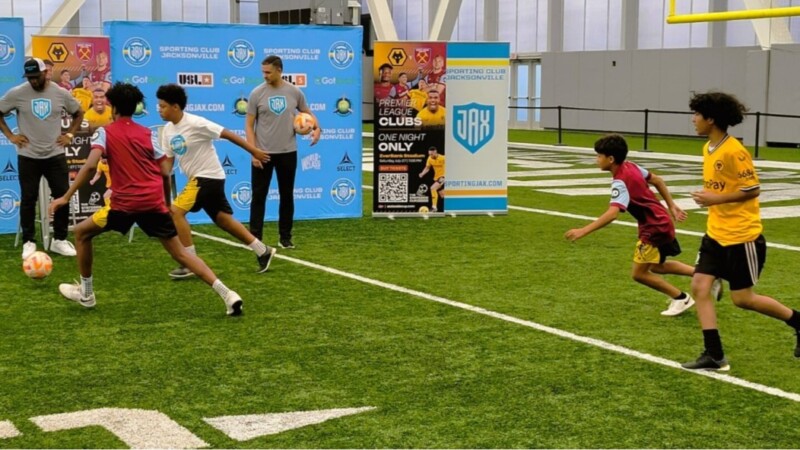
Kids’ soccer camp offered before Jags game on Oct. 6
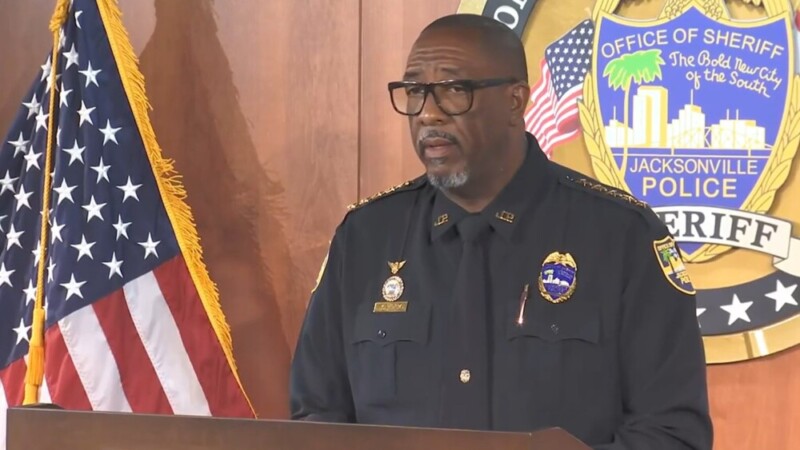
Veteran Jacksonville police officer charged with kidnapping, stalking woman

Douglas Anderson hired teacher after state said he was drunk at previous school — now he’s removed for alleged misconduct
“I don’t do this lightly. This is not a light thing for me. You heard the ages of the kids,” Waters said. “Do not, under any circumstance, in any school, charter school, online, make a threat to shoot up our schools. We are not going to sit back and allow you to make that threat. We are going to act on it.”
Two non-charter public school students were also arrested on Tuesday by school district police on charges of making threats against their schools, Superintendent Chris Bernier said.
One is a 13-year-old student at the Young Men and Young Women Leadership Academy at Eugene Butler Middle School, according to the arrest report. The student was charged with making false reports on acts on public property, making false 911 calls and disrupting a school function, the report said.
Officers were called to the school on Tuesday after calls came in reporting a student stabbed with a pencil, a bomb threat and someone with a gun, forcing a lockdown until investigation revealed they were all false, the report said. The investigation revealed that a student had an argument with a teacher in a room with a telephone, and the threat calls were traced to that room, the report said.
The other student is a 16-year-old Mandarin High School student who was charged on Tuesday with making threats, his arrest report said. The arrest came after two students reported hearing someone say they would bring a gun to school and shoot 20 people, the report said.
The superintendent asked parents to have “difficult conversations” with their children.
“There are certain things that you should never say in an airport as you approach security,” he said. “And similarly, you should never write or state a threat to harm a school, student or person in our community.”
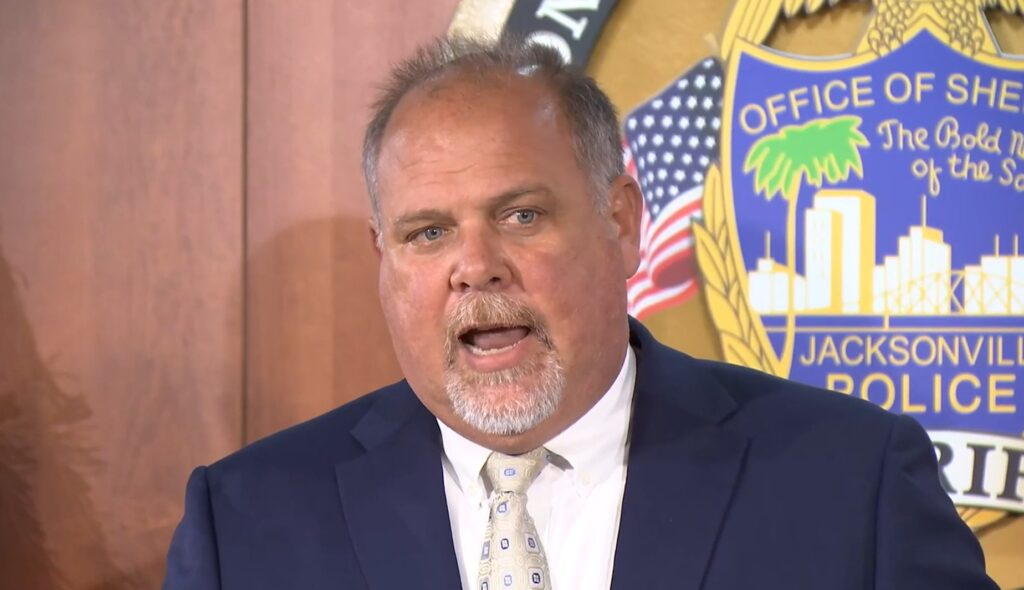
A number of threats have been made against schools nationwide in the week after the deadly Sept. 4 mass shooting at Apalachee High School in Barrow County, Georgia, outside Atlanta.
Colt Gray, 14, was charged in the deaths of two students and two teachers and shootings of several others there. His father, Colin Gray, also faces second-degree murder charges for providing his son with a semi-automatic rifle, police said.
A day after the Barrow County mass shooting, a Florida teen was charged after a threat came in to shoot up a school, which was reported to the National Alliance on Mental Illness’ emergency and suicide prevention line. Hotline staff contacted the Jacksonville Sheriff’s Office, and an investigation led to Polk County’s George Jenkins High School in Lakeland. That’s where deputies found a 16-year-old football player lifting weights at the school and arrested and charged him with making a false report concerning the use of a firearm.
Waters said he does not believe the Duval County threats were copycats of any other incidents, but police are “paying very close attention” to the fact that the five happened in a short amount of time.
“People understand that you are not supposed to do that. We are letting them know that we are not going to sit back, we are not going to take it,” Waters said. “We see what happens around the country, and what just happened in Georgia. We don’t want it happening in Jacksonville.”
Waters said his department has a zero tolerance policy on those making threats against schools and will arrest “no matter if the perpetrator is 90 or 10.” And he said it does not matter if the threats were made online or paper, out loud or via text messaging.
And if a threat rises to the level of a crime, Bernier said the school district will “absolutely pursue criminal consequences as well.”
“These consequences are life changing but necessary in order to protect the health and safety of all of our employees, and all of our students,” Bernier said. “Academics is always our primary goal, but students cannot learn if they don’t feel safe.”
Waters and Bernier were joined by Chief Assistant State Attorney Adair Newman and School Police Chief Jackson Short to announce the recent arrests.
“Making threats, even if it is in jest, can have serious consequences,” the Florida Department of Juvenile Justice states. “Youth, parents, and teachers are also encouraged to report any and all threats they see or hear. They can notify law enforcement or report a threat anonymously through Florida’s FortifyFL App .”

Keep Reading
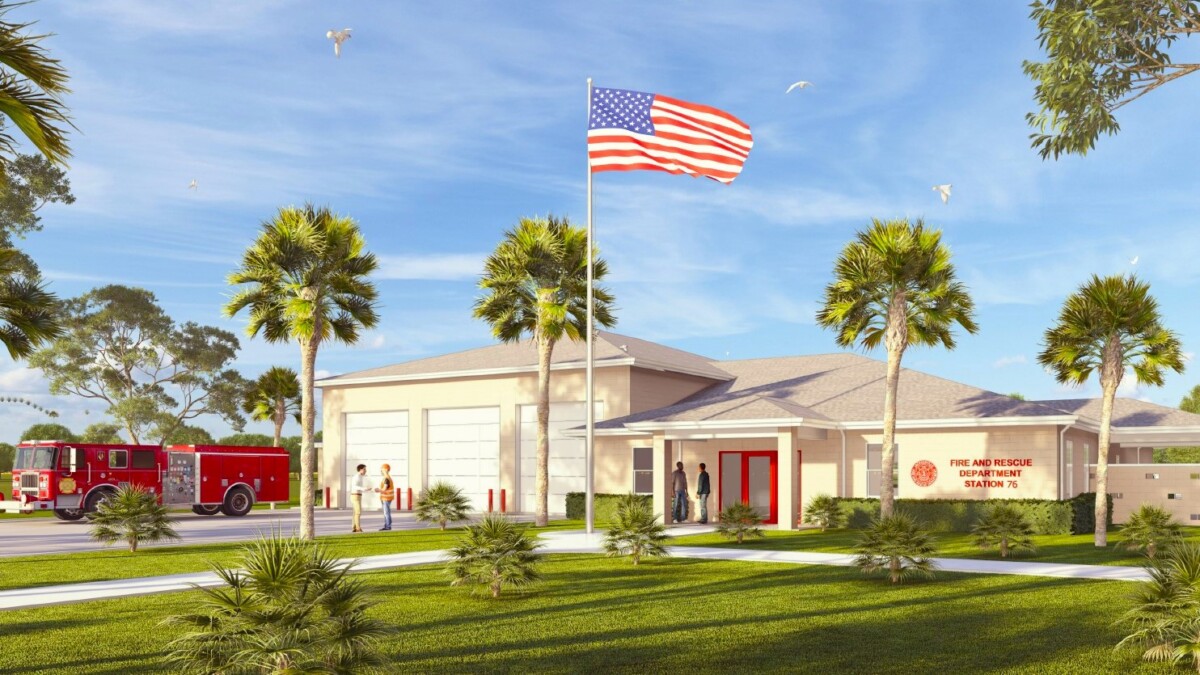
By Dan Scanlan
Ground was broken on Fire Station 76, which will replace a temporary station in Northeast Jacksonville.
Sign up for the Jacksonville Today newsletter
Share on mastodon.
In This Section
Coronado fire science academy, lunch & learn events, susd students - 10/02/2024, out-of-district students.
This CTE program prepares students for emergency services careers.
Enroll and earn industry certifications in: HazMat, Wildland Firefighting, EMT, Firefighter I & II.
10th & 11th Grade Students
JOIN US: October 2, 2024 11:45 am – 12:35 pm Coronado HS Lecture Hall
Click Here for More Information
Information Coming Soon
Coronado High School is excited to announce the launch of the Fire Science Academy on its campus, beginning in the 2025-2026 school year.
This innovative program is a collaborative effort between the Scottsdale Unified School District (SUSD), the East Valley Institute of Technology (EVIT), the Scottsdale Fire Department, and the Scottsdale Charros, and is designed to provide students with hands-on experience and training in fire science and emergency medical services.
This EVIT Fire Science Academy will be housed at Coronado High School and will be open to students across SUSD, as well as those from surrounding areas. Students enrolled in the program will have the unique opportunity to earn industry certifications in areas such as HazMat, Wildland Firefighting, EMT, and Firefighter I and II.
The program is tailored for juniors and seniors, offering a morning block of intensive, hands-on learning experiences that prepare students to be competitive candidates for fire departments and emergency services careers.
“This partnership with EVIT, Scottsdale Fire, and the Charros is a testament to our commitment to provide exceptional educational opportunities for our students and prepare them post-secondary success,” said Melinda Splitek, Coronado High School Principal. “The Fire Science Academy not only equips students with valuable skills and certifications but also connects them with mentors and professionals in the field, setting them on a path to success.”
The Fire Science Academy’s curriculum combines traditional classroom instruction with practical training, including running hoses, placing ladders, and other critical firefighting skills. As part of this unique program, students will have direct access to mentorship from Scottsdale Fire Department personnel, who will guide them through the rigorous demands of the profession and help them build a network of industry contacts.
Fire Science Presentation
Scottsdale Fire Department
East Valley Institute of Technology
Scottsdale Charros

IMAGES
VIDEO
COMMENTS
Here at Powerful Youth, we believe that EVERY youth is powerful and has the power to make change in their community! Our leadership lesson plans are designed for middle-to-high school students ages 12-18 anywhere in the world, and can be delivered by a group leader, facilitator, or educator. We have led over 50 leadership workshops in ...
A collection of 5 powerful TED Talks on leadership to help group leaders better not only themselves, but their students as well. Demonstrating good leadership, especially for impressionable students, requires more than just an understanding of strategizing.
Teaching leadership can be tricky. At the secondary school level, most student leadership "development" programs are in fact only education (academic theory) or training (practical application). Rarely do high schools have the resources to effectively combine the two into true experiential learning.
Kids will laugh, but this is one of those leadership TED talks where the laughter leads to a lesson. Stanley McChrystal: Listen, Learn …. Then Lead. General Stanley McChrystal is a decorated four-star general, making him a great source for advice on leadership. McChrystal shares an essential value of leadership: Don't be too proud or full ...
The dynamic duo, Jose Alvarez & Asley Pollas - Top High School Student Speakers - are your most sought after leadership keynote speakers for high schools, co...
Here's a guide for learning more about leadership and developing strategies to change the world—or at least get started. *As part of our ongoing work to #ReThinkHighSchool and prepare our students for the 21st century, we decided to create a series of long-form posts that seek to elucidate the college and career process for high school ...
Download the Leadership Development Program for Business presentation for PowerPoint or Google Slides and start impressing your audience with a creative and original design. Slidesgo templates like this one here offer the possibility to convey a concept, idea or topic in a clear, concise and visual way, by using different... Multi-purpose.
8. Creative Projects. Leading a creative project, such as a school play, art exhibition, or literary magazine, showcases a student's ability to manage diverse tasks, from organizing auditions to curating submissions. This type of leadership involves inspiring creativity, ensuring collaboration, and meeting deadlines.
7.Debate Club: Participate in a debate club to hone persuasive communication skills and develop critical thinking abilities. 8.Leadership Books and Discussions: Form a book club to read and discuss books about leadership or influential leaders from various fields. 9.Group Presentations: Encourage students to work together on group presentations ...
8. Students lead after school program. If students have a particular interest in a topic or hobby encourage them to run activities for students in an after-school program who might show interest in the topic as well. It's as easy as an announcement on the intercom and a sign-up sheet of paper for those who are interested too.
Here are some interesting activities for high school students to develop leadership. 1. Brainstorming for change (Stapleton, 2018) The teacher puts students into groups of 4 or 5. The goal is for students to come up with possible solutions to social, political or economic problems. Working together, students brainstorm both small- and large ...
The principle of leadership and mission. The principle of managing time and priorities around roles and goals. The principle of seeking mutual benefit. The principle of empathetic communication. The principle of creative cooperation. The principle of continuous improvement.
School Leadership in 12 slides. Last week I was asked to lead a workshop on leadership for some middle and senior leaders. Here are some of the ideas I shared. Believe me, I'm not preaching from on high. I've had some successes but there isn't a day that goes by when I don't run through some kind of imagined re-run of my last job where ...
11 Leadership Presentation Ideas for Team Training. Leadership development topics equip aspiring leaders with the skills and tactics necessary for effective management. These topics for leadership presentations help leaders understand their roles and view challenges as opportunities for growth. Training provides insights into team expectations ...
Building Student Leadership. An Image/Link below is provided (as is) to download presentation Download Policy: Content on the Website is provided to you AS IS for your information and personal use and may not be sold / licensed / shared on other websites without getting consent from its author. Download presentation by click this link.
With vibrant visuals and engaging content, these presentations facilitate interactive learning experiences, making it easy for educators and trainers to adapt the material to their specific audience and objectives.These modules are perfect for various use cases, including high school and college leadership programs, student government training ...
3. They are hardworking. Working hard is contagious. If one student is persevering and showing a true passion for the subject, that student will inspire others to believe that they, too, can (and should) strive for excellence. In short, hardworking student leaders inspire and push their classmates to do more.
11. Language Exchange Program. Establish a program where students can learn and exchange languages, fostering cultural exchange and language development in a fun way. 12. Entrepreneurship Fair. Organize a fair where students can showcase their entrepreneurial ideas and products, fostering creativity and business skills.
Eligibility: Open to high school students in the Boston area. 5. Sadie Nash Leadership Project. The Sadie Nash Leadership Project's Summer Institute is designed as an empowering five-week summer program designed for high school women and gender-expansive youth, focusing on leadership, social justice, and activism.
Here are 10 different leadership activities for high school students to get involved in! 1. Run for Student Government / Class Council. Also referred to as student government or governing council, high school class councils are front-facing, amazing ways to become involved as a leader within your school environment.
About This Presentation. Title: Student Leadership. Description: To look at the Student Leadership programme (developed through London Challenge) ... Understanding self and others' co-developed (Haringey) and piloted (Hackney) ... - PowerPoint PPT presentation. Number of Views: 6170. Avg rating:3.0/5.0.
Five Central High School students were recently named as part of the Angelina County Chamber of Commerce's Leadership Tomorrow Class. Vanessa Sanchez, Natalie Purvis, Ethan Basham, Landree Hamilton and Taylor Finch are the students who have earned the leadership honor ...
A high school in Florida was placed under lockdown after a student was found with a gun on campus on September 11, according to the school district. Local news outlet FOX35 reported that the Lake ...
Two non-charter public school students were also arrested on Tuesday by school district police on charges of making threats against their schools, Superintendent Chris Bernier said. One is a 13-year-old student at the Young Men and Young Women Leadership Academy at Eugene Butler Middle School, according to the arrest report.
These students have put themselves forward to serve their fellow peers in these roles. The House Captains have significant roles to play at Plumpton High School as they continue to lead and expand the House system of the school promoting student engagement, school spirit and sense of belonging through the projects they develop and implement.
Coronado High School is excited to announce the launch of the Fire Science Academy on its campus, beginning in the 2025-2026 school year. This innovative program is a collaborative effort between the Scottsdale Unified School District (SUSD), the East Valley Institute of Technology (EVIT), the Scottsdale Fire Department, and the Scottsdale Charros, and is designed to provide students with ...
A memorial is seen at Apalachee High School after a school shooting on Sept. 4, 2024, in Winder, Georgia. Senior Republicans have proposed tighter measures to protect students but Democrats say it ...